Introduction
In the rapidly evolving landscape of automation, understanding the nuances of the Gartner Magic Quadrant is essential for organizations seeking to enhance their operational efficiency. This framework not only provides a visual representation of market dynamics but also categorizes vendors into distinct groups, offering a strategic lens through which to evaluate potential partners in Robotic Process Automation (RPA) and Business Intelligence.
As organizations navigate the complexities of selecting the right RPA solutions, insights from recent reports and case studies reveal the transformative potential of automation, demonstrating significant improvements in workflow efficiency and error reduction.
By leveraging these insights, stakeholders can make informed decisions that align with their unique operational challenges and long-term goals, ultimately driving productivity and innovation in their organizations.
Understanding the Gartner Magic Quadrant: An Overview
The RPA Magic Quadrant 2023 serves as a pivotal research methodology that offers a visual representation of a market’s trajectory, maturity, and key players. It systematically evaluates vendors based on their execution capabilities and the completeness of their vision, categorizing them into four distinct groups: Leaders, Challengers, Visionaries, and Niche Players. This structured method enables companies to efficiently determine which vendors correspond best with their unique challenges and business objectives, especially in the context of the RPA Magic Quadrant 2023 and Business Intelligence.
As Kim Manis, Vice President of Product Management, emphasizes,
The last year has been a truly exciting period of innovation with hundreds of features and enhancements that assist us in more effectively empowering every individual and team who wishes to derive greater value from their data.
The most recent update of the Warehouse Management Systems Magic Quadrant, published on 5/2/24, further highlights the changing nature of the market and the significance of utilizing current insights for efficiency. Moreover, the case study titled ‘Streamlining Operations with GUI Automation’ illustrates how a mid-sized company faced challenges such as manual data entry errors and slow software testing, ultimately achieving a 70% reduction in errors and an 80% improvement in workflow efficiency through RPA.
By engaging with the insights provided through the RPA Magic Quadrant 2023, stakeholders can make informed decisions regarding RPA vendors, ensuring that their selections are strategic and beneficial to their operations. It is also important to note that by clicking ‘Submit’, users agree to Gartner’s Terms of Use and Privacy Policy, an essential consideration for those engaging with the Magic Quadrant. Staying updated with the latest trends and insights, such as those indicated in the forthcoming Critical Capabilities for Warehouse Management Systems report scheduled for 7/27/23, enhances the decision-making process further.
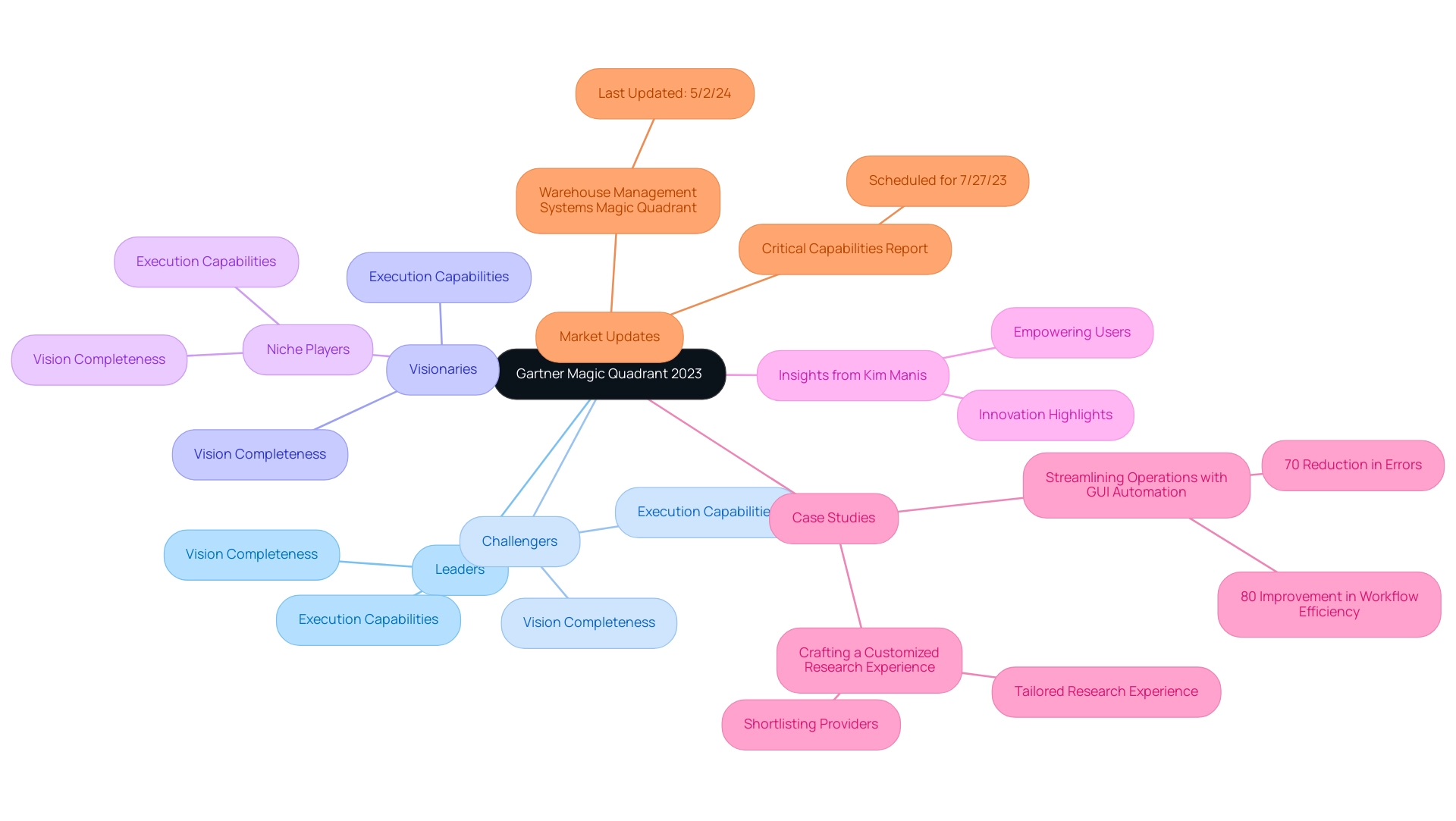
Key Insights from the 2023 RPA Magic Quadrant: Leaders and Challengers
The RPA Magic Quadrant 2023 highlights established leaders recognized for their comprehensive capabilities and proven execution in the field of Robotic Process Automation (RPA). These vendors, including UiPath and Automation Anywhere, provide robust frameworks and extensive support systems, making them ideal partners for entities seeking to automate manual workflows and enhance operational efficiency while reducing costs and increasing productivity. UiPath holds a market share of 30%, while Automation Anywhere closely trails with 25%, due to their impressive feature sets that attract businesses seeking dependable services.
Moreover, RPA can significantly reduce errors by automating repetitive tasks, allowing teams to focus on more strategic, value-adding work. Additionally, challengers like Cyclone Robotics, although not as feature-rich, are proving their worth through remarkable innovation and experimentation. Cyclone Robotics’ ascent from a Niche Player to the only Challenger in the RPA Magic Quadrant 2023 underscores its adaptability and competitive edge.
This rapid evolution enables them to offer customized solutions at potentially reduced costs, presenting unique benefits for entities with specific needs. As Kevin Kimes, Senior Analyst Relations Manager at UiPath, aptly notes, ‘They also demonstrate an incredible ability to innovate and experiment,’ which speaks to the potential value these challengers can offer. Gartner emphasizes that challengers possess this innovative capacity, reinforcing the importance of considering their offerings.
Grasping these dynamics is crucial for entities to choose partners who not only satisfy immediate automation needs but also correspond with long-term strategic goals, ultimately utilizing RPA and Business Intelligence to foster data-driven insights, excellence in operations, and increased productivity.

Analyzing the Visionaries and Niche Players in the 2023 RPA Magic Quadrant
The RPA Magic Quadrant 2023 categorizes Visionaries as vendors that demonstrate exceptional innovation and unique solutions, although they may have some limitations in scalability or proven track records compared to industry leaders. For example, EMMA RPA offers revolutionary capabilities aimed at improving efficiency and employee morale, addressing common challenges like staffing shortages and outdated systems. Similarly, Microsoft Power Automate enables businesses to transform their operations, showcasing how Visionary vendors can effectively meet specific operational challenges.
A notable insight from Gartner predicts that by 2025, 90% of RPA vendors will incorporate generative-AI automation, highlighting the innovative trajectory within the industry. In contrast, Niche Players often focus on specific industries, such as healthcare or finance, providing tailored solutions that respond directly to the unique demands of these sectors. As companies explore their RPA options, it’s crucial to thoroughly evaluate these vendors, particularly given the RPA Magic Quadrant 2023 report indicating minimal shifts, where most Leaders maintained their positions while Cyclone Robotics advanced to Challenger status.
This competitive landscape underscores the importance of assessing innovative features that align closely with operational challenges, ultimately driving enhanced productivity and operational efficiency. To further explore how these solutions can benefit your company, book a free consultation today. Additionally, consider the visual representation of RPA integration in the workplace, as illustrated by a human collaborating with robotic figures, emphasizing the synergy between technology and human effort.

Evaluating Vendor Capabilities: Key Features to Consider
When choosing RPA providers, it’s vital to assess several key characteristics that can greatly impact the success of these initiatives as outlined in the RPA Magic Quadrant 2023. First and foremost, ease of use is critical; a user-friendly interface fosters quick adoption among team members, reducing the learning curve associated with new technology. Additionally, robust integration capabilities with existing systems are paramount, ensuring that the RPA solution can seamlessly connect with your enterprise’s current technology stack.
This adaptability is especially crucial as organizations frequently encounter challenges arising from outdated systems that impede productivity and innovation, with over 90% of C-level executives believing their organizations handle change efficiently.
Scalability is another essential factor, particularly for organizations expecting growth or heightened technological requirements. A scalable RPA solution enables businesses to grow their initiatives without the hassle of changing vendors, ensuring continuity and efficiency in operations while addressing staffing shortages. Furthermore, strong support services can play a pivotal role in the success of RPA implementation, providing essential training and assistance during the transition period to combat the exhaustion and morale issues associated with repetitive tasks.
In 2023, the development of low-code RPA platforms is democratizing process management, allowing non-technical business users to design workflow processes with minimal coding skills. This trend towards accessibility in technological advancements is crucial for entities seeking to enhance productivity through tailored AI solutions and Business Intelligence. Notably, this shift is expected to contribute to the 61% of RPA users who reported successful cost reductions, emphasizing the importance of selecting the right vendor to achieve cost efficiency.
Moreover, RPA’s capability to handle up to 90% of data entry tasks in clinical research underscores the effectiveness of these solutions in specific industries. As you explore the realm of RPA solutions, keeping in mind the RPA Magic Quadrant 2023 and essential characteristics such as the need to upgrade obsolete systems and tackle talent retention issues will enable your entity to leverage the full capabilities of technology, ultimately enhancing efficiency and reducing costs.

Implementation Best Practices for RPA Solutions
To drive successful RPA implementation, organizations must commence with a well-defined strategy that articulates specific goals and anticipated outcomes. Engaging stakeholders from various departments early in the process is crucial; doing so fosters a collection of diverse perspectives and secures essential buy-in. It’s vital to pinpoint processes ripe for automation—these are often repetitive, rule-based tasks that consume considerable time.
A recent study suggests that:
- 91% of employees believe that technology improves their work-life balance
- 89% noting heightened job satisfaction as a direct outcome
Moreover, mechanization enables workers to save an average of 3.6 hours per week, further reinforcing its value. Our promise is clear: you only pay if we deliver the promised process automation, effectively taking the ROI risk on your behalf because we are confident in our delivery.
Together, we will:
- Access a process of yours that you would like to automate
- Calculate the efforts it takes to automate that process
- Estimate the time savings you will see after the project
- Automate the process with the help of certified professionals on our side
To facilitate this transition, investing in employee training is imperative. Equipping team members with the knowledge to leverage new technologies ensures that RPA is viewed as a tool to augment their roles rather than a threat.
Lastly, establishing metrics to evaluate the RPA solution’s performance post-implementation allows entities to pursue continuous improvement and optimization. As Tajammul Pangarkar, CMO at Prudour Pvt Ltd, notes, successful RPA adoption hinges on strategic engagement with all stakeholders involved, reflecting their insights and concerns throughout the project lifecycle. With 53% of companies now implementing RPA and 78% of users anticipating further investment over the next three years, the time to act is now.
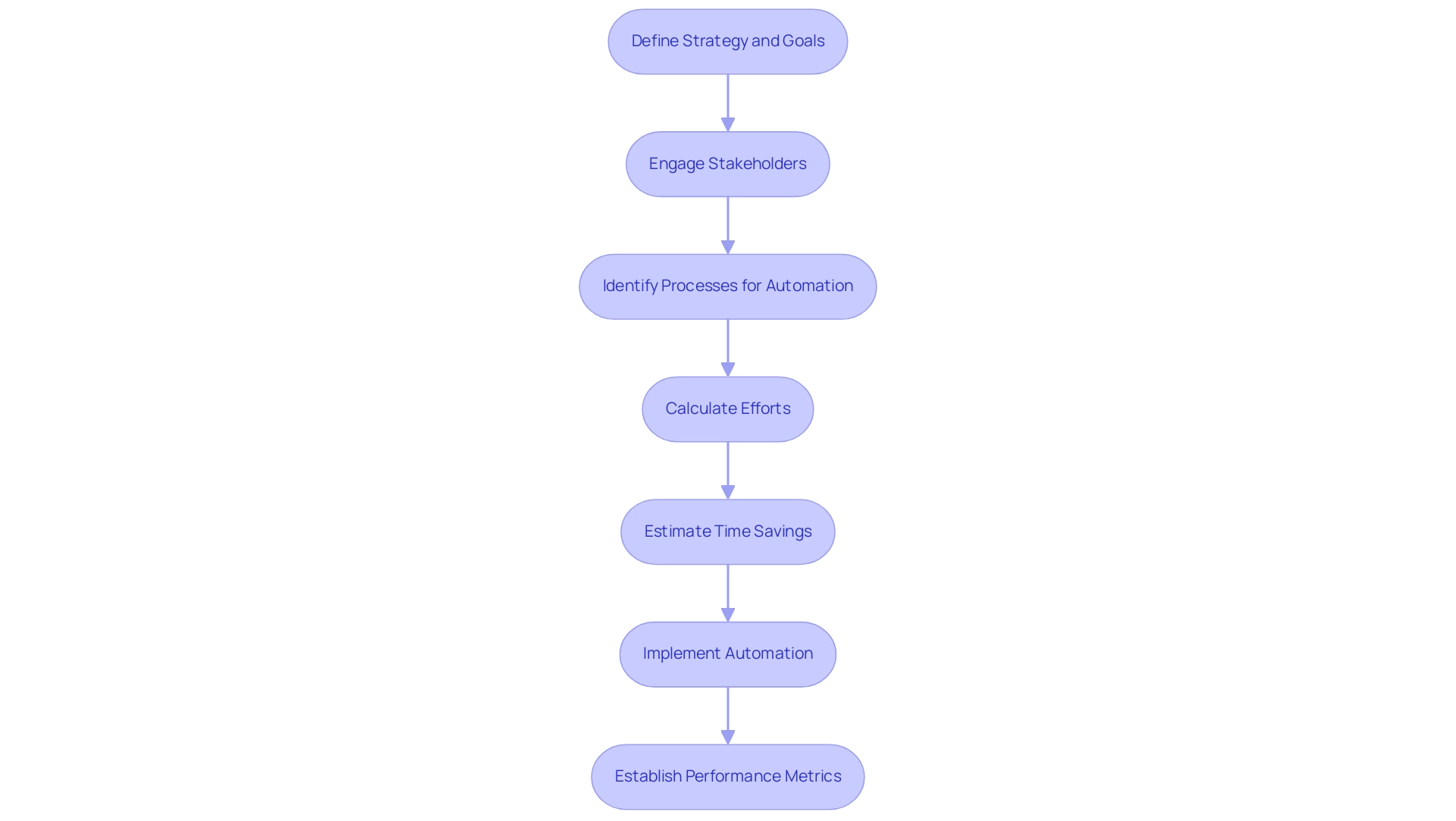
Measuring Success and ROI of RPA Implementations
To effectively assess the success of RPA implementations, organizations must establish clear key performance indicators (KPIs) such as time savings, cost reductions, and error rates both prior to and after the implementation. This is particularly vital in addressing common workplace challenges like:
- Repetitive tasks that drain employee morale
- Staffing shortages that hinder operational capacity
- Outdated systems that stifle innovation, leading to inefficiencies and increased operational costs
A relevant example arises from an Icelandic healthcare organization, which successfully lowered its overall yearly total cost expenses by over $75,000 through strategic mechanization.
Moreover, a client in the finance sector achieved an astonishing 300,000% ROI from a single RPA implementation, highlighting the potential returns that can be realized. To calculate the ROI, organizations should compare the costs associated with implementing RPA against the financial benefits derived from enhanced efficiency and productivity. Furthermore, evaluating the reliability of automated systems is essential; this can be achieved by comparing downtimes and disruptions before and after the implementation of these systems, illustrating how such processes lead to reduced errors and enhanced operational quality.
For instance, the mid-sized company that implemented GUI automation:
- Reduced data entry errors by 70%
- Accelerated testing processes by 50%
- Improved workflow efficiency by 80%
Tracking user satisfaction and engagement is essential to assess how well employees are adapting to the new automated processes. Regularly reviewing these metrics ensures that the RPA solutions are achieving their intended results.
As Bart Teodorczuk, RPA Tech Lead at Flobotics, emphasizes, ‘Our team, sourced only from the ‘Big Four’ of accounting, will analyze your processes and current RPA setup and recommend the metrics and KPIs to measure best suited for your business goals and needs.’ This proactive approach enables entities to make necessary adjustments to optimize performance continually. The success of RPA not only lies in deployment but also in ongoing measurement and adaptation.
Specific KPIs that organizations might consider include:
- Process cycle time
- First-pass yield
- Operational cost savings
This provides a comprehensive framework for evaluating RPA performance and enhancing operational efficiency.
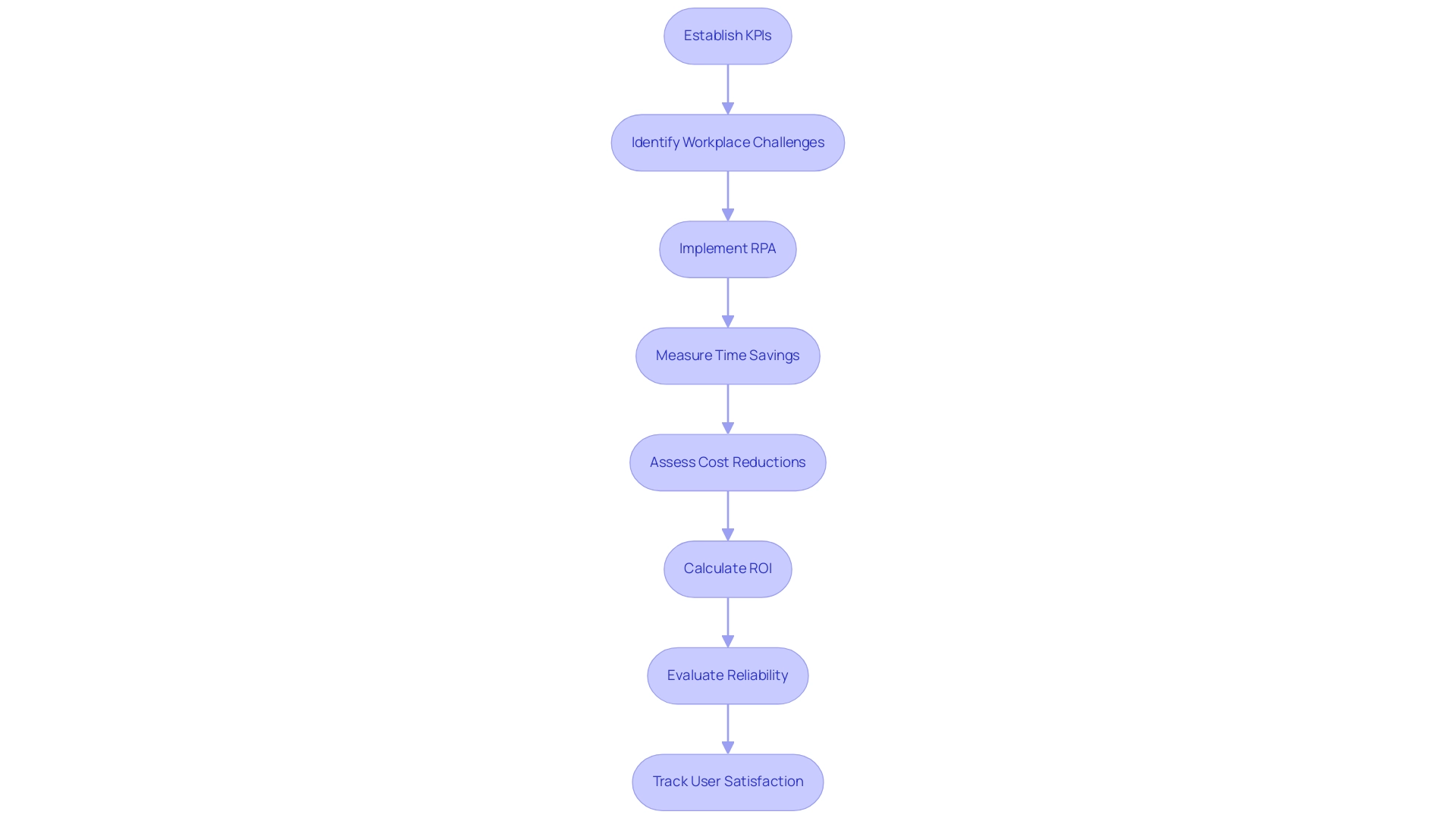
Conclusion
In the landscape of Robotic Process Automation (RPA) and Business Intelligence, leveraging the insights from the Gartner Magic Quadrant is crucial for organizations aiming to enhance operational efficiency. The framework categorizes vendors into Leaders, Challengers, Visionaries, and Niche Players, providing a strategic perspective to help organizations identify partners that align with their unique operational challenges and goals. The transformative potential of automation is evident in the case studies presented, showcasing significant improvements in workflow efficiency and error reduction.
As organizations evaluate RPA vendors, key features such as:
- Ease of use
- Robust integration capabilities
- Scalability
must be prioritized. These elements not only facilitate smooth implementation but also ensure that the chosen solutions can adapt to evolving needs. Furthermore, engaging stakeholders early in the implementation process and establishing clear performance metrics are essential practices that drive successful RPA adoption. By focusing on strategic engagement and continuous improvement, organizations can fully harness the benefits of automation, leading to enhanced productivity and significant cost savings.
Ultimately, the successful integration of RPA solutions can redefine operational landscapes, empowering employees to focus on strategic tasks while leaving repetitive processes to automation. With the right vendor partnerships and a commitment to ongoing evaluation, organizations are well-positioned to navigate the complexities of the automation journey, driving innovation and operational excellence in their respective fields. The time to act is now—embracing automation not only addresses immediate operational challenges but also paves the way for sustainable growth and enhanced competitiveness in the future.
Introduction
As the landscape of artificial intelligence continues to evolve, organizations are presented with both unprecedented opportunities and significant challenges. Microsoft’s President Brad Smith emphasizes a thoughtful approach towards the development of superintelligent AI, urging businesses to balance innovation with ethical considerations. This perspective aligns with a growing recognition of the need for responsible AI practices, particularly as companies grapple with implementation hurdles and the complexities of integrating AI into existing workflows.
With a notable increase in the adoption of generative AI and Robotic Process Automation (RPA), organizations are beginning to harness the power of these technologies to enhance operational efficiency and productivity. As the demand for AI solutions surges, understanding how to navigate the intricacies of implementation while fostering a culture of responsibility becomes paramount for future success.
This article delves into the current state of AI, highlights practical strategies for effective implementation, and explores the ethical frameworks necessary to ensure that AI technologies serve not only businesses but the broader community as well.
Microsoft’s Perspective on the Timeline for Superintelligent AI
Microsoft President Brad Smith has articulated a measured perspective on the emergence of superintelligent AI, indicating that there is no chance of it becoming a reality soon. His cautious approach underscores the complexities that still need to be navigated in AI development. Smith’s insights resonate with a broader industry sentiment that advocates for responsible AI innovation, emphasizing the need to balance technological advancements with ethical considerations.
This balanced viewpoint empowers entities to focus on the powerful capabilities of current AI technologies while addressing implementation challenges, including data quality issues and the reluctance to integrate AI into existing processes. Numerous entities perceive AI projects as time-intensive, costly, and challenging to implement, which can deter adoption. However, with 878 respondents indicating the use of generative AI in at least one function, entities are beginning to see tangible improvements in their operations.
For instance, the FDA’s approval of 139 AI-related medical devices in 2022—a 12.1% increase from 2021—demonstrates the growing acceptance and integration of AI in healthcare. Furthermore, as projections indicate that by 2025, 50% of knowledge workers will employ virtual assistants, and with 54% of users agreeing that virtual personal assistants make their lives easier, the time is ripe for businesses to adopt existing AI solutions that enhance operational efficiency and productivity, particularly through automation. Before implementing GUI automation, companies faced significant challenges such as manual data entry errors, slow software testing, and difficulty integrating outdated systems without APIs.
As highlighted in recent case studies, GUI automation has proven effective in streamlining operations, reducing errors, and significantly improving workflow efficiency. This is a pivotal moment for entities to leverage these advanced tools rather than getting distracted by the speculative timeline of Microsoft no chance superintelligent soon.
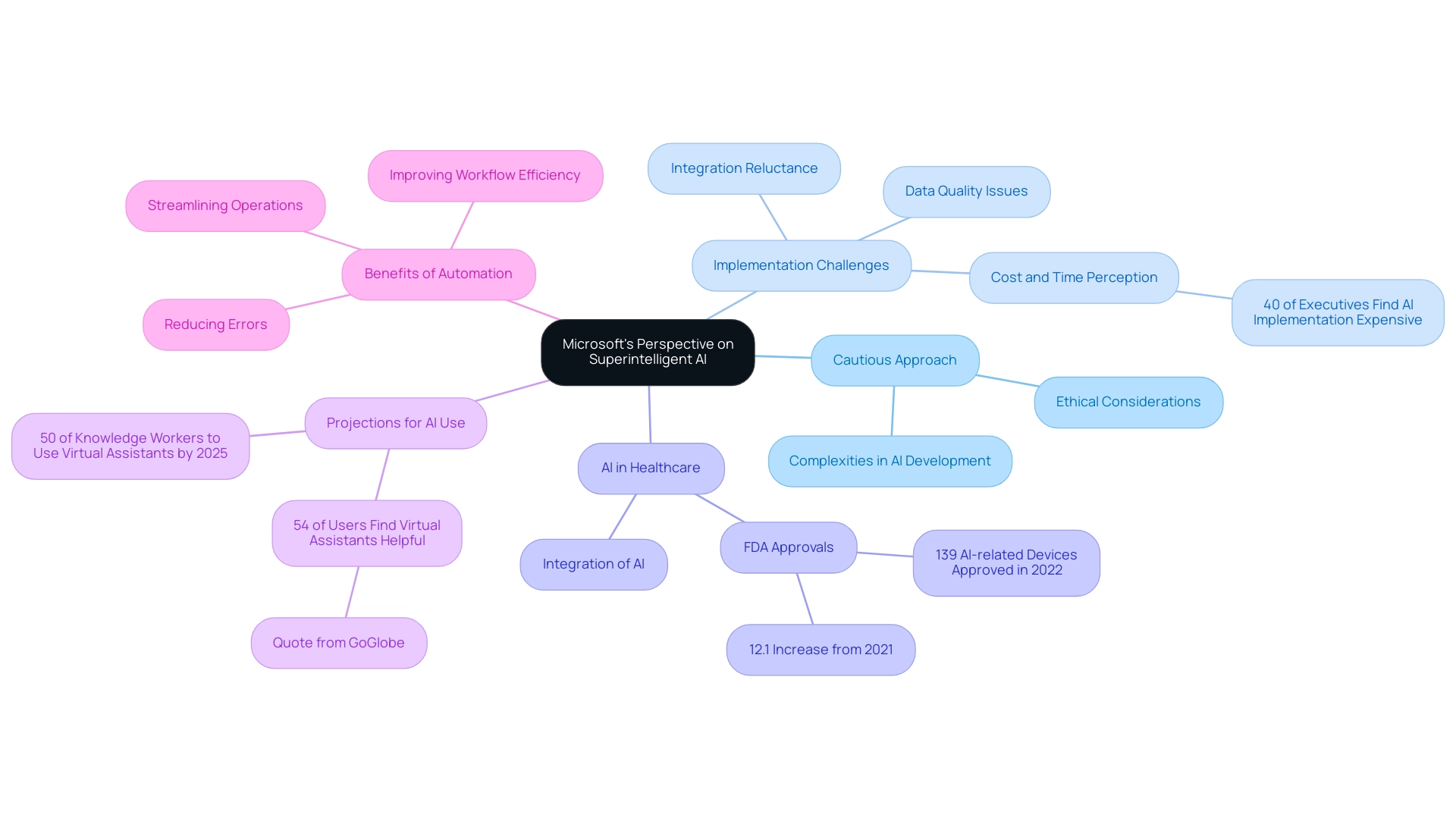
Challenges and Limitations in Achieving Superintelligent AI
The pursuit of superintelligent AI is riddled with considerable challenges and inherent limitations, which means Microsoft has no chance superintelligent soon. Developing algorithms that can learn and adapt beyond human intelligence is an intricate endeavor, marked by the need for transparency and accountability, particularly as 80% of customers believe a human touch is essential in validating AI outputs. This statistic underscores the critical demand for responsible stewardship in AI applications, where transparency and accountability are paramount.
To address implementation challenges and improve operational efficiency, businesses can utilize Robotic Process Automation (RPA) tools like EMMA RPA and Microsoft Power Automate. EMMA RPA automates repetitive tasks, significantly reducing errors and freeing up teams for more strategic, value-adding work. Microsoft Power Automate integrates seamlessly with existing systems, allowing for easy automation of workflows across various applications, thus improving employee morale by alleviating task repetition fatigue.
As entities strive to innovate, they must confront the pressing ethical considerations that accompany such advancements, including the removal of biases in algorithms. A pivotal concern is the quality of data utilized in AI training; without access to vast amounts of accurate information, the efficacy of AI systems is compromised. Additionally, a Forbes Advisor survey showed that 77% of consumers convey concern regarding possible AI-related job losses, emphasizing the societal impacts of these advancements and the necessity for measures such as re-skilling and job transition assistance to alleviate these worries.
As Justin Mauldin aptly states, as AI continues to advance at an unprecedented pace, it’s crucial to address the key challenges and ethical considerations that surround its development, particularly as Microsoft has no chance superintelligent soon becomes a reality. By recognizing these complex challenges, including possible obstacles to AI implementation, and dedication to ethical practices, while employing customized AI approaches, organizations can not only enhance efficiency and innovation but also guarantee that the shift to AI methods is both responsible and advantageous to the workforce.
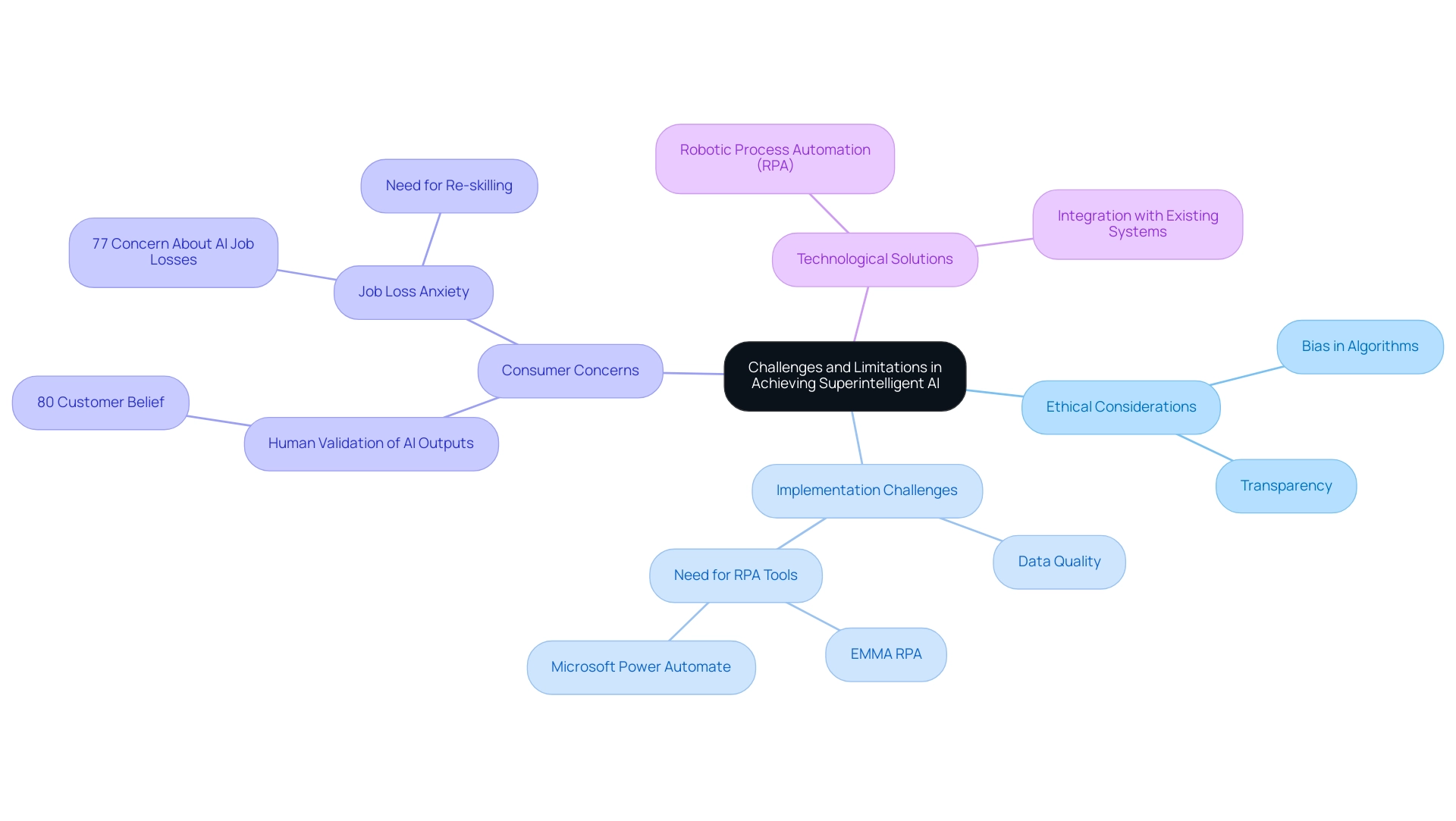
The Importance of Responsible AI Development
The evolution of artificial intelligence underscores an urgent need for responsible AI development. Organizations should prioritize establishing ethical frameworks that emphasize transparency, fairness, and accountability. By aligning with emerging regulatory standards and actively engaging stakeholders, organizations can ensure that AI technologies, including generative AI and Robotic Process Automation (RPA), are beneficial to the broader community.
This commitment to responsibility fosters trust in AI solutions, effectively mitigating risks associated with bias and misuse. Significantly, a recent survey indicated that 30% of company owners expect AI to take on the role of generating website copy, illustrating the growing reliance on AI systems. Furthermore, with over 4 billion voice assistants currently in use and projections to reach 8.4 billion by 2024, it is evident that voice assistants are rapidly integrating into daily life, outpacing human population growth.
By cultivating a culture of responsibility and ethical implementation, along with providing hands-on training and integration strategies, entities not only adhere to standards but also position themselves as pioneers in the responsible deployment of AI technologies. Our GenAI workshops specifically enhance personalized customer experiences by teaching businesses how to effectively utilize AI-powered chatbots and recommendation systems. As McKinsey aptly states, ‘Technology’s generational moment with generative AI: A CIO and CTO guide.’
Such proactive measures are essential as we approach 2024, where the emphasis on ethical frameworks for AI transparency and accountability will be paramount. We invite you to book a free consultation to explore how our tailored AI solutions can empower your entity.
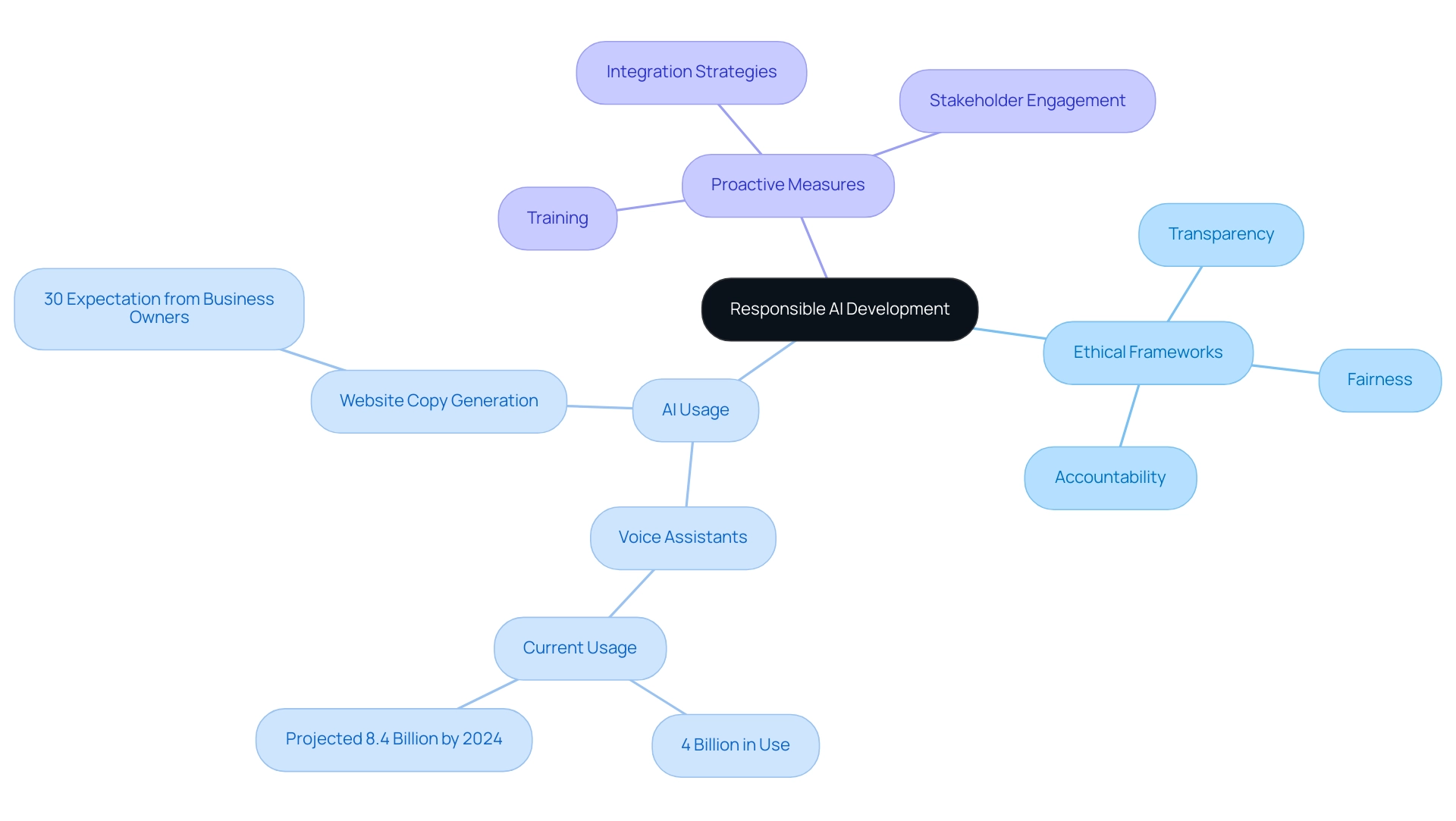
Practical Steps for Organizations to Enhance AI Implementation
To effectively enhance AI implementation and operational efficiency, organizations can adopt several practical strategies. A comprehensive assessment of existing processes is crucial, as it helps pinpoint areas where Robotic Process Automation (RPA) can streamline workflows, reduce errors, and free up team resources, generating significant value. For instance, the expectation that 30% of entrepreneurs foresee AI generating website copy for their companies illustrates the potential for efficiency gains.
Furthermore, investing in robust training programs for employees is essential; such initiatives not only foster a culture of innovation but also minimize resistance to change, particularly among the 68% of non-users from the Gen X and Baby Boomer demographics. Tailored training programs can specifically address their concerns, facilitating smoother adoption of both AI and RPA technologies. Working together with AI specialists guarantees that approaches are aligned with specific business goals, maximizing the effectiveness of initiatives aimed at enhancing business productivity.
Additionally, leveraging Business Intelligence is vital for transforming raw data into actionable insights, enabling informed decision-making that drives growth and innovation. Establishing clear metrics to evaluate the performance and impact of these solutions is also crucial for facilitating continuous improvement. The case study on AI usage by age highlights that while 30.8% of individuals aged 61+ use virtual assistants weekly, over 80% of those aged 18-25 have never utilized a large language model, illustrating the differing adoption rates of AI innovations across demographics.
By embracing these steps and leveraging RPA and Business Intelligence, entities can adeptly navigate the complexities of technology implementation, ultimately driving operational efficiency and positioning themselves for future success.
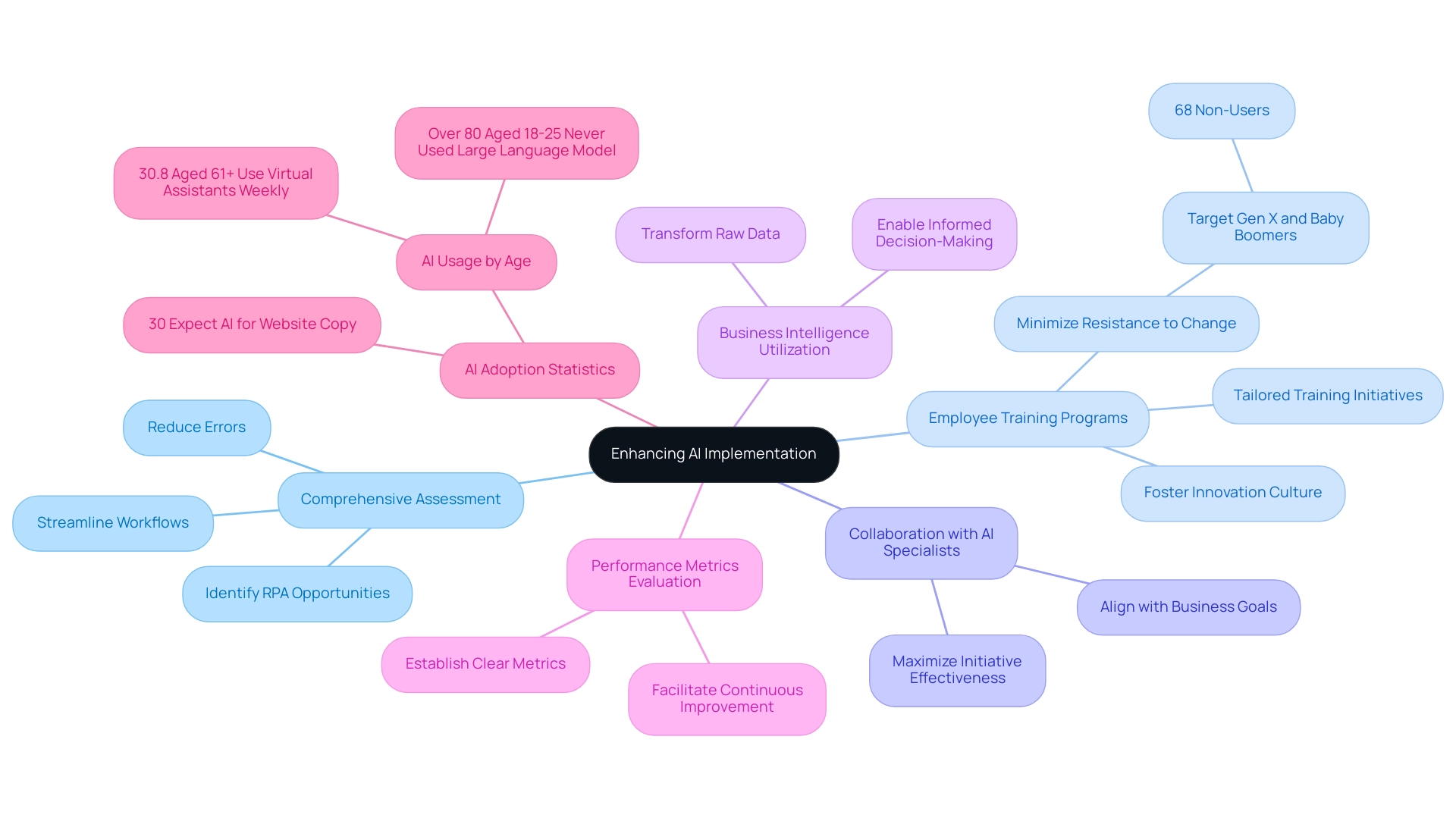
The Future of AI and Its Impact on Business
The future of AI, particularly when combined with Robotic Process Automation (RPA), promises to be a game changer for practices across various industries. As organizations navigate the rapidly evolving AI landscape, they can anticipate increasingly sophisticated solutions designed to enhance decision-making, automate intricate processes, and spur innovation. By leveraging RPA, businesses can streamline manual workflows, significantly boosting operational efficiency and productivity while reducing errors and freeing up teams for more strategic, value-adding work.
The integration of AI with advanced systems such as the Internet of Things (IoT) and blockchain is poised to enhance its impact, opening new pathways for growth. For instance, the self-driving car market has emerged as a substantial economic force, grossing $173 billion in global revenue, showcasing AI’s potential to revolutionize sectors. However, challenges persist, as 40% of executives perceive advanced AI systems and the required expertise for implementation as prohibitively expensive, which creates a barrier to widespread adoption.
With over 4 billion voice assistants in use globally, the demand for AI technologies is clear. In today’s data-rich environment, struggling to extract meaningful insights can leave organizations at a competitive disadvantage. Therefore, it is crucial to unlock the power of Business Intelligence to transform raw data into actionable insights, enabling informed decision-making that drives growth and innovation.
As businesses embrace these advancements, it is essential to remain aware of ethical considerations and ensure responsible implementation of AI. By proactively embracing customized AI approaches and Business Intelligence, entities can position themselves at the forefront of their sectors, enhancing operational efficiency and fostering a culture of innovation that drives future success. Learn more about how our tailored AI solutions and RPA services can help your organization thrive.

Conclusion
Organizations stand at a pivotal crossroads in the realm of artificial intelligence, where the balance between innovation and ethical responsibility is more critical than ever. As highlighted throughout this discussion, embracing AI technologies like generative AI and Robotic Process Automation (RPA) can significantly enhance operational efficiency and productivity. However, this journey is not without its challenges. Companies must navigate implementation hurdles, address data quality issues, and confront societal concerns regarding job displacement.
To successfully harness the potential of AI, organizations should prioritize the establishment of ethical frameworks that promote transparency, fairness, and accountability. By doing so, they not only foster trust among stakeholders but also mitigate risks associated with bias and misuse of technology. The proactive adoption of tailored AI solutions, combined with robust training programs and collaboration with AI experts, will empower businesses to integrate these advanced technologies effectively into their operations.
Looking ahead, the future of AI integration promises to reshape business practices across industries. As organizations leverage RPA and Business Intelligence to streamline processes and drive innovation, they must remain vigilant about the ethical implications of their technologies. By committing to responsible AI development and implementation, businesses can not only enhance their operational capabilities but also contribute positively to the broader community, ensuring that the evolution of AI serves as a force for good. Embracing this holistic approach will position organizations as leaders in their fields, ready to thrive in an increasingly AI-driven world.
Introduction
In a world where efficiency is paramount, Intelligent Document Processing (IDP) emerges as a game-changing solution that transforms how organizations manage their information. By harnessing cutting-edge technologies such as artificial intelligence and machine learning, IDP not only automates the extraction and classification of data but also enhances accuracy and reduces operational costs. As industries grapple with the complexities of traditional document management systems, the advantages of adopting IDP become increasingly clear.
From healthcare to finance, organizations are witnessing remarkable improvements in workflow efficiency and data integrity. With the IDP market projected to experience substantial growth, understanding its diverse applications and benefits is essential for leaders looking to optimize operations and stay ahead of the competition.
This article delves into the key aspects of IDP, exploring its transformative potential and offering insights on how to choose the right solution for organizational success.
Understanding Intelligent Document Processing (IDP)
Intelligent Document Processing (IDP) utilizes advanced technologies—including artificial intelligence and machine learning—to automate the extraction, classification, and processing of information from a variety of file types. Unlike conventional document management systems that merely digitize paperwork, intelligent document solutions intelligently interpret content, facilitating efficient data extraction and processing. This transformative technology significantly streamlines workflows, minimizing manual effort and reducing the likelihood of errors, making it vital for organizations eager to optimize their operations.
The recent case study on a mid-sized company illustrates how implementing GUI automation led to a 70% reduction in data entry errors and an 80% improvement in workflow efficiency. The company faced challenges such as manual data entry errors, slow software testing, and difficulty integrating outdated systems without APIs. These challenges were addressed through the implementation of GUI automation, which not only enhanced efficiency but also improved software quality, particularly in healthcare service delivery.
As Brian Moore, VP of NICCA USA, Inc., states, ‘The quality of research they have done for us has been excellent,’ emphasizing the significance of quality insights in implementing IDP approaches. With the IDP market poised for remarkable growth, projected at a CAGR of 30.6% from 2024 to 2032, it is imperative for leaders in operations to embrace intelligent document solutions to leverage these advancements. The Banking, Financial Services, and Insurance (BFSI) sector is expected to represent over 30% of the total market for intelligent document solutions by 2025, highlighting the vital role of intelligent document solutions in improving efficiency across industries.
Moreover, innovative RPA solutions like EMMA RPA and Microsoft Power Automate are designed to tackle task repetition fatigue and staffing shortages, ultimately enhancing employee morale and productivity. Additionally, leveraging Small Language Models for efficient data analysis and participating in GenAI Workshops for hands-on training can further improve data quality. By utilizing these advanced technologies, organizations can transform business operations, overcoming outdated systems and achieving risk-free ROI assessments through professional execution.

Key Benefits of Implementing Intelligent Document Solutions
Implementing Intelligent Document Solutions (IDS) delivers a multitude of benefits that can transform efficiency and drive substantial cost savings:
- Increased Efficiency: Automating processing with RPA accelerates workflows, allowing teams to focus on higher-value tasks rather than getting bogged down in manual processes. For instance, a recent case study demonstrated that organizations utilizing intelligent document solutions reduced processing time by up to 50%, showcasing the power of RPA in streamlining operations.
- Cost Savings: By decreasing dependence on manual labor and minimizing errors, organizations can achieve significant reductions in expenses. This is particularly evident in case studies where businesses have streamlined their document workflows, resulting in notable financial benefits. One such case involved a company that saved approximately 30% in expenses after implementing intelligent document solutions, highlighting the cost-effectiveness of adopting these technologies.
- Enhanced Accuracy: AI-driven approaches enhance data precision, diminishing the likelihood of costly mistakes that can arise from human oversight. This reliability is crucial for maintaining operational integrity, with studies showing that intelligent document solutions can reduce error rates by up to 90%. The integration of intelligent document solutions and tailored AI solutions ensures that data is processed correctly, further supporting informed decision-making.
- Scalability: Intelligent Processing (IDP) systems are designed to easily scale, accommodating increasing volumes without necessitating a corresponding rise in resource allocation. This flexibility allows organizations to adapt to changing demands seamlessly, particularly in a rapidly evolving AI landscape.
- Improved Compliance: Automated processes ensure that document handling aligns with regulatory requirements, bolstering compliance initiatives and reducing the risk of non-compliance penalties. The validation and workflow automation capabilities of IDP systems ensure that data is validated against predefined rules, facilitating human review for accuracy before integration into downstream systems.
- Business Intelligence: Leveraging Business Intelligence tools alongside IDS enables organizations to analyze data effectively, transforming insights into actionable strategies that drive growth. This integration guarantees that decision-makers can access the information they require to navigate challenges efficiently.
As emphasized by industry expert Tajammul Pangarkar, adopting intelligent document solutions not only streamlines processes but also promotes a culture of efficiency and compliance, paving the way for a more cost-effective framework in 2024 and beyond. Tailored AI solutions further enhance this process by addressing unique business challenges, ensuring that organizations can navigate the complexities of the modern business landscape.
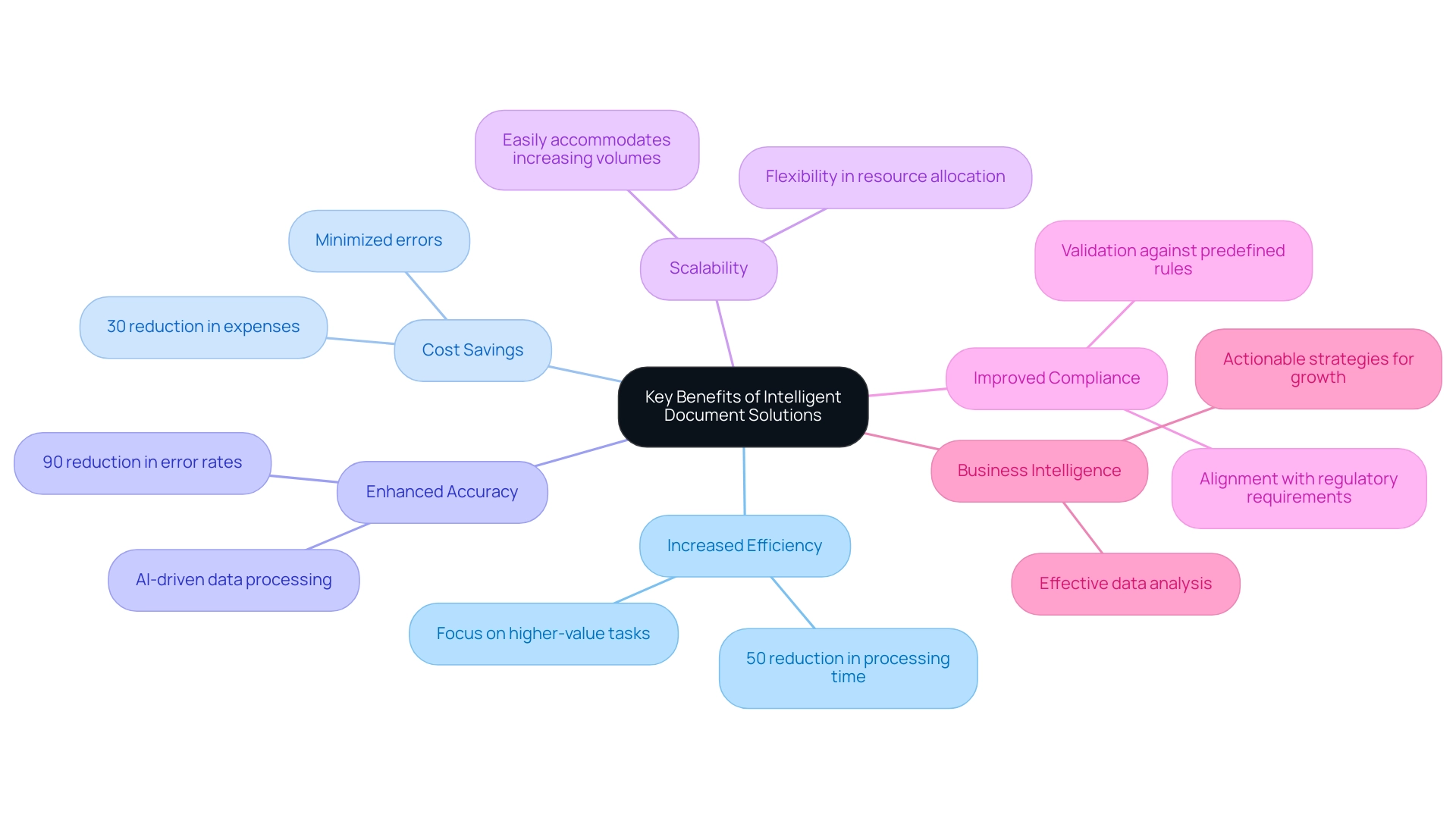
Diverse Use Cases of Intelligent Document Processing
Intelligent document solutions like Intelligent Document Processing (IDP) are revolutionizing efficiency across a multitude of industries, showcasing their versatility and transformational potential. Here are some key applications:
- Healthcare: By automating patient records management and billing processes, IDP significantly enhances efficiency and accuracy, allowing healthcare providers to focus more on patient care.
In a recent case study, a mid-sized healthcare company faced challenges such as manual data entry errors, slow software testing, and difficulty integrating outdated systems without APIs. By utilizing GUI automation, they reduced data entry errors by 70% and improved workflow efficiency by 80%, achieving a return on investment (ROI) within just 6 months, demonstrating the tangible benefits of automation in healthcare settings.
- Finance: The finance sector benefits immensely from IDP by streamlining invoice processing and managing compliance documentation.
Notably, by 2025, the BFSI sector is expected to account for over 30% of the total market for intelligent document solutions, underscoring the significance of intelligent document solutions in enhancing financial operations. This leads to reduced turnaround times and minimizes errors, ultimately supporting better financial decision-making.
- Legal: In the legal field, automating contract reviews and information discovery not only accelerates workflows but also enhances accuracy, reducing the time lawyers spend on tedious paperwork.
The integration of RPA can further enhance these processes, ensuring that legal teams operate efficiently.
-
Insurance: IDP simplifies the handling of claims and policy documents, improving customer service and efficiency. Quick and accurate processing is essential in preserving client satisfaction and trust, particularly as automation methods continue to evolve.
-
Manufacturing: By improving the management of supply chain documentation and compliance reporting, IDP helps minimize delays and errors, allowing manufacturers to operate more smoothly in a competitive landscape. The implementation of customized AI tools can further improve these functional efficiencies.
-
E-Commerce: The expansion of the e-commerce industry requires automated processing systems to handle rising transaction volumes and complexities.
E-commerce is anticipated to represent 22% of total retail sales by 2024, boosting demand for IDP systems and highlighting its importance to efficiency.
As sectors keep advancing, utilizing intelligent document solutions will be crucial for remaining competitive and achieving excellence. As highlighted in recent trends, product innovation is a major driving force in the intelligent document processing market, paving the way for more effective approaches and empowering organizations to thrive in a rapidly changing landscape.
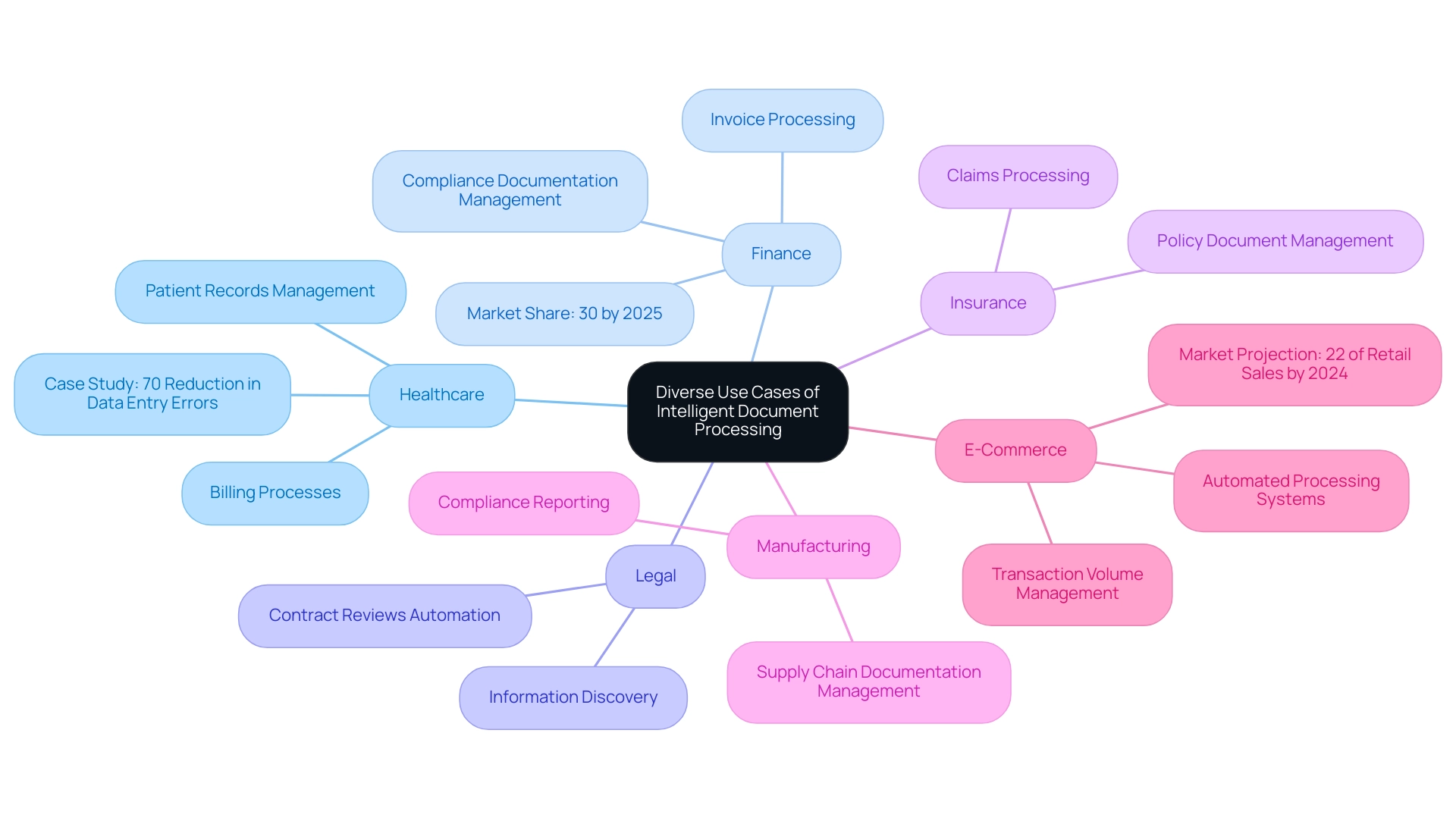
How to Choose the Right Intelligent Document Processing Solution
When evaluating Intelligent Document Processing (IDP) solutions, it is essential to consider the following criteria to ensure the chosen technology aligns with your operational goals:
-
Integration Capability: The ability to seamlessly integrate with existing systems and workflows is paramount. An approach that syncs effortlessly can significantly enhance efficiency and reduce friction in your operations. Partnerships with leading insurance core platform vendors are crucial for successful integration, as structured data must be incorporated into systems of record. Leveraging Robotic Process Automation (RPA) can significantly streamline this process, allowing for a more cohesive workflow and reducing wasted time and resources associated with manual tasks.
-
Customization: Choose options that provide tailored features to meet specific business requirements and accommodate various document types. This flexibility ensures that the IDP approach can evolve with your organization. For instance, Zenphi offers advanced features like OCR and unstructured data extraction at more affordable rates compared to enterprise-level options, making it a compelling choice for organizations seeking customization. Customizing AI approaches can assist in recognizing the appropriate technologies that correspond with your particular business objectives and obstacles, particularly in managing the intricacies of the swiftly changing AI environment.
-
Scalability: Choose a solution designed to grow alongside your organization. It should be capable of handling increasing document volumes without compromising performance, which is essential in a rapidly evolving AI landscape.
-
User-Friendliness: An intuitive interface is crucial for user adoption. Solutions that minimize the learning curve enable teams to leverage technology effectively without extensive training. This can enhance operational efficiency and ensure that your team is freed up for more strategic, value-adding work.
-
Vendor Support: Assess the level of support provided by the vendor. Robust vendor support is essential for effective implementation and continuous maintenance, ensuring that your organization can navigate the complexities of IDP offerings. As Ana, a T-shaped marketer with a wide experience in eCommerce and B2B marketing, notes, “Unconventional strategies and strong vendor partnerships are key to exceptional growth in the evolving landscape of document processing.”
In 2024, as the demand for intelligent document solutions continues to evolve, it will be crucial to prioritize integration capabilities and customization for achieving excellence in operations. Additionally, unlocking the power of Business Intelligence to transform raw data into actionable insights will drive informed decision-making that propels growth and innovation, allowing businesses to stay competitive in a data-rich environment.
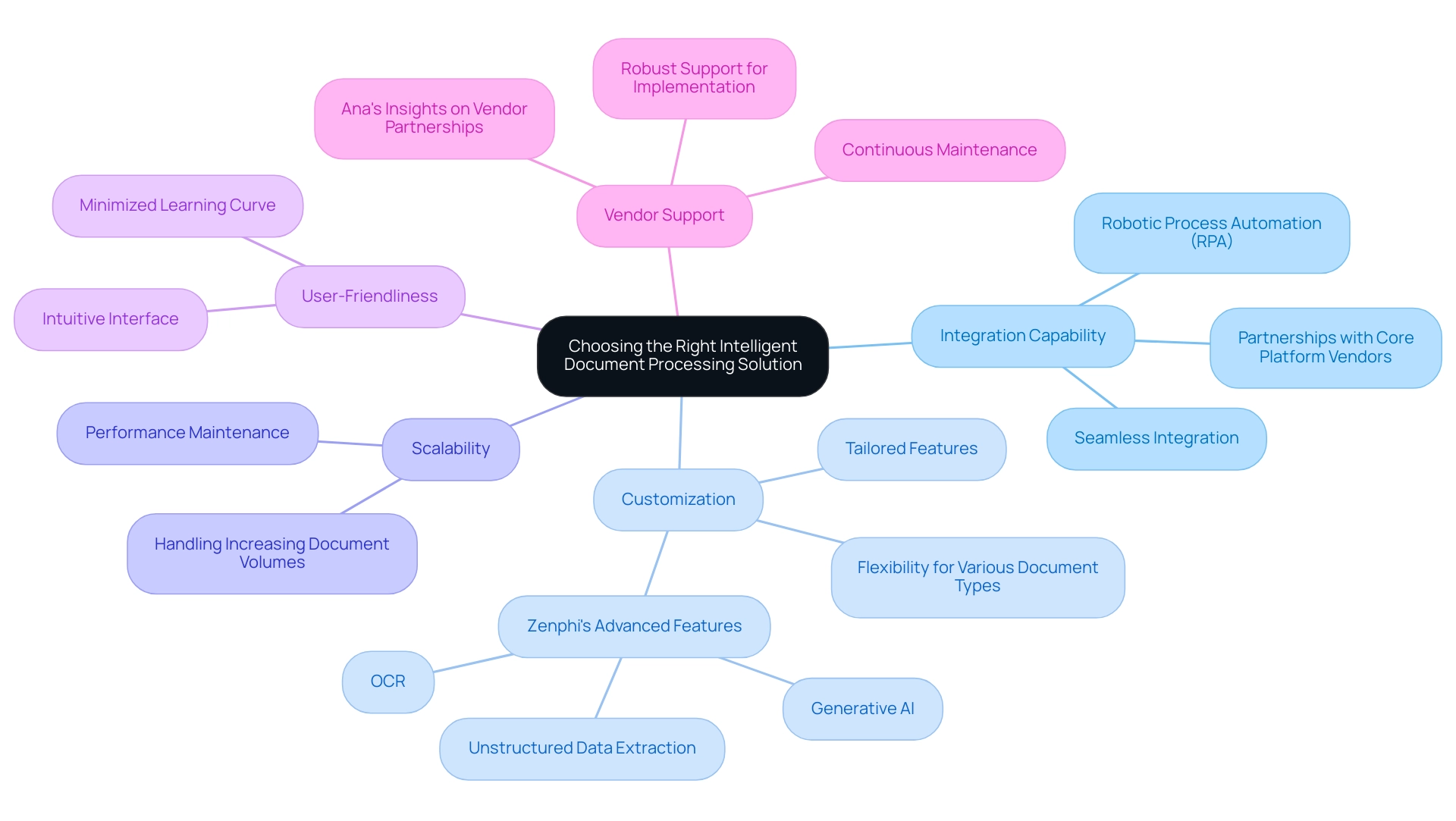
Future Trends in Intelligent Document Processing
As the landscape of Intelligent Document Processing (IDP) continues to evolve, several key trends are emerging that can significantly impact operational efficiency:
-
The future of intelligent document solutions will see a deeper integration of AI technologies, enhancing capabilities for data extraction and processing. With an impressive accuracy rate that can reach 99%, AI is set to revolutionize how organizations manage their files, making it a critical component in the modern management landscape. This integration can significantly alleviate the challenges of poor master data quality, enabling informed decision-making that drives growth and innovation.
-
Cloud-Based Options: The continuous transition towards cloud computing is encouraging the creation of more adaptable and scalable file processing alternatives. This growth allows businesses to adapt quickly to changing demands while maintaining high levels of efficiency, addressing the complexities and costs often associated with intelligent document solutions.
-
Improved Security Features: Considering rising data privacy issues, forthcoming processing systems will progressively integrate advanced security measures. These enhancements are essential for protecting sensitive information and ensuring compliance with regulations, a crucial consideration in the evolving AI landscape.
-
Anticipate encountering intelligent document solutions that offer real-time document processing capabilities. This advancement enables organizations to respond swiftly to evolving needs, thereby enhancing decision-making and agility, particularly in environments where speed is critical.
-
Collaboration Tools: The integration of collaborative platforms within IDP systems will enhance teamwork and streamline workflows across departments. This trend underscores the importance of seamless communication and coordination in achieving organizational goals, ultimately enhancing business productivity through intelligent document solutions and automated workflows.
As highlighted in a recent SWOT analysis of the Intelligent Document Processing market, these trends present opportunities for growth but also highlight challenges that stakeholders must navigate. The analysis suggests that while the integration of AI and cloud-based systems can significantly enhance efficiency, organizations must also be vigilant about security and compliance issues. Additionally, Tajammul Pangarkar, CMO at Prudour Pvt Ltd, highlights the significance of adopting these innovations, stating, “When it comes to managing documents effectively, utilizing AI and cloud technologies is no longer optional; it’s vital for success.”
These insights from industry experts, including those from Cozentus, further underscore the importance of embracing tailored AI solutions and Business Intelligence to enhance operational efficiency and address the challenges of poor master data quality.

Conclusion
Intelligent Document Processing (IDP) represents a transformative shift in how organizations handle their information, integrating advanced technologies like artificial intelligence and machine learning to streamline workflows and enhance accuracy. As demonstrated through various industry case studies, the adoption of IDP has led to significant improvements in operational efficiency, cost savings, and data integrity. With capabilities that range from automating patient records in healthcare to accelerating invoice processing in finance, IDP is proving to be crucial across diverse sectors.
The benefits of implementing Intelligent Document Solutions are clear:
- Increased efficiency
- Reduced operational costs
- Enhanced accuracy
- Improved compliance
By automating routine tasks, organizations free up valuable resources to focus on strategic initiatives, thereby fostering a culture of innovation and agility. As the IDP market continues to grow, with projections indicating substantial advancements in the coming years, leaders must prioritize the integration of these solutions to maintain a competitive edge.
As organizations evaluate IDP solutions, focusing on criteria such as:
- Integration capabilities
- Customization
- Scalability
- User-friendliness
- Vendor support
will be essential in achieving operational excellence. By embracing these innovative technologies and trends, businesses can navigate the complexities of modern document management, ultimately transforming their operations and paving the way for sustainable growth in an increasingly data-driven world. The future of IDP is not just about efficiency; it is about empowering organizations to thrive in a rapidly changing landscape.
Introduction
In the quest for operational excellence, businesses are increasingly turning to automation as a game-changer. Automation discovery serves as the foundational step in this transformative journey, enabling organizations to identify and streamline repetitive tasks that drain resources and hinder productivity.
By harnessing advanced tools like EMMA RPA and Microsoft Power Automate, companies can not only enhance efficiency but also empower their workforce to focus on strategic initiatives.
As the landscape of automation continues to evolve, understanding its potential and implementing effective strategies is crucial for organizations aiming to thrive in a competitive market.
This article delves into the critical aspects of automation discovery, offering insights and practical steps to unlock its benefits while navigating the challenges that may arise along the way.
Understanding Automation Discovery: The Key to Business Efficiency
The identification of repetitive and time-consuming tasks within an organization is a crucial procedure that highlights opportunities for mechanization. By thoroughly analyzing workflows and operational methods, businesses can effectively identify areas where robotic process automation (RPA), such as EMMA RPA and Microsoft Power Automate, can enhance their operations. EMMA RPA provides user-friendly interfaces and customizable workflows, while Microsoft Power Automate allows seamless integration with existing systems to enhance efficiency.
This initial step is essential for enhancing operational performance, as it enables organizations to redirect their focus towards strategic initiatives rather than getting bogged down by mundane tasks. The recent case study on a mid-sized company showed how introducing GUI technology not only decreased data entry mistakes by 70% but also sped up testing processes by 50%, leading to an 80% increase in workflow productivity. Such outcomes exemplify the transformative potential of technology tools in the healthcare sector, addressing challenges like task repetition fatigue and staffing shortages.
According to recent statistics, technological advancements have shown to significantly impact business efficiency, with many organizations reporting increased productivity and cost savings. For instance, marketing technology has led to an increase in leads for 80% of users, showcasing its effectiveness. However, it is crucial to recognize the potential risks associated with mechanization; by 2030, 47% of jobs in the United States are projected to have a high risk of displacement related to this process.
As Bill Gates wisely stated, ‘The first rule of any technology used in a business is that mechanization applied to an efficient operation will magnify the efficiency.’ The second is that mechanization applied to an inefficient operation will magnify the inefficiency. This highlights the significance of recognizing the appropriate tasks for mechanization before implementation. Additionally, the case study titled ‘Measuring the Impact of Automation’ highlights key metrics such as productivity, operational efficiency, cost savings, and customer satisfaction, revealing that regular measurement is crucial for ensuring that initiatives are delivering desired outcomes.
Additionally, it is important to note that technical difficulties lead to the failure of 90% of automated initiatives, with 37% failing due to elevated implementation expenses. The ROI from the automated solutions was realized within six months, highlighting their effectiveness. Acknowledging the significance of automation discovery is not only advantageous; it’s the initial step in unlocking the transformative potential of technology within your business operations.
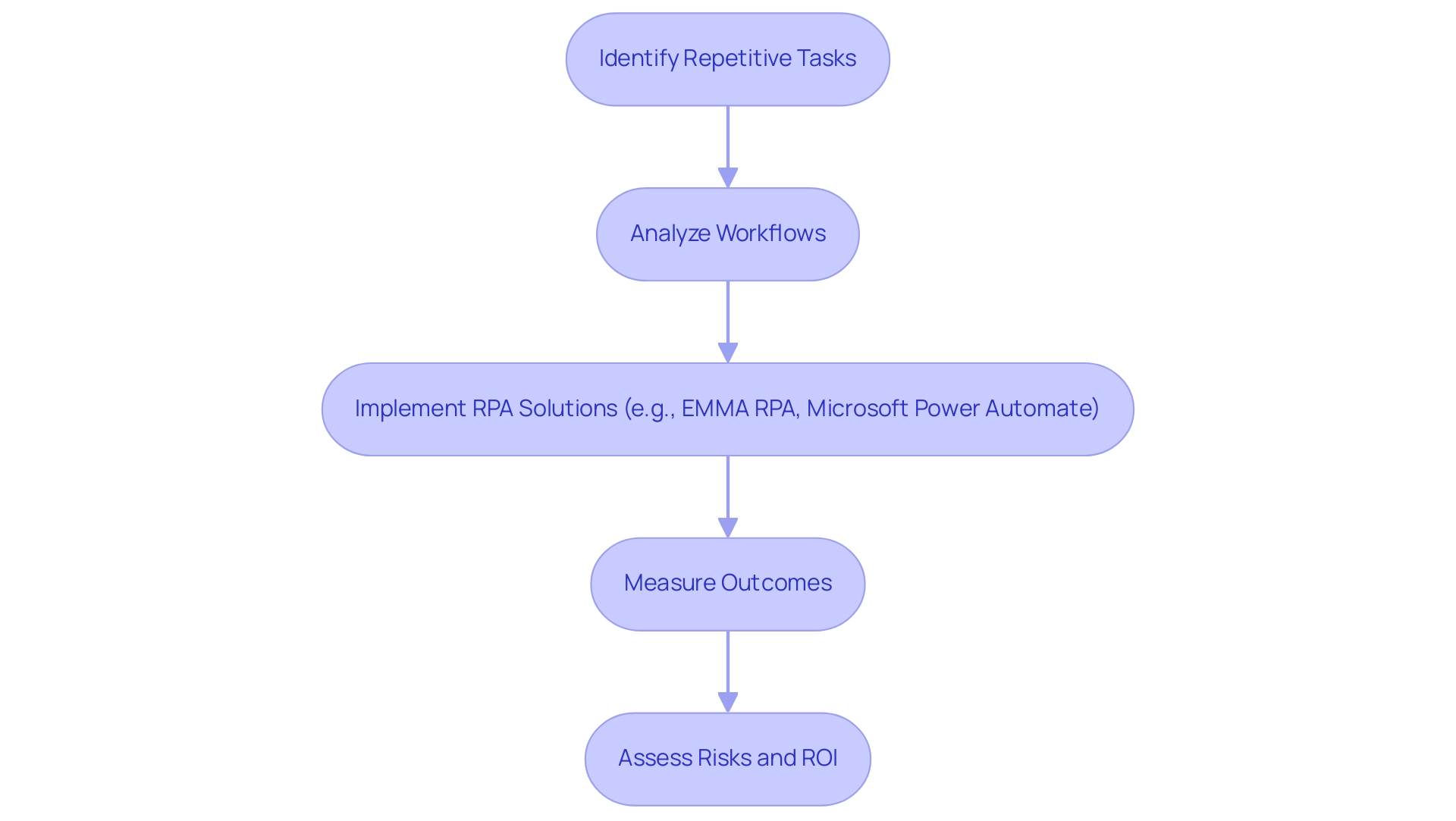
Step-by-Step Guide to Implementing Automation Discovery
-
Identify Procedures for Review: Start by pinpointing the procedures within your organization that are prime candidates for automation discovery. Look for repetitive, rule-based tasks that consume significant time and resources. These tasks often represent the greatest opportunities for efficiency gains, particularly through automation discovery via RPA solutions like EMMA RPA and Microsoft Power Automate.
-
Map Out Current Workflows: Once you’ve recognized these methods, document the existing workflows. Utilize flowcharts or process maps to visualize each step involved. This visual representation will aid in understanding the current state and highlight areas ripe for improvement.
-
Analyze Data and Metrics: Collect quantitative data on each task’s duration, error rates, and resource allocation. This analysis is crucial for evaluating the potential effect of automation discovery. Insights from a McKinsey survey show that 66% of companies have already engaged in automation discovery for several functions, reflecting a growing trend and acceptance of mechanization in various sectors. Moreover, the cloud technology market is predicted to increase by $103.9 billion, highlighting the importance of this process in enhancing operational efficiency.
-
Engage Stakeholders: Actively involve employees and key stakeholders in discussions regarding opportunities for mechanization. Their insights are invaluable for identifying existing pain points and potential areas for enhancement. Engaging them fosters a collaborative atmosphere that can lead to more successful implementation.
-
Prioritize Automation Possibilities: Utilizing the insights obtained from your analysis and stakeholder feedback, prioritize which tasks will gain the most from streamlining. Assessing the potential impact on productivity and resource optimization is essential for making informed decisions.
-
Select Automation Instruments: Research and evaluate suitable tools, such as EMMA RPA and Microsoft Power Automate. These intuitive solutions are created to streamline the mechanization of tasks, thereby improving operational efficiency and employee morale. Select tools that fit your operational requirements and the methods you’ve identified for automation discovery.
-
Pilot the System: Implement a pilot project that tests the automated process on a small scale. This approach allows you to monitor performance closely, gather feedback, and make necessary adjustments before wider implementation.
-
Scale Up: Following a successful pilot, gradually expand mechanization initiatives to other identified processes. Continue to monitor performance metrics and optimize as necessary, ensuring that your strategy evolves with your business needs. Additionally, consider the rising demand for automation in sectors like agriculture, where the market for automated farming equipment is expected to rise to $23.06 billion by 2028, reflecting broader trends in automation adoption.
-
Address Outdated Systems: Acknowledge that outdated systems can considerably obstruct operational productivity and innovation. By implementing RPA solutions and emphasizing automation discovery, you can modernize these systems, streamline processes, and reduce errors, ultimately boosting productivity and employee morale. RPA tools like EMMA RPA and Microsoft Power Automate play a crucial role in transforming these legacy systems into efficient, automated workflows.
-
Enhance Employee Morale: Automation not only boosts productivity but also positively affects employee morale. By alleviating the burden of repetitive tasks, employees can focus on more meaningful work, leading to increased job satisfaction and productivity.
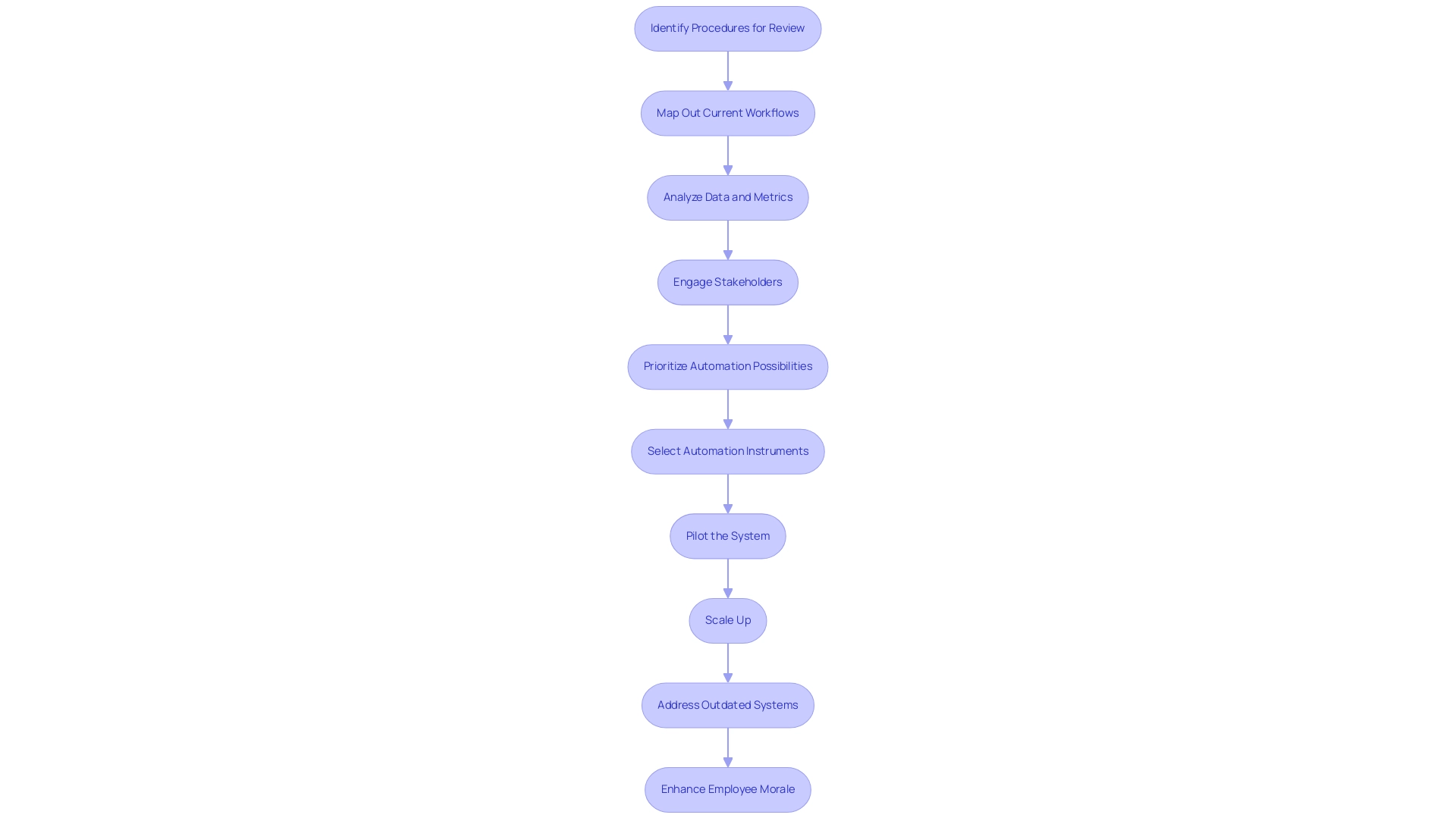
The Benefits of Automation Discovery for Businesses
Introducing automation discovery can unlock a multitude of advantages for companies, fundamentally transforming operations and improving overall productivity. Key advantages include:
-
Enhanced Productivity: By utilizing automation discovery to automate routine tasks like data entry and software testing, organizations empower employees to concentrate on higher-value work, significantly boosting output and innovation. As demonstrated in a recent case study, a mid-sized company enhanced workflow efficiency by 80% through graphical user interface improvements, enabling teams to achieve more in shorter periods.
This was particularly crucial in addressing challenges such as manual data entry errors and slow software testing processes, with a focus on automation discovery to enhance operational efficiency. -
Cost Reduction: Automation discovery plays a crucial role in minimizing labor costs by reducing the need for manual intervention, as seen in the same case study where data entry errors were reduced by 70%. This not only reduces expenses but also alleviates mistakes usually linked to human tasks, leading to more efficient operations through automation discovery.
-
Enhanced Precision: Automation discovery focuses on automated methods that are designed to lessen the chances of errors, ensuring outputs are of higher quality and comply with industry standards. This improvement in accuracy fosters greater trust in operational outputs, enhancing overall business credibility, particularly in sectors like healthcare, by leveraging automation discovery. The improved precision was also aided by the incorporation of legacy systems through automation discovery.
-
Faster Decision-Making: Automation discovery enables entities to streamline processes and respond to market changes with agility. With automation discovery in place, decision-making accelerates, allowing businesses to capitalize on opportunities and navigate challenges more effectively.
-
Scalability: One of the most significant advantages of automation discovery is its ability to support business scalability. Entities can expand their operations without a proportional rise in resources, streamlining growth while preserving efficiency.
As the trend of digital transformation persists, it is significant that 80% of entities will embrace automation discovery by 2025, emphasizing the importance of mechanization in today’s business environment. Additionally, the case study titled ‘Impact of Automation on Jobs’ illustrates how automation discovery through artificial intelligence and robotics is reshaping job functions across industries. The role of Robotic Process Automation (RPA) in this context is pivotal, as automation discovery streamlines manual workflows, further enhancing operational efficiency.
As Juan Perez, EVP and CIO of Salesforce, aptly states, ‘As companies adjust to an unpredictable environment, those that invest in automation discovery are poised to reap significant cost savings and productivity advantages.’ This insight underscores the strategic necessity of adopting mechanization as a means to automation discovery, which is essential for sustainable growth and competitive advantage.
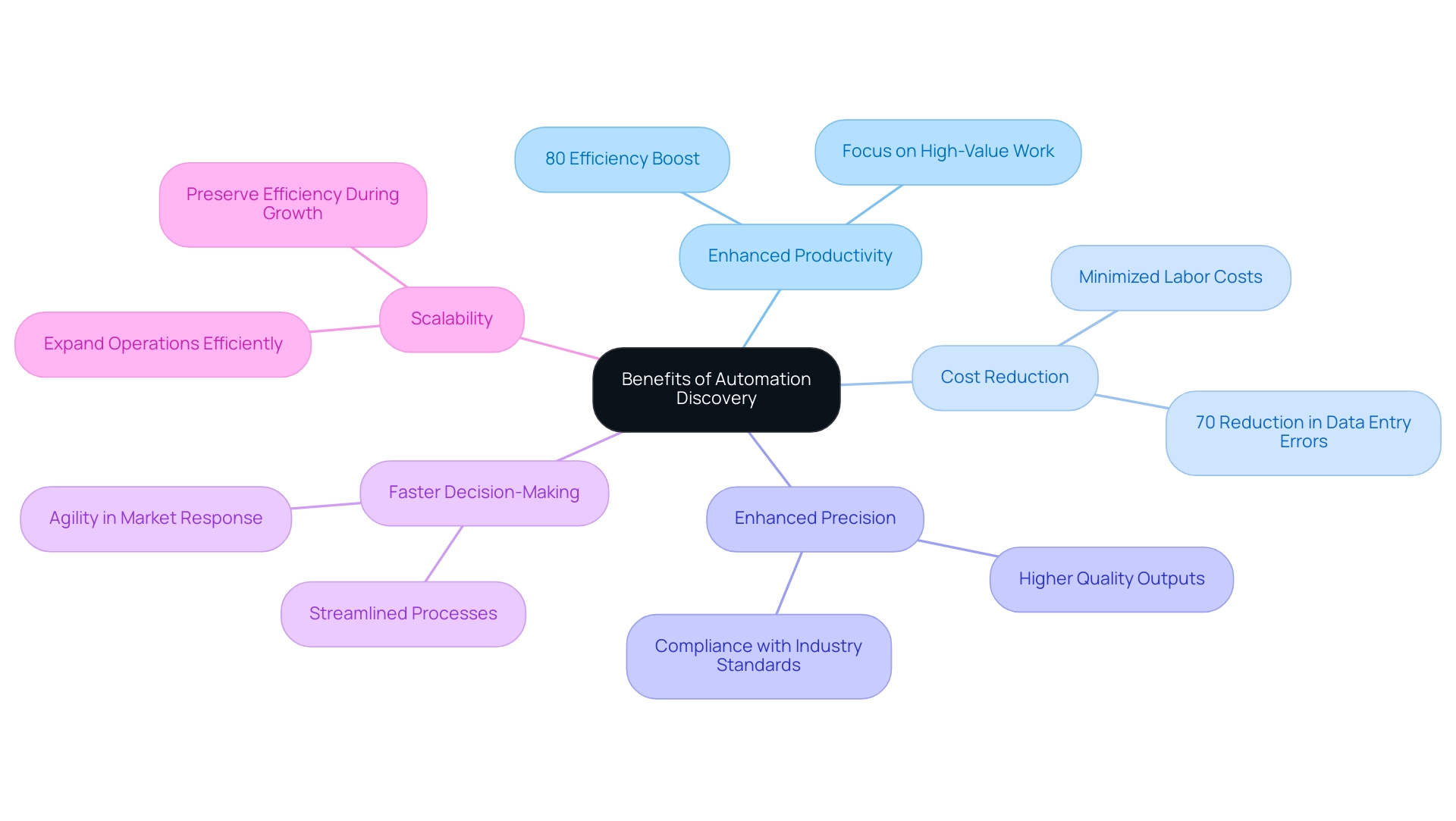
Overcoming Challenges in Automation Discovery Implementation
Introducing automated discovery offers companies significant prospects for efficiency and growth, yet various challenges may emerge during the implementation:
-
Resistance to Change: A notable barrier can be employee reluctance towards embracing new technologies. According to SurveyMonkey, 30% of workers earning under $50,000 per year are worried that AI will soon make their job obsolete, highlighting the importance of addressing this concern. To tackle resistance, it is crucial to involve team members early in the implementation process. Comprehensive training and clear communication about the benefits of automation—particularly Robotic Process Automation (RPA)—can foster a culture of acceptance. In fact, 86% of IT leaders have seen improved client satisfaction due to cloud technology, showcasing the positive outcomes of overcoming these challenges.
-
Integration Issues: Many organizations face difficulties integrating existing systems with new tools. To alleviate this, carry out comprehensive evaluations of existing infrastructure and choose suitable technologies that correspond with your objectives for mechanization. This proactive approach minimizes disruption and enhances operational coherence. A case study on mechanization reveals that 84% of business leaders using cloud systems report increased revenue and reduced operational costs, further emphasizing the value of successful integration, especially when leveraging tailored AI solutions.
-
Lack of Clarity: Ambiguity surrounding the goals and scope of mechanization can lead to misalignment and frustration. Clear communication of objectives is essential. Regularly updating all stakeholders ensures alignment and fosters a sense of shared purpose. The significance of Business Intelligence in converting data into practical insights cannot be exaggerated, promoting informed decision-making and operational efficiency.
-
Resource Constraints: Limited resources often hinder initiative efforts. Focus on prioritizing projects that promise the highest return on investment. Engaging executive support can also unlock additional resources and drive commitment across the organization.
-
Ongoing Maintenance: Automation solutions are not a set-and-forget strategy; they require continuous updates and maintenance. Creating a dedicated team accountable for these aspects guarantees that automated systems stay effective and relevant, ultimately aiding in sustained success. By adopting a risk-free, ROI-driven method to streamline processes, as illustrated by successful GUI case studies, organizations can navigate these challenges and enhance operational efficiency effectively.
To ensure a successful implementation, we recommend a step-by-step approach:
- Evaluate a procedure you would like to automate.
- Calculate the efforts required for automation.
- Estimate the time savings and calculate the ROI.
- Automate the procedure, executed by a certified professional. Significantly, you only pay if the procedure is automated as intended.
By tackling these challenges directly and utilizing customized AI solutions, entities can pave the way for successful automation discovery processes, enhancing overall operational productivity.
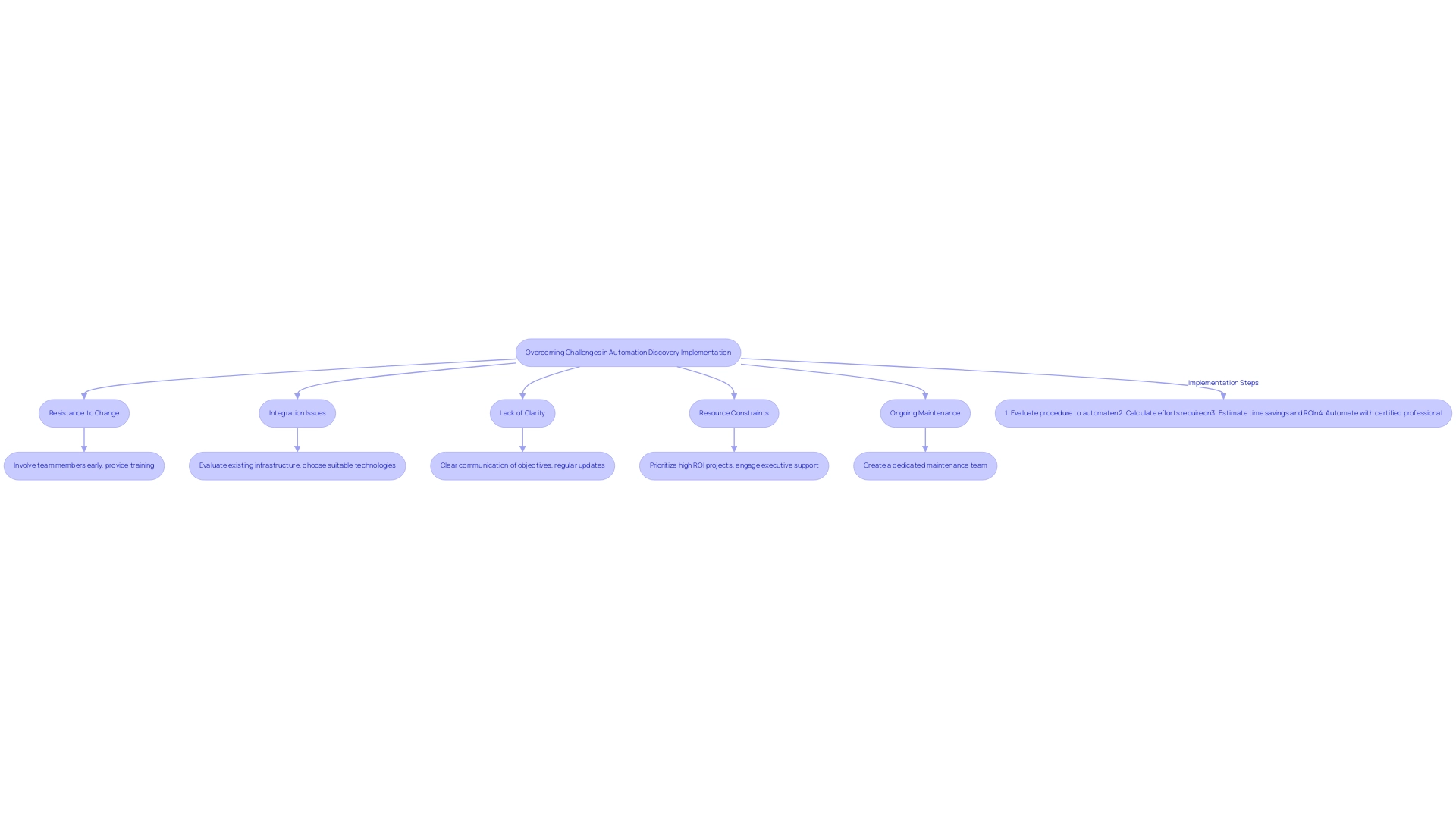
Essential Tools for Effective Automation Discovery
To effectively traverse the terrain of technology exploration, utilizing specialized instruments for automation discovery that enhance efficiency and simplify workflows is essential. Here are several crucial tools to consider:
-
Process Mapping Software: Tools like Lucidchart or Microsoft Visio enable companies to visualize workflows clearly, which is vital for identifying potential opportunities for improvement. The efficiency of workflow mapping software in mechanization is well-documented, with many companies reporting improved clarity in their operations as a result of automation discovery. Notably, Software AG’s ARIS has been recognized as a Leader in the Forrester Wave™ Process Intelligence Software report, underscoring its effectiveness in this domain.
-
RPA Platforms: Leading RPA tools such as UiPath, Automation Anywhere, and Blue Prism offer powerful capabilities designed to automate repetitive tasks efficiently. With 60% of organizations utilizing test systems reporting significant improvements in application quality, these platforms are becoming essential for driving operational success. EMMA RPA, in particular, stands out as a revolutionary tool that enhances efficiency and employee morale, while Microsoft Power Automate provides streamlined workflow management with a risk-free ROI assessment and professional execution.
-
Business Intelligence Tools: Solutions like Tableau and Power BI facilitate deep data analysis and provide valuable insights into process performance. By leveraging these tools, businesses can identify inefficiencies and optimize operations, which supports automation discovery and enables data-driven decision-making during initiatives for process improvement.
-
Collaboration Tools: Effective communication is key during the discovery phase. Platforms like Slack and Microsoft Teams promote collaboration among stakeholders, making sure that all parties are aligned and informed during the process.
-
Change Management Software: Implementing new automated practices requires careful management of the human element involved. Tools like Prosci and Kotter are designed to assist entities in navigating change effectively, promoting smoother transitions and greater acceptance among team members.
-
Tailored AI Solutions: As the AI landscape evolves, it is critical to leverage customized AI solutions that can help identify the right technologies for specific business needs, overcoming challenges related to poor master data quality and perceived complexities.
As highlighted by industry success stories, such as Counter Tools performing hundreds of tests within minutes and drastically reducing manual testing time, the transformative potential of utilizing technology tools strategically cannot be overstated. With less than 50% of companies currently utilizing AI capabilities for test automation, there remains a significant opportunity for enhancements. As organizations look to the future, the automation discovery of these tools will be pivotal in enhancing operational efficiency and achieving a competitive advantage in a rapidly changing environment.
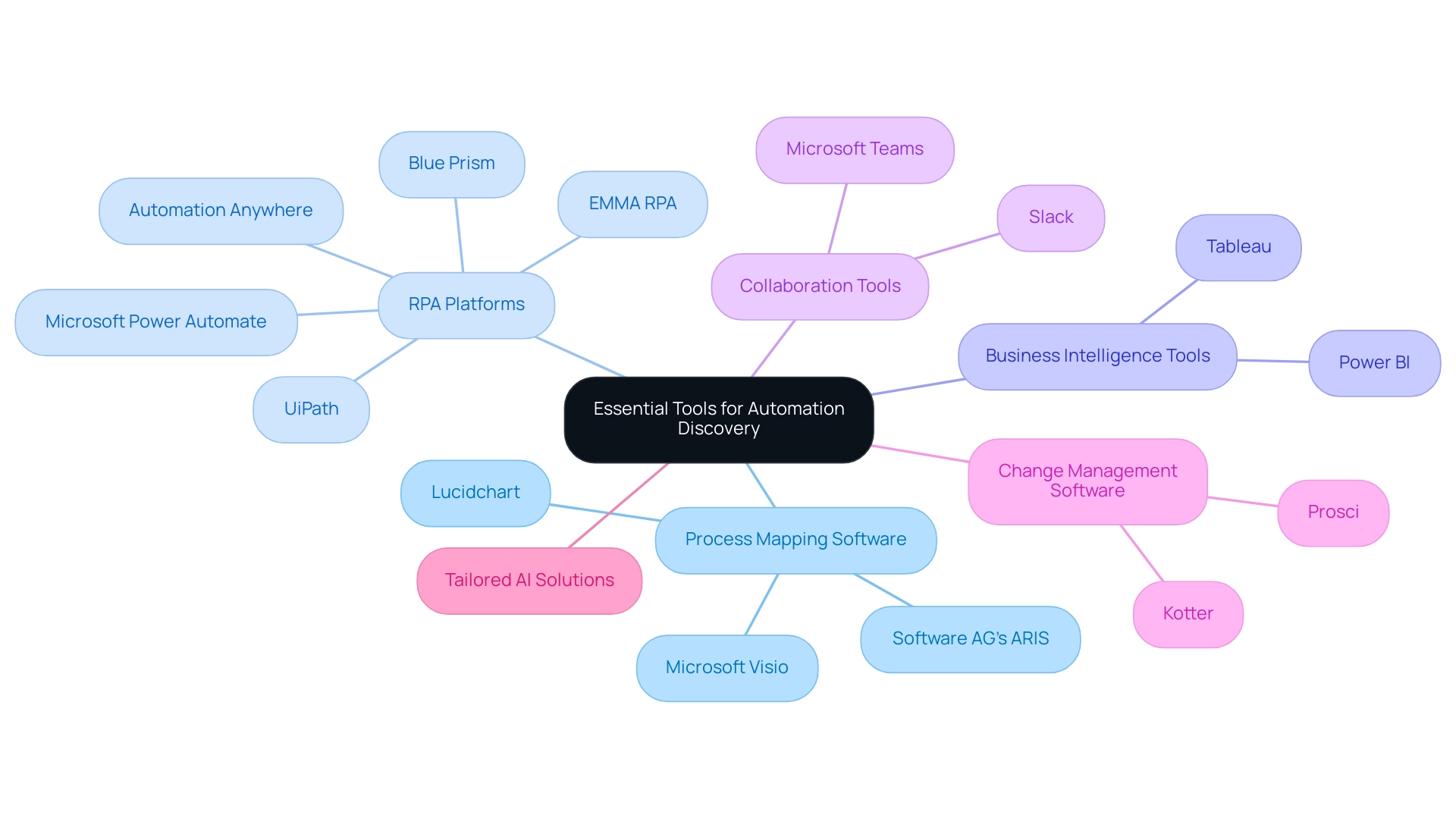
Conclusion
Identifying and implementing automation discovery is an essential strategy for businesses seeking to enhance operational efficiency and drive growth. By thoroughly analyzing workflows and recognizing tasks that can be automated, organizations can redirect their resources toward more strategic initiatives, ultimately leading to improved productivity, reduced costs, and greater accuracy in operations.
The journey to effective automation begins with:
- A careful assessment of current processes
- Engaging stakeholders
- Selecting the right tools for implementation
Embracing automation tools like EMMA RPA and Microsoft Power Automate can facilitate a seamless integration of new technologies into existing systems, ensuring a smoother transition and maximizing the benefits of automation. The case studies highlighted in this article demonstrate that when executed correctly, automation can yield impressive results, such as significant reductions in errors and enhanced workflow efficiencies.
However, it is crucial to navigate the challenges that may arise during the implementation process. Resistance to change, integration issues, and the need for ongoing maintenance can be mitigated through:
- Clear communication
- Stakeholder involvement
- A commitment to continuous improvement
By addressing these challenges head-on, organizations can unlock the full potential of automation discovery, leading to sustainable growth and a competitive edge in an increasingly digital landscape.
Ultimately, the proactive adoption of automation discovery is not just a trend; it is a strategic imperative for organizations looking to thrive in a competitive market. As automation continues to evolve, staying ahead of the curve and investing in these transformative technologies will be key to achieving long-term success.
Introduction
In an era where customer expectations are higher than ever, automation chatbots are emerging as a game-changer for businesses striving to enhance operational efficiency and user engagement. These intelligent systems, powered by advanced artificial intelligence and natural language processing, are not just tools for answering inquiries; they represent a strategic shift in how organizations interact with their customers.
From streamlining customer service to driving sales conversions without human intervention, the capabilities of chatbots are reshaping industries across the board. As companies increasingly adopt these technologies, understanding their functionality and real-world applications becomes crucial for leveraging their full potential.
This exploration delves into the transformative benefits of automation chatbots, their operational foundations, and the innovative trends that are set to redefine customer interactions in the near future.
Defining Automation Chatbots: What They Are and How They Work
Automation virtual assistants represent advanced software applications designed to simulate conversation through the power of artificial intelligence. By utilizing predefined scripts and advanced algorithms, these virtual assistants are adept at understanding user inquiries and delivering appropriate responses. Central to their functionality is natural language processing (NLP), which enables them to interpret and process user inputs in real-time, facilitating immediate assistance.
This ability is especially beneficial in client support, as data shows that 23.7% of inquiries can convert into sales without personal involvement. Moreover, recent studies highlight that personalization through digital assistants can drive revenue growth for telecom companies by 5% to 15%. A significant case study named ‘Chatbots for Upselling’ demonstrates how automated assistants can effectively suggest additional products based on customer preferences, with 20% of companies utilizing this method to boost sales.
As Kateryna Cherniak, an SEO Specialist, notes, ‘Globally, 38% of consumers hold a positive view of digital assistants.’ Meanwhile, integrating Robotic Process Automation (RPA) solutions like EMMA RPA and Microsoft Power Automate can further enhance operational efficiency and employee morale. RPA specifically addresses task repetition fatigue by automating mundane tasks, allowing employees to focus on more strategic activities, thus improving job satisfaction.
The friendly robots depicted in the illustration, standing alongside a human figure, symbolize the collaboration between humans and machines in the workplace, emphasizing the seamless integration of RPA in enhancing service delivery. As more companies adopt automation chatbots and RPA, the role of these technologies in improving user interaction and generating data-driven insights becomes more apparent, enabling organizations to maneuver through the swiftly changing AI environment.
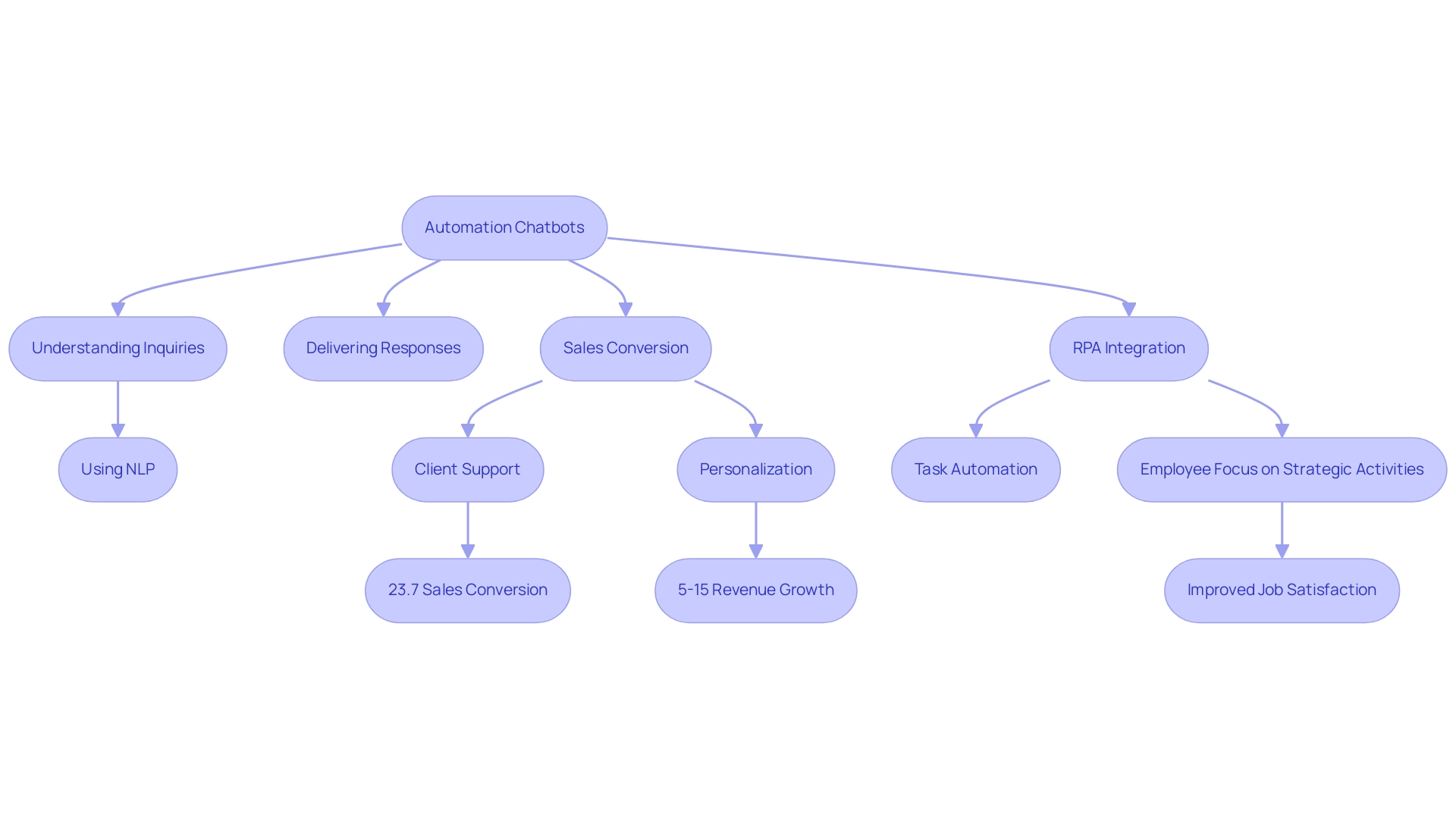
The Benefits of Automation Chatbots in Modern Business
The adoption of automation chatbots presents a transformative opportunity for modern businesses, particularly in enhancing operational efficiency through Robotic Process Automation (RPA). One of the most compelling advantages is cost reduction; an automation chatbot can efficiently manage multiple inquiries simultaneously, significantly cutting the need for additional staffing. This capability not only reduces operational costs but also enhances service, ensuring instant responses that drive improved satisfaction and engagement.
Notably, lead qualification through chatbot quizzes yields results that are 20% superior to traditional static forms. As Nicolas Babin, a Key Opinion Leader, states, today’s clients expect a mix of self-service and human assistance, which an automation chatbot can successfully provide based on the complexity of inquiries. MarketWatch states that 80% of clients believe businesses lack context in prior interactions, emphasizing the necessity for virtual assistants to adjust to client needs.
Businesses such as Sephora and H&M illustrate this trend, efficiently utilizing virtual assistants for product inquiries and order tracking, leading to increased sales and client loyalty. Moreover, a telecom company utilizing an automation chatbot for Messenger reported a remarkable 3.5-fold increase in employee productivity and a 50% reduction in hotline calls. These success stories highlight how virtual assistants streamline operational processes by automating repetitive tasks, empowering human employees to focus on strategic initiatives, and ultimately driving profitability and client satisfaction.
Importantly, successful deployment of the automation chatbot hinges on proper implementation and continuous improvement based on customer feedback, ensuring that the automation chatbot evolves to meet changing customer expectations. Additionally, leveraging business intelligence can transform data into actionable insights, aiding informed decision-making in chatbot deployment and optimization, ultimately enhancing user interaction and operational efficiency.

Technological Foundations: How Automation Chatbots Operate
Automation systems, such as automation chatbots, are revolutionizing user interaction through foundational technologies like natural language processing (NLP) and machine learning (ML) algorithms. NLP allows virtual assistants to understand and interpret language, facilitating meaningful and contextually relevant conversations. This capability is further enhanced by machine learning, empowering conversational agents to learn from prior interactions and refine their responses over time.
Notably, 23.7% of inquiries now convert into sales without any human intervention, showcasing the effectiveness of these systems. In a rapidly evolving AI landscape, the NLP market experienced a remarkable growth rate of 36.5% in 2022, reflecting a shift towards sustained development as the technology matures. Numerous virtual assistants utilize cloud-based platforms for data storage and processing, ensuring scalability and flexibility in operations.
As 56% of companies recognize automation chatbots as industry disruptors and 57% acknowledge their substantial ROI with minimal effort requirements, understanding the operational foundations of these automation chatbot technologies is crucial for effective implementation and optimization. Furthermore, Robotic Process Automation (RPA) plays a vital role in this ecosystem by reducing errors and freeing up team resources, allowing organizations to focus on strategic initiatives. Additionally, leveraging Business Intelligence can transform raw data into actionable insights, enhancing decision-making processes.
As we look towards 2024, advancements in machine learning and AI are expected to further enhance the human-like qualities of automation chatbots, making them indispensable tools for businesses aiming to streamline workflows, enhance productivity, and make informed decisions.
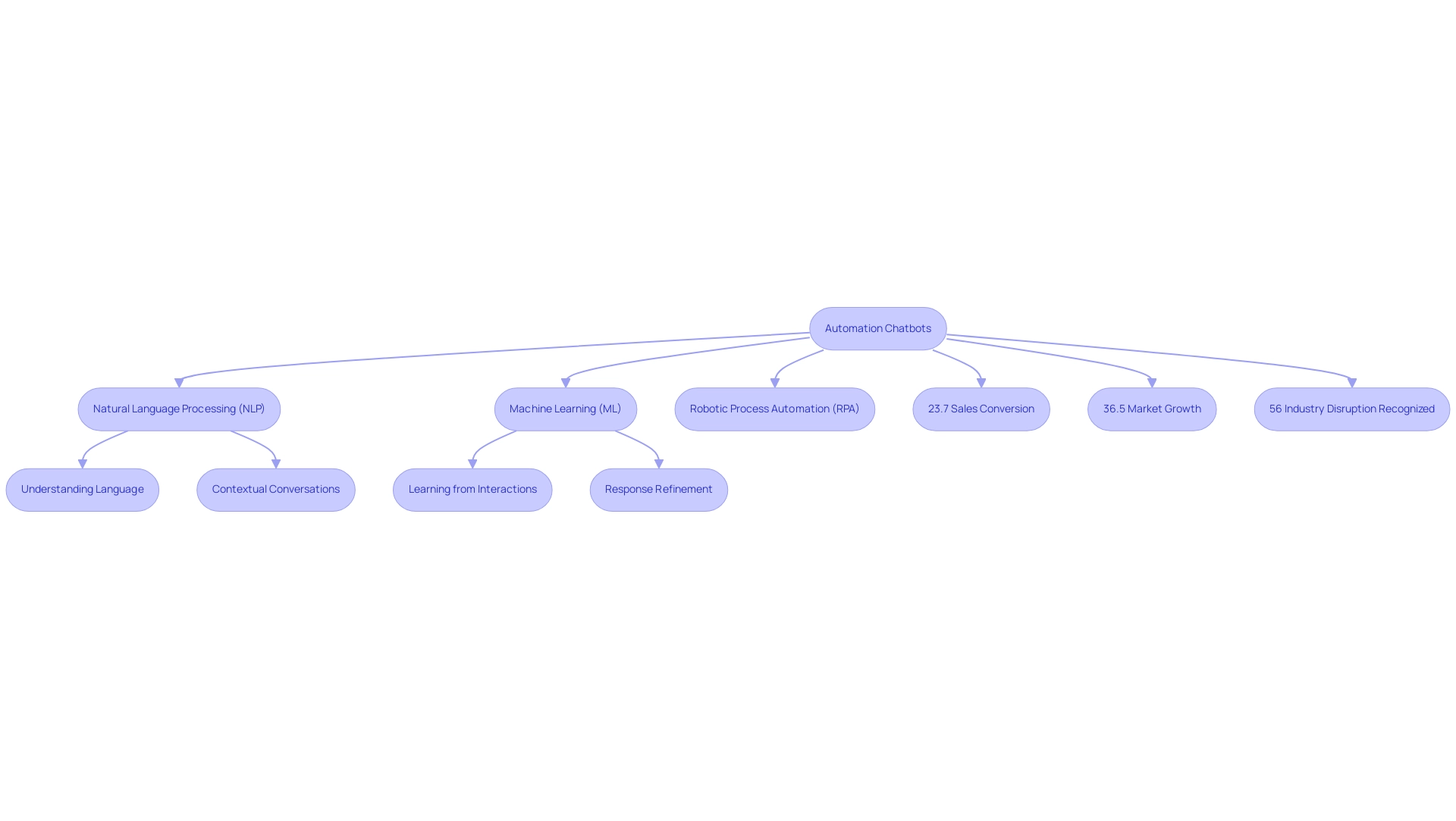
Real-World Applications: How Businesses Use Automation Chatbots
The adoption of automation chatbots is rapidly transforming client interactions across multiple sectors, demonstrating their remarkable versatility and effectiveness. In the retail landscape, brands like Domino’s Pizza have harnessed automation chatbot technology to streamline order placements and monitor deliveries, significantly enhancing customer convenience. The travel sector is also experiencing this transformation; companies like Expedia utilize an automation chatbot to manage booking inquiries and assist with travel arrangements, thereby enhancing user experiences.
Moreover, in healthcare, providers are adopting an automation chatbot as part of their automated messaging systems to facilitate appointment scheduling and handle patient inquiries, which not only streamlines administrative tasks but also fosters better patient engagement. Significantly, 23.7% of inquiries turn into sales without human involvement, emphasizing the efficiency of automated systems in driving sales. As stated by Daria Ritter, a marketer at Dashly.io, over 50% of clients appreciate engaging with AI conversational agents, highlighting their acceptance among users.
Key to this transformation is the integration of Robotic Process Automation (RPA), which automates manual workflows, leading to enhanced operational efficiency and productivity. Businesses save an impressive average of $300,000 annually through the implementation of automation chatbots, as highlighted in case studies, demonstrating the significant cost reductions associated with these technologies. However, organizations often face challenges in implementing these solutions, such as integration with existing systems and staff training.
Tailored AI solutions can help navigate these challenges effectively. These practical applications illustrate how automation programs, driven by RPA and Business Intelligence, are not only improving operational workflows but also transforming the way enterprises interact with their clients, facilitating informed decision-making that is simpler and more efficient.
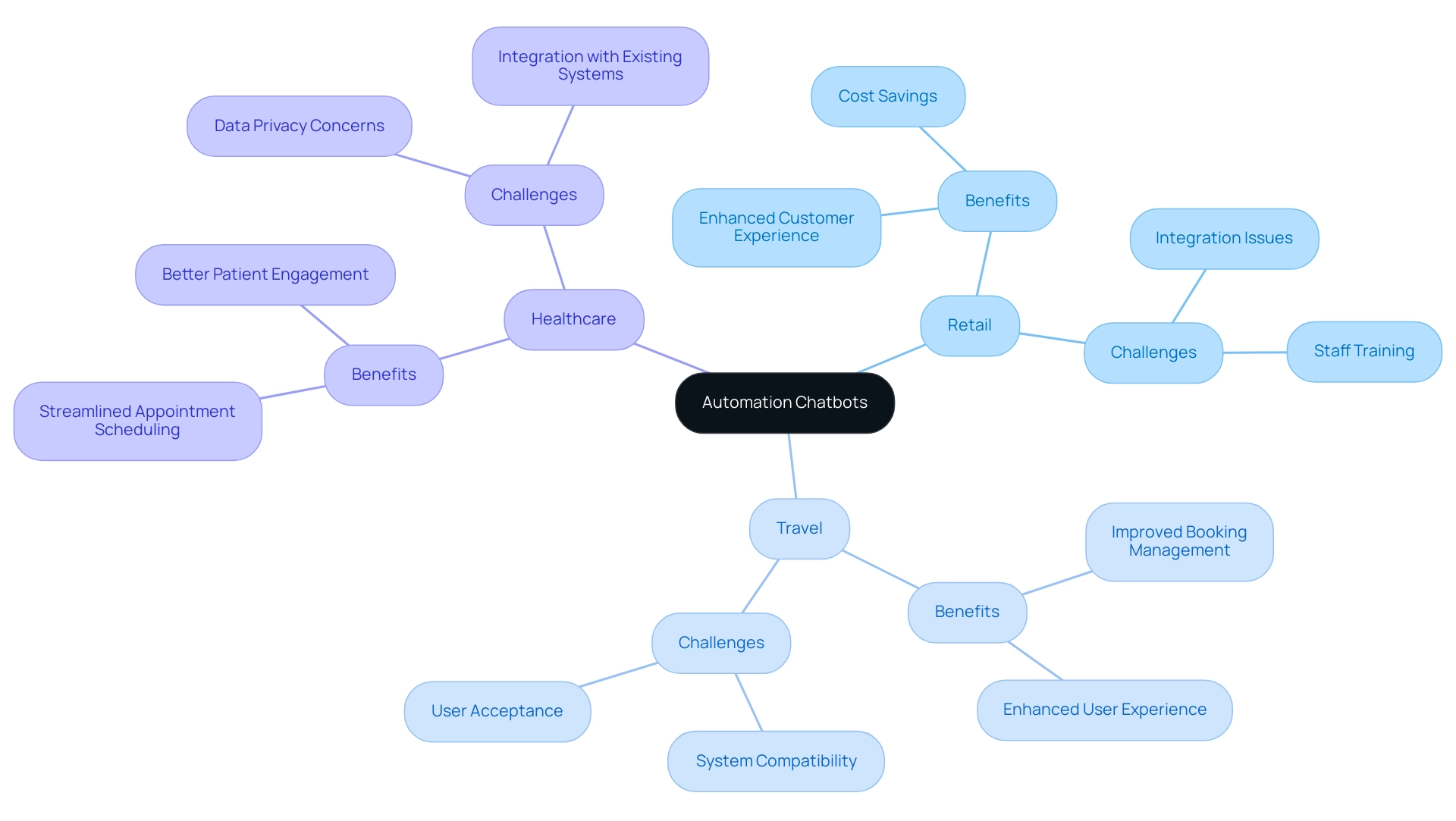
The Future of Automation Chatbots: Trends and Innovations
The landscape of automation systems is on the brink of remarkable evolution, fueled by continuous advancements in artificial intelligence and machine learning. Currently, about 60% of B2B companies and 42% of B2C businesses are harnessing automation chatbot software, signaling a significant trend toward automation in customer interactions despite common apprehensions regarding:
- Complexity
- Implementation costs
- Perceptions that AI projects are time-intensive and challenging to integrate
Innovations in natural language processing (NLP) are set to enhance these capabilities, enabling conversational agents to grasp context and sentiment, which leads to more personalized user experiences.
Furthermore, the growing prominence of voice-activated chatbots is revolutionizing how users engage with technology, facilitating hands-free communication. According to recent findings:
- 90% of businesses have reported quicker complaint resolutions thanks to automation chatbot integration.
- 83% of consumers indicated they would prefer messaging as their primary method for customer support if they could expect immediate responses, showcasing the importance of effective automation chatbot functionality.
Notably, 61% of people would find it more frustrating if a chatbot couldn’t solve a problem compared to a human. As companies work to improve operational efficiency and address data quality issues, the growth of automation systems seems unavoidable. The effective implementation of an automation chatbot, as highlighted in a recent case study, emphasizes the need for clear objectives and user-friendly designs to enhance customer interactions.
By leveraging tailored AI solutions and Robotic Process Automation (RPA), businesses can streamline manual workflows and make informed decisions that drive growth. With emerging trends paving the way for more sophisticated solutions, the future of automation chatbot technology in 2024 promises to redefine user interactions and elevate service excellence.
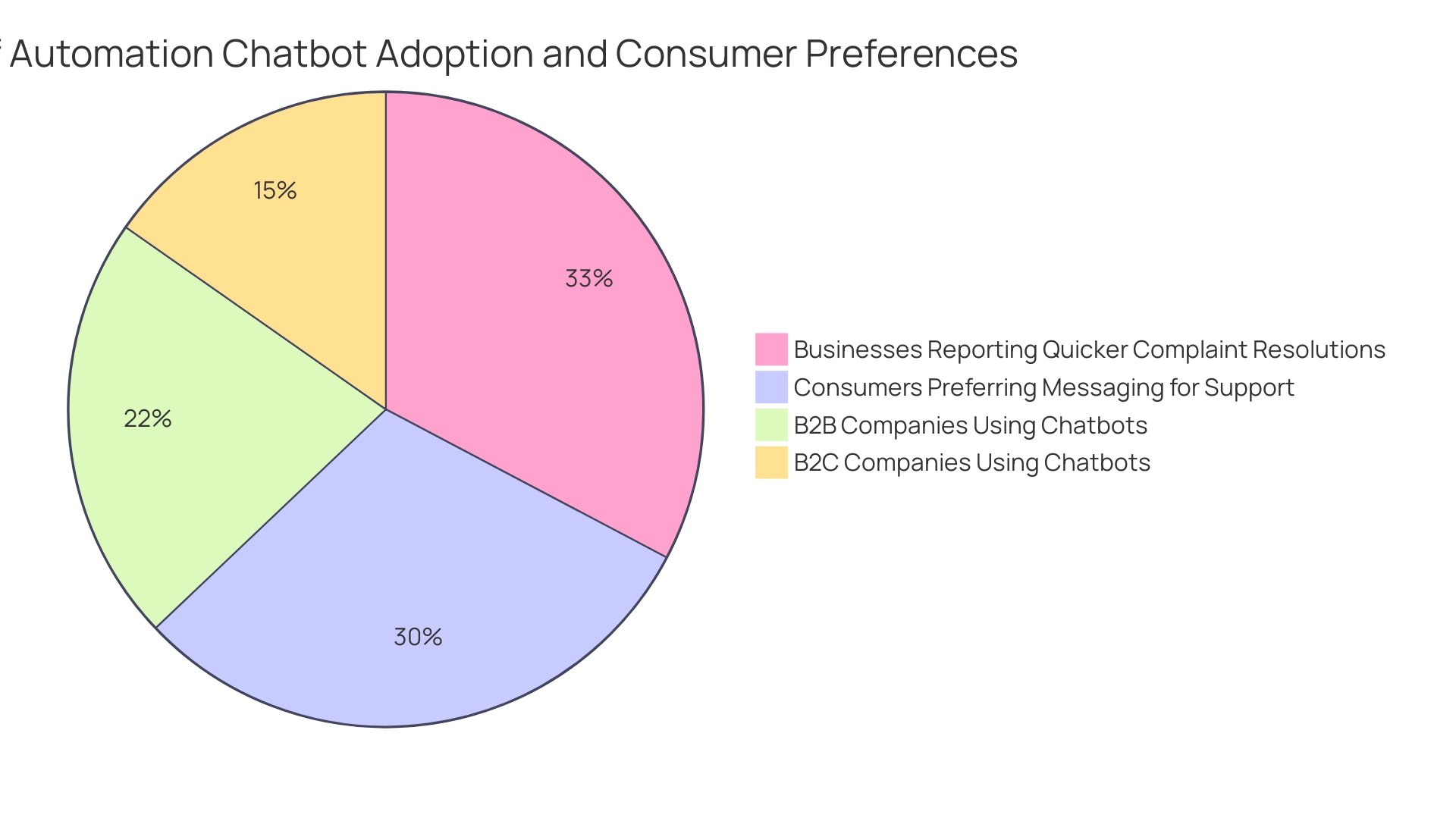
Conclusion
The rise of automation chatbots marks a pivotal moment for businesses aiming to enhance operational efficiency and customer engagement. By leveraging advanced technologies like natural language processing and machine learning, these intelligent systems are transforming how organizations interact with consumers. From improving customer service response times to driving sales conversions, the benefits of chatbots are extensive and far-reaching.
As explored in various sectors—from retail to healthcare—automation chatbots not only streamline processes but also significantly reduce operational costs. Companies are witnessing enhanced productivity and customer satisfaction, thanks to chatbots’ ability to handle multiple inquiries simultaneously and provide personalized experiences. The integration of Robotic Process Automation further amplifies these advantages, allowing human employees to focus on strategic initiatives and improve job satisfaction.
Looking ahead, the future of automation chatbots is bright, with innovations in AI and voice technology poised to redefine user interactions. As businesses continue to embrace these advancements, the potential for improved service delivery and operational efficiency becomes increasingly evident. By understanding and implementing these technologies effectively, organizations can position themselves at the forefront of customer engagement, ensuring they meet the evolving expectations of today’s consumers. Embracing automation chatbots is not just a technological upgrade; it is a strategic imperative for businesses committed to thriving in an increasingly competitive landscape.
Introduction
In the landscape of modern business, where efficiency and adaptability are paramount, unattended Robotic Process Automation (RPA) emerges as a game-changing solution. This innovative technology empowers organizations to automate repetitive tasks autonomously, freeing up valuable human resources for more strategic endeavors.
As companies increasingly seek to enhance their operational efficiency, the benefits of unattended RPA become clear:
- Significant cost savings
- Error reduction
- Improved employee satisfaction
- Continuous availability
By delving into the transformative potential of RPA, businesses can not only streamline their workflows but also position themselves for sustainable growth in an ever-evolving market. Understanding these advancements is essential for leaders aiming to harness technology effectively, ensuring their organizations thrive in a competitive environment.
Understanding Unattended RPA: A Comprehensive Overview
Unattended RPA signifies a major progress in technology, enabling software robots to operate autonomously without human involvement. Unlike attended RPA, which relies on user input, unattended RPA executes predefined workflows autonomously, effectively managing high volumes of tasks around the clock. This capability is particularly advantageous for repetitive and rule-based processes, leading to remarkable enhancements in operational efficiency.
Recent statistics reveal that, on average, workers save an impressive 3.6 hours each week through automated processes, emphasizing RPA’s potential to liberate valuable time for strategic initiatives. Furthermore, 89% of workers report heightened job satisfaction due to automated processes, underscoring RPA’s positive impact on employee morale. By exploring the mechanics of unattended RPA, organizations can unlock transformative potential, streamline workflows, and optimize resource allocation.
The evolution of RPA is shifting from standalone solutions to more comprehensive offerings, including intelligent document processing, enabling greater unattended RPA and accessibility for non-technical users. Key features of EMMA RPA, such as its user-friendly interface and efficiency tools, along with Microsoft Power Automate’s ability to transform operations, exemplify the integration of RPA with artificial intelligence and business intelligence. These advancements not only address staffing shortages and outdated systems but also highlight the ongoing evolution of RPA technology.
For any Director of Operations Efficiency, understanding these developments is crucial for leveraging technology to achieve operational excellence and drive productivity.
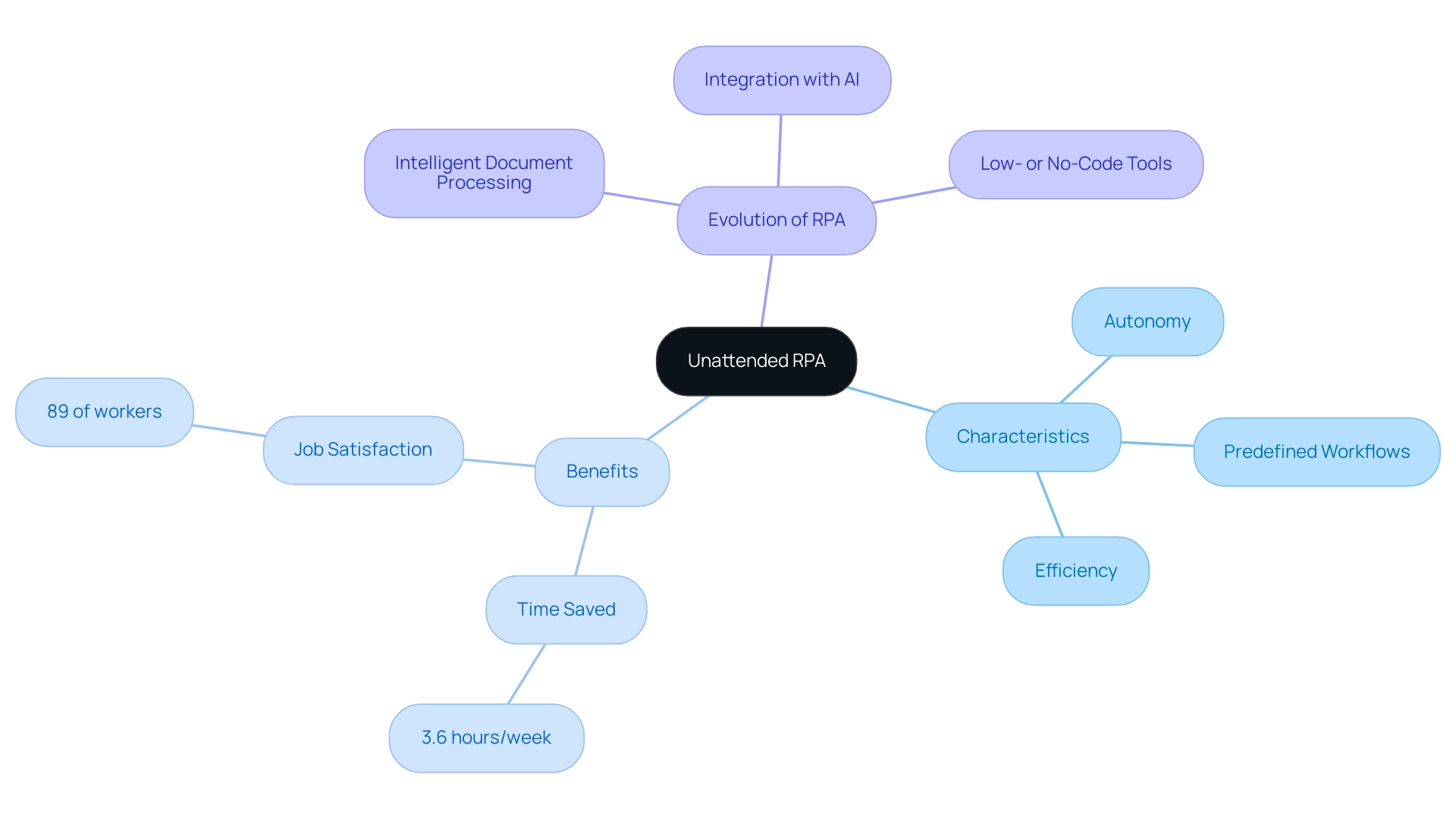
Top Benefits of Unattended RPA: Enhancing Efficiency and Productivity
-
Increased Operational Efficiency: Unattended RPA excels at automating repetitive tasks, enabling employees to focus on higher-value activities. Before executing GUI processes, a mid-sized healthcare company faced significant challenges, including manual data entry errors and slow software testing. This shift not only enhances overall productivity but also empowers teams to engage in more strategic initiatives. A case study demonstrated that by automating data entry and software testing, the company achieved a remarkable 70% reduction in data entry errors and an 80% increase in workflow efficiency. Notably, a recent study found that 83% of employees who utilize AI-powered automation believe it significantly reduces burnout while boosting job satisfaction.
-
24/7 Availability: One of the most compelling advantages of unattended RPA is its ability to function continuously without interruptions. Unlike human workers, these automated systems execute processes around the clock, ensuring that critical operations maintain consistency and reliability without any downtime. This constant operation is vital for businesses aiming to enhance service delivery, particularly in sectors like healthcare.
-
By minimizing the potential for human error, unattended RPA contributes to error reduction and enhances the accuracy of data processing and reporting. This decrease in errors not only enhances the quality of output but also fosters trust in automated systems throughout the company. The case study highlighted a significant decrease in manual data entry mistakes, showcasing RPA’s effectiveness in improving operational accuracy.
-
Faster Turnaround Times: The transformational speed at which unattended RPA can complete tasks is remarkable. Processes that once took hours or even days can now be executed in mere minutes. This rapid execution enables companies to respond swiftly to evolving market demands, thereby gaining a competitive edge. In the healthcare case, testing processes were accelerated by 50%, illustrating the time-saving impact of RPA.
-
Enhanced Compliance: Unattended RPA can be configured to adhere to regulatory requirements, ensuring that processes are consistently executed according to the latest standards. This built-in compliance reduces the risk of oversight, enabling entities to navigate complex regulatory landscapes more effectively. As industry groups work on establishing standards for RPA implementations, entities adopting these technologies will find themselves better equipped to foster a reliable and scalable ecosystem for automated processes.
In light of recent news, businesses are encouraged to evaluate which tasks are suitable for attended processes and which workflows can benefit from unattended systems. This consideration is essential for enhancing efficiency and ensuring that organizations utilize RPA effectively, as demonstrated by the success of GUI processes in driving significant improvements in healthcare service delivery. The ROI from implementing these automation solutions was achieved within 6 months, underscoring the financial benefits of RPA.
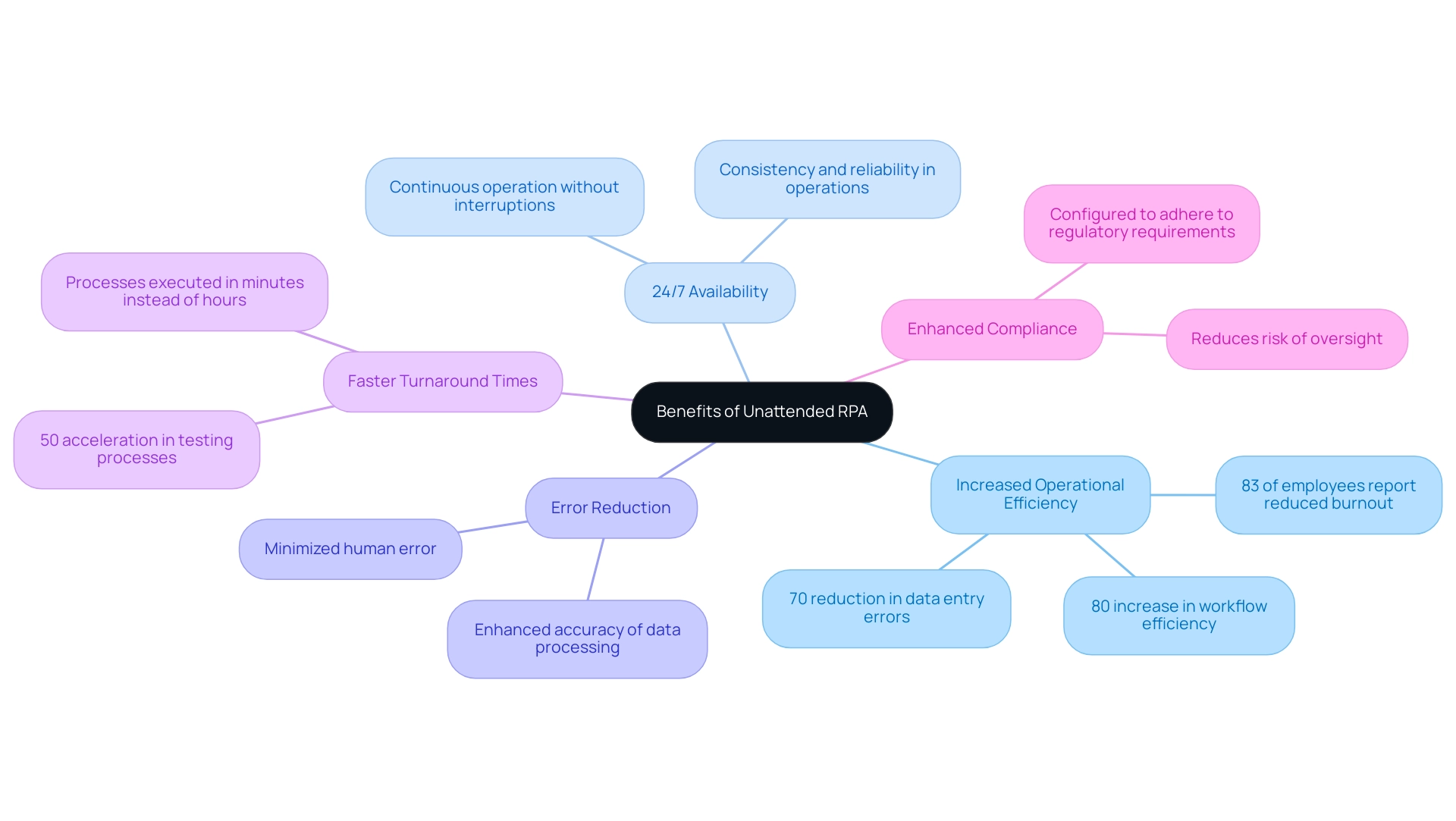
Streamlining Operations: How Unattended RPA Reduces Manual Tasks
Unattended RPA is revolutionizing operational efficiency by automating routine tasks including:
- Data entry
- Report generation
- Invoice processing
Notably, RPA can manage up to 90% of data entry tasks in clinical research, showcasing its potential to significantly enhance efficiency across various sectors. In finance departments, unattended RPA streamlines account reconciliation, significantly cutting down the time needed for manual checks and reducing errors.
This transition not only accelerates processes but also alleviates the exhaustion caused by repetitive tasks, empowering finance teams to focus on strategic financial planning and analysis. By addressing these burdens, entities can cultivate a more engaged and motivated workforce, thus significantly boosting job satisfaction and overall productivity.
As we address common workplace challenges, such as staffing shortages and outdated systems, the case study titled ‘Cost-Effectiveness of RPA’ illustrates that the advantages of Robotic Process Automation increasingly outweigh the costs of implementation.
Furthermore, tailored AI solutions can enhance decision-making by providing insights that align with specific business goals. Experts agree that the benefits of RPA are becoming a compelling investment for businesses seeking to optimize their operations and navigate the rapidly evolving AI landscape.
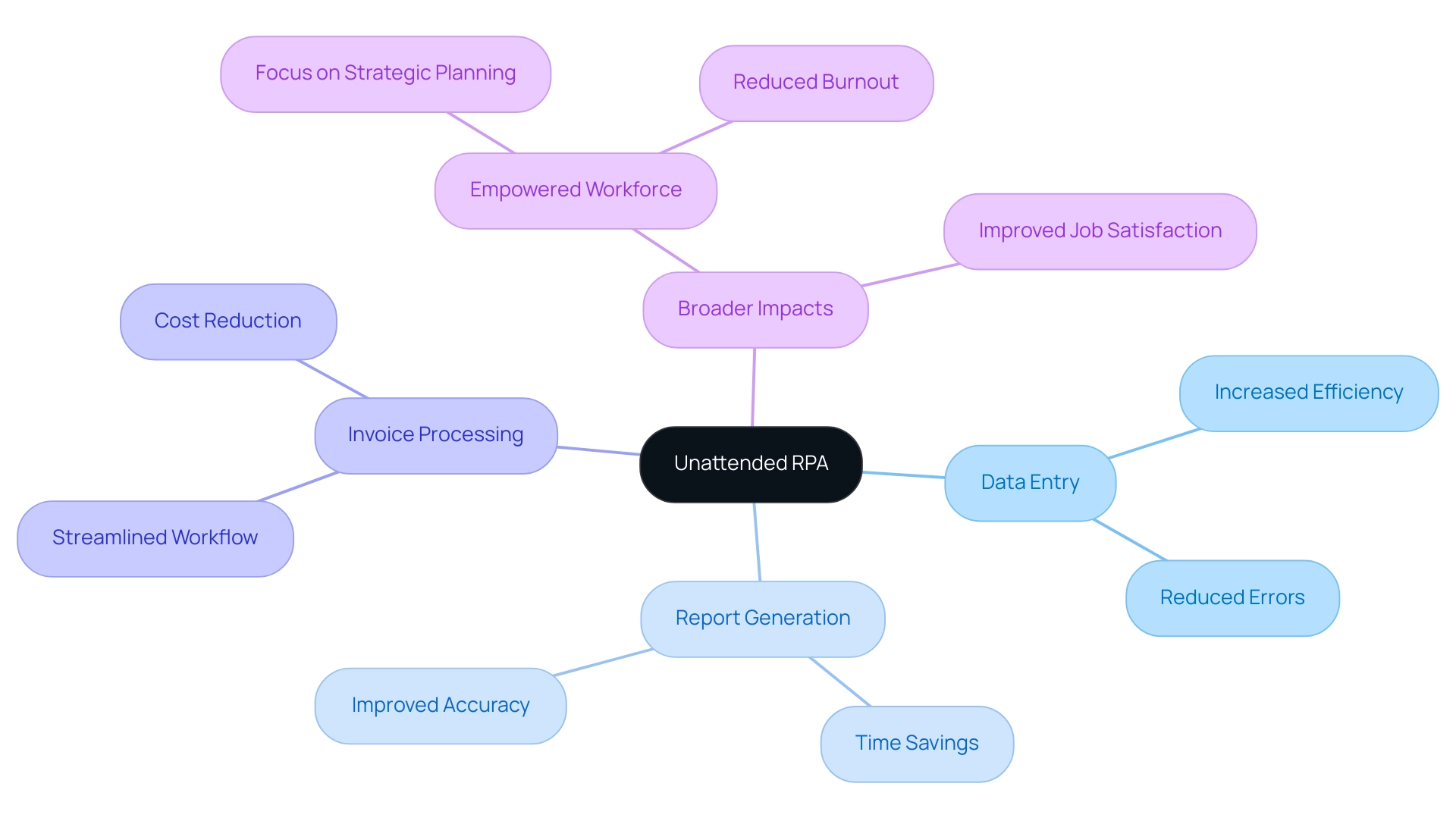
Cost Savings Through Automation: The Financial Benefits of Unattended RPA
Implementing unattended RPA can lead to substantial cost savings for companies. By automating repetitive tasks, businesses can significantly lower labor costs linked to manual processing. For instance, companies that automate data entry tasks often report annual savings amounting to thousands of dollars in labor expenses.
Furthermore, the reduction in errors minimizes costs associated with rework and alleviates the financial burden of compliance penalties. Recent studies indicate that entities embracing RPA can expect to see a return on investment (ROI) as high as 300% within the first year of implementation. This compelling data positions unattended RPA as a financially prudent strategy for enhancing operational efficiency and driving overall productivity.
Additionally, as the rapidly evolving AI landscape presents challenges, tailored AI solutions can help businesses identify the right technologies that align with their specific goals. Industry bodies are establishing standards for RPA implementations to ensure best practices and security, which is crucial for organizations considering this technology. As noted by SaltStack, ‘Our investment in automation has yielded financial growth,’ emphasizing the tangible benefits achievable through strategic RPA deployment.
Furthermore, small and medium enterprises (SMEs) are expected to embrace RPA solutions at a growth rate of 25% each year, emphasizing the rising trend and significance of RPA in fostering data-driven insights and efficiency for business growth. Importantly, leveraging Business Intelligence can transform raw data into actionable insights, enabling informed decision-making that further enhances productivity and growth.
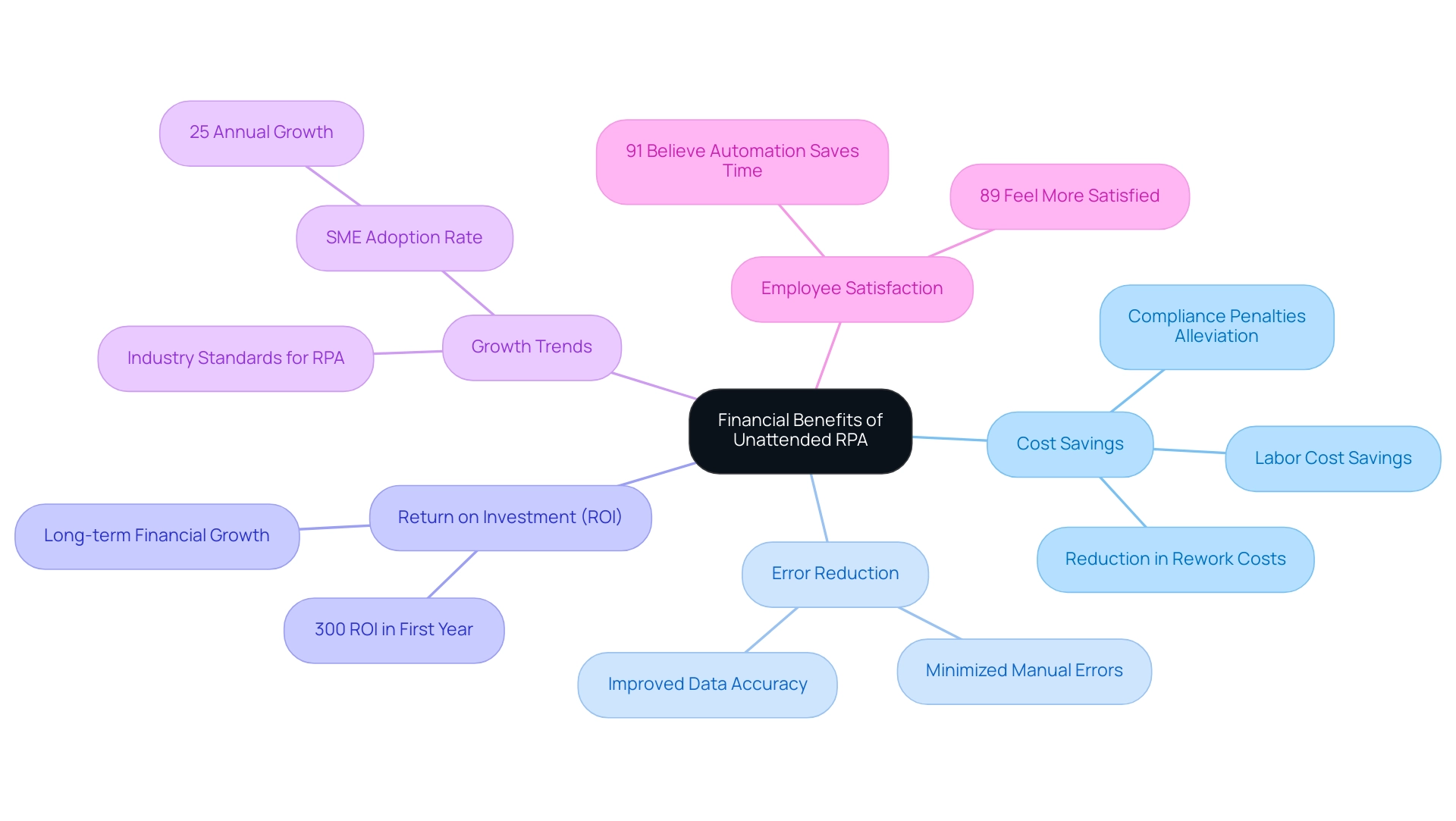
Scalability and Flexibility: Adapting Unattended RPA to Business Growth
Unattended RPA is distinguished by its exceptional scalability and flexibility, making it a powerful tool for organizations experiencing growth. Manual, repetitive tasks can significantly hinder efficiency, leading to wasted time and resources. As business demands shift, unattended RPA can be effortlessly scaled to accommodate increased workloads, requiring minimal additional investment.
Notably, Dell has leveraged RPA to boost HR productivity by up to 85%, showcasing its effectiveness in enhancing productivity. Moreover, recent discoveries suggest that 79% of employees credited considerable productivity increases to mechanization, with an average time savings of 3.6 hours per week. This is especially beneficial for sectors with fluctuating demands; for instance, retailers can deploy additional unattended RPA to manage surges in transaction volumes during peak seasons.
Such adaptability not only helps maintain efficiency but also enhances responsiveness to market changes, positioning organizations for sustained success with the use of unattended RPA. Additionally, RPA streamlines workflows by reducing errors and freeing up your team to focus on more strategic, value-adding work.
- 83% of employees using AI-powered automation believe it can reduce burnout and enhance job satisfaction, highlighting the broader implications of RPA on workforce well-being.
As Nick Ostdick, a content developer, succinctly puts it, ‘The flexibility of RPA allows businesses to adapt swiftly to changing needs, ensuring they stay competitive.’ This sentiment reinforces the importance of leveraging RPA alongside tailored AI solutions and Business Intelligence to drive data-driven insights and operational efficiency for business growth.

Conclusion
Unattended Robotic Process Automation (RPA) is transforming the way organizations operate by significantly enhancing efficiency, reducing costs, and improving employee satisfaction. By automating repetitive tasks, businesses can liberate valuable human resources, allowing employees to focus on higher-value activities that drive strategic growth. The evidence is compelling: organizations that implement RPA can achieve remarkable operational efficiencies, with some reporting up to 300% ROI within the first year of deployment.
The benefits of unattended RPA extend beyond mere cost savings. With continuous availability and reduced error rates, companies enjoy enhanced reliability and compliance in their operations. This technology not only accelerates turnaround times but also empowers teams to tackle more complex challenges, ultimately fostering a more engaged workforce. As organizations adapt to the rapidly changing business landscape, the scalability and flexibility of RPA become critical assets, enabling them to respond swiftly to market demands.
In conclusion, embracing unattended RPA is not just a strategic move; it is an essential step towards sustainable operational excellence. By leveraging this innovative technology, organizations can optimize workflows, enhance productivity, and position themselves for long-term success in an increasingly competitive environment. The time to invest in automation is now, as the transformative potential of RPA paves the way for a more efficient, cost-effective, and empowered future.
Introduction
In an increasingly interconnected world, organizations are seeking powerful solutions to streamline their operations and enhance productivity. Rumba Software emerges as a pivotal tool, designed to integrate diverse applications and automate workflows, thereby reducing the burden of manual processes. By facilitating seamless data exchange, it not only minimizes errors but also allows teams to focus on strategic initiatives that drive growth.
With a growing emphasis on operational efficiency, especially in sectors like healthcare and animation, Rumba Software proves that investing in automation can lead to significant improvements in performance and employee morale.
This article delves into the multifaceted capabilities of Rumba Software, exploring its features, future developments, and the transformative impact it can have on various industries.
Introduction to Rumba Software: Purpose and Functionality
The platform stands out as an essential tool for integrating various applications and systems, facilitating smooth information exchange and enhancing operational efficiency. Its core functionality revolves around automating and optimizing workflows, significantly minimizing the need for manual input and the associated risks of errors. By effectively linking disparate systems, the application not only enhances productivity but also enables organizations to focus on strategic initiatives instead of getting bogged down by repetitive tasks.
In a landscape where precise and timely information synchronization across multiple platforms is critical, understanding what is rumba software ensures that details remain current and reliable. Notably, improving sales close rates is the #1 reason companies invest in integrations, as highlighted in the State of SaaS Integrations Report. This capability is particularly vital, given that 67% of companies prioritize integrations to boost sales close rates.
Furthermore, case studies, such as the one on ‘Streamlining Operations with GUI Automation,’ illustrate how implementing RPA solutions like EMMA RPA and Microsoft Power Automate can transform business operations. By tackling specific challenges like manual information entry errors and slow software testing, these resources enhance efficiency and employee morale, ultimately resulting in improved sales performance with:
- 50% better conversions
- 40% faster deal cycles
Importantly, the ROI from these implementations was achieved within six months, showcasing the effectiveness of addressing critical issues like data security and service reliability.
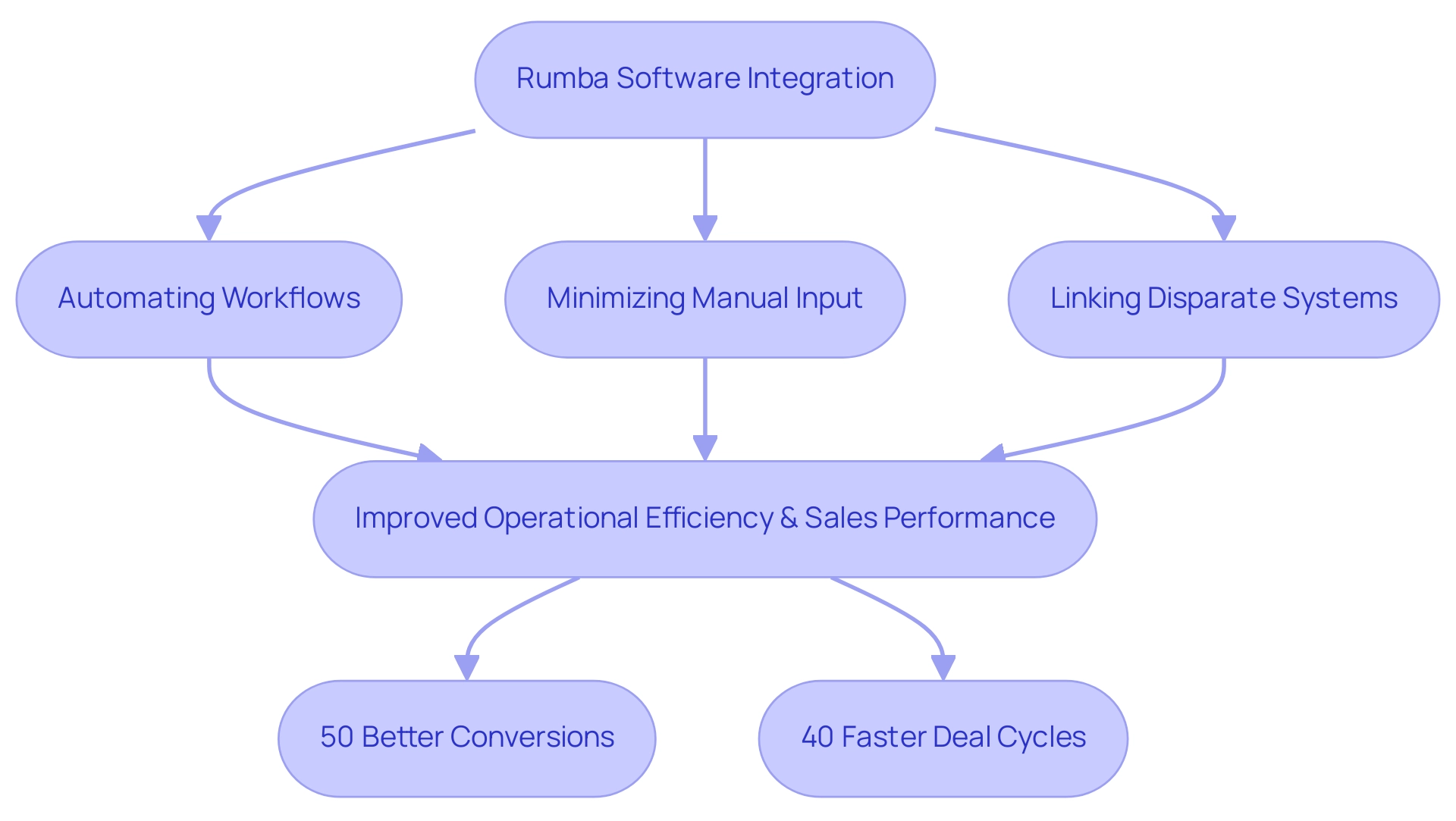
Key Features of Rumba Software: Real-Time Playback and User Experience
Power Automate and EMMA RPA stand out as transformative solutions for streamlining workflow automation and enhancing productivity. By facilitating seamless digitalization, these resources not only enable organizations to create dynamic automated workflows that link applications and services but also tackle essential workplace challenges such as repetitive tasks and outdated systems. This is especially vital for Directors of Operations Efficiency, facing issues like talent retention and the impact of mundane tasks on team morale.
The user-friendly nature of these solutions ensures that teams can quickly adapt, reducing the learning curve and boosting operational efficiency. Moreover, features like AI-powered capabilities enhance automation accessibility. Research suggests that improving user experience can lead to significant returns, with every dollar spent on UX potentially yielding $10 to $100.
Thus, investing in user-centric automation tools like Power Automate and EMMA RPA not only enhances productivity but also positions organizations for long-term success by modernizing their operational frameworks. Book a free consultation to discover how these solutions can transform your operations.

The Future of Rumba Software: Roadmap and Upcoming Features
What is rumba software’s upcoming roadmap set to unveil? It will feature a suite of innovative enhancements designed to significantly improve user experience and expand its functional capabilities. Central to these enhancements are Small Language Models (SLMs) that provide efficient, secure, and cost-effective analysis, empowering users to derive deeper insights from their workflows and ultimately driving smarter decision-making processes. Notably, SLMs provide improved privacy by enabling on-premises deployment, ensuring better security and compliance.
As Rhiannon Stone observes, “Data-as-a-service solutions are so popular that their global market value has a compound annual growth rate of 28.1%,” emphasizing the significance of these resources in today’s landscape. Furthermore, our Power BI services will ensure improved reporting and actionable insights, featuring a 3-Day Sprint for rapid report creation and a General Management App for comprehensive oversight. The integration of popular enterprise applications will be streamlined, creating a more cohesive work environment that boosts overall productivity.
Embracing these technological advancements positions this company not just as an instrument, but as a strategic ally in achieving operational efficiency. Additionally, Gartner predicts that by the end of the year, 60% of the data used by AI and analytics solutions will be synthetic data, emphasizing the need for cutting-edge analytics features. As industry experts forecast, the demand for sustainability-enabled monitoring services is expected to rise by 35% between 2024 and 2027, underscoring the importance of adapting to these trends to remain competitive in the evolving landscape of operational software.
The case study titled ‘Communicating the Need for New Instruments’ illustrates how analysts can present clear cases highlighting current resource limitations and how the new features from the company can address these gaps, delivering potential time savings and enhanced accuracy. To explore how these innovations can benefit your organization, book a free consultation today.
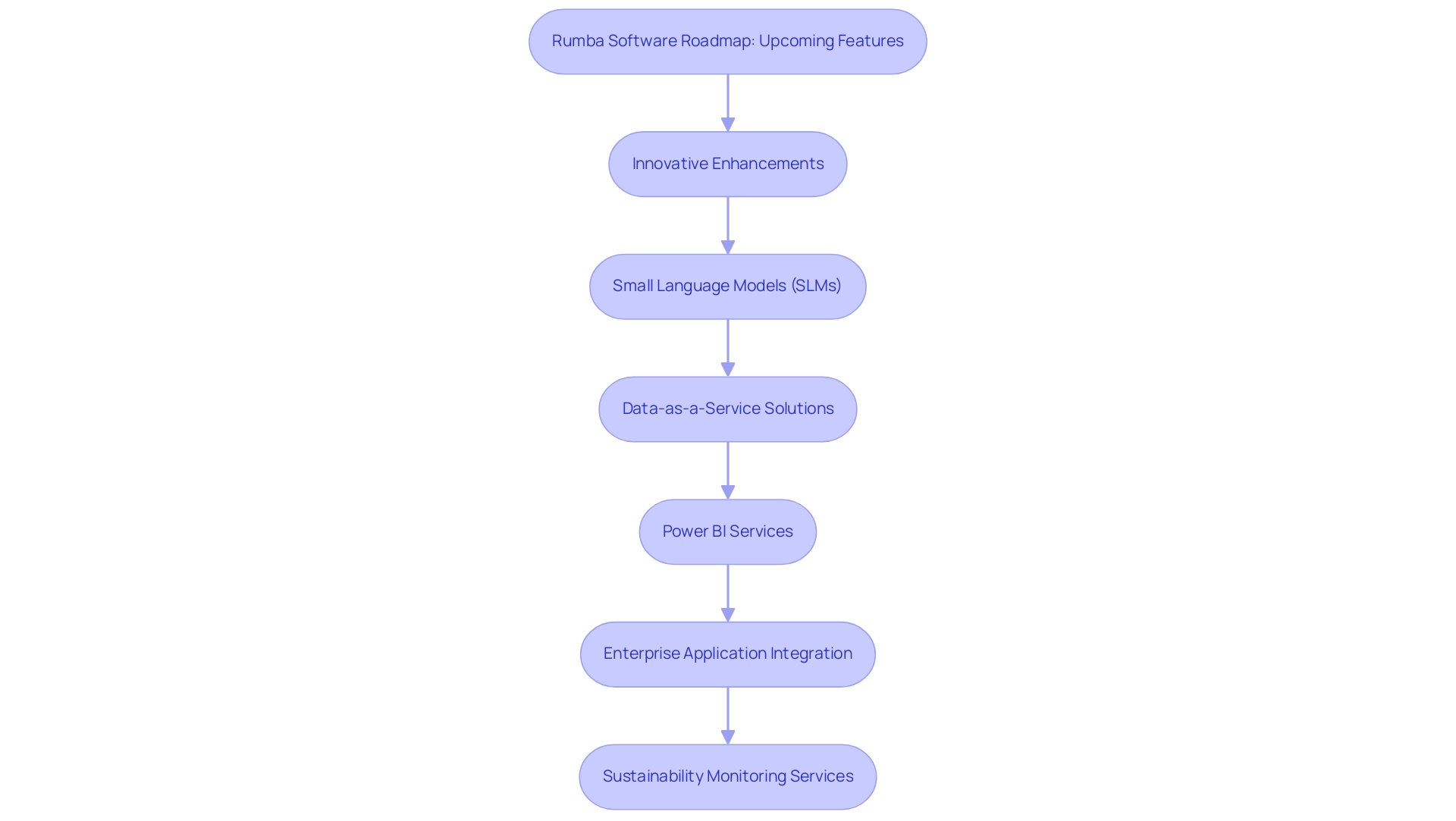
Accessing Rumba Software: Availability and Licensing Options
The platform provides a range of licensing formats designed to satisfy the various requirements of its users, especially in improving operational efficiency through Robotic Process Automation (RPA). For individuals and small teams, a non-commercial use version is available, allowing them to explore the software’s robust functionalities without any financial obligations. This encourages small organizations to leverage RPA and tailored AI solutions, aligning with the growing trend towards cost-effective technology adoption.
Notably, patent licensing revenues from the European Union grew by 8% in 2023, reflecting a commitment to innovation and intellectual property protection, which is crucial for businesses looking to implement RPA effectively. Conversely, larger organizations can benefit from a range of commercial licensing options that not only provide advanced features but also enhanced support for driving data-driven insights and operational efficiency. With the global patent litigation market valued at $30 billion, understanding these licensing trends is vital for businesses aiming to navigate intellectual property challenges while optimizing their workflows.
As industry experts note, substantial enhancements have been made to improve the consistency, readability, and usability of report columns within these software tools, further underscoring the importance of selecting the right licensing format to support strategic initiatives. By recognizing the significance of these licensing options and market statistics, organizations can make informed decisions that bolster their RPA implementation and overall productivity.
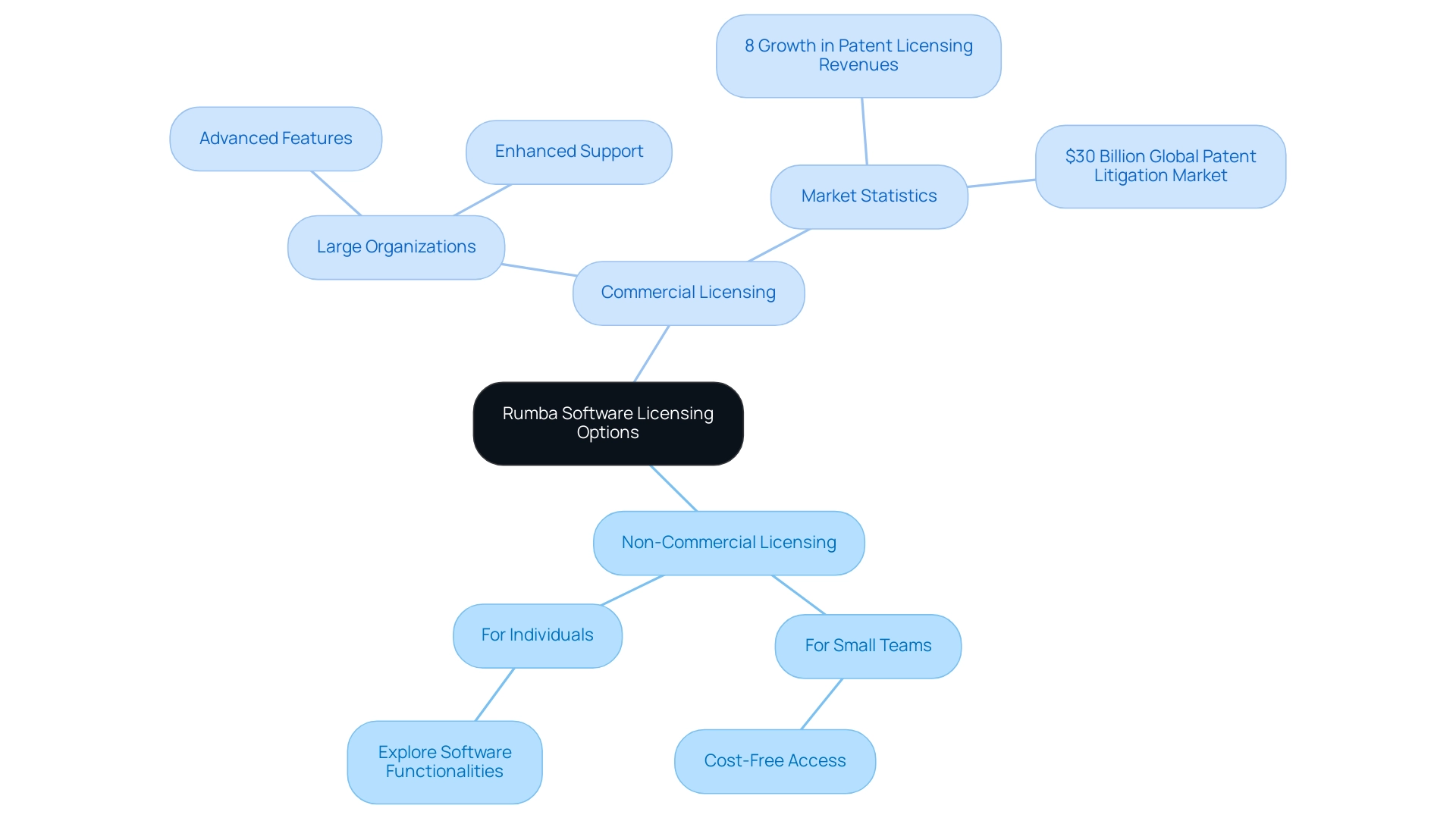
Rumba Software in Animation: Transforming Creative Workflows
What is Rumba Software? It is designed to transform creative processes in the animation sector by automating essential tasks such as rendering and information management. This reflects the significant advancements observed in the healthcare sector, where a mid-sized company encountered challenges such as manual information entry errors, slow software testing, and difficulty integrating outdated systems. By employing GUI automation, the company optimized operations, resulting in a remarkable 80% enhancement in workflow efficiency and a 70% decrease in entry errors.
With the global healthcare automation market projected to grow at a rate of 8.415% over the next seven years, similar trends in animation are emerging, driven by consumer demand and technological advancements. By incorporating the animation tool into their pipelines, animation studios can significantly streamline their processes, much like the healthcare provider that accelerated testing procedures by 50% through automation. This transformation allows animators to focus more on creativity rather than technical bottlenecks, fostering improved collaboration across teams.
Furthermore, the software’s capability for real-time data exchange ensures that animators always have access to the latest project updates, promoting a more agile and responsive creative environment. As the need for creative animation solutions keeps increasing, tools such as this program will be crucial in improving workflow efficiency, ultimately propelling the industry’s development and profitability. According to Nick Rockwell, a Content Marketing Manager, > 48% of companies are implementing automated systems right now <, underscoring the urgency for studios to adopt such technologies.
Additionally, platforms like Kissflow offer low-code/no-code solutions that can complement what is Rumba Software, providing studios with a range of automation options tailored to their specific needs. Notably, the healthcare company achieved a significant ROI within six months, further highlighting the potential benefits of automation in enhancing operational efficiency.

Conclusion
Rumba Software emerges as a transformative solution for organizations striving to enhance operational efficiency across various sectors. By seamlessly integrating diverse applications and automating workflows, it significantly reduces the manual workload and associated errors, allowing teams to focus on strategic initiatives that drive growth. The insights from case studies and industry reports underscore the vital role of Rumba Software in improving sales performance and fostering employee morale, which are crucial for sustaining a competitive edge.
The features of Rumba Software, particularly its user-friendly automation tools like Power Automate and EMMA RPA, not only modernize operational frameworks but also empower teams by alleviating the burden of repetitive tasks. The anticipated advancements in technology, including Small Language Models and enhanced data reporting capabilities, position Rumba Software as a strategic partner in navigating the complexities of today’s business landscape.
As organizations continue to prioritize efficiency and innovation, the diverse licensing options available for Rumba Software ensure that both small teams and large enterprises can leverage its capabilities effectively. The potential for significant ROI and improved workflow efficiency, as evidenced in both healthcare and animation sectors, highlights the urgency for companies to adopt such solutions. Embracing Rumba Software is not merely an investment in technology; it is a commitment to transforming operations for a more productive and agile future.
Introduction
In the rapidly evolving landscape of automation, the role of the RPA Supervisor emerges as a cornerstone for organizations looking to harness the full potential of robotic process automation (RPA). As businesses navigate the complexities of AI implementation, the RPA Supervisor not only addresses common challenges such as:
- Data quality
- Misconceptions about automation costs
but also ensures that robotic processes operate seamlessly. With the global healthcare automation market projected to expand significantly, the RPA Supervisor’s ability to monitor, manage, and optimize these processes becomes crucial.
This article delves into the multifaceted responsibilities of the RPA Supervisor, highlighting its impact on:
- Operational efficiency
- Employee satisfaction
- The overall success of automation initiatives
By exploring the benefits, challenges, and strategic considerations associated with this pivotal role, organizations can better position themselves for a future where automation drives innovation and growth.
Introduction to RPA Supervisor: Key Functions and Importance
The RPA Supervisor is essential as a management layer in robotic process automation (RPA) environments, vital for addressing common challenges associated with AI implementation, including issues related to poor master data quality and misunderstandings regarding the complexity and costs of AI adoption. This position is primarily responsible for monitoring, managing, and optimizing the performance of robotic processes, ensuring automation workflows operate smoothly and efficiently. Many organizations hesitate to adopt AI due to uncertainty about where to start and the perceived time-intensive nature of AI projects.
In this context, the RPA Supervisor serves as a centralized control point, swiftly addressing any issues that may arise during execution. For instance, a case study of a mid-sized healthcare company revealed that implementing GUI mechanization led to a 70% reduction in data entry errors and a 50% acceleration in software testing processes. The global healthcare technology market is anticipated to expand at a rate of 8.415% over the next seven years, emphasizing the significance of RPA in improving operational efficiency in healthcare.
According to PwC, the possible impact of technology and AI on the global economy might attain an astonishing $15.7 trillion by 2030. Furthermore, 35% of small and medium enterprises attribute enhanced customer service and support capabilities to mechanization. In this context, the RPA Manager’s role becomes even more critical, enabling organizations to navigate the complexities of AI implementation and enhance operational consistency and quality.

Operational Mechanics: How RPA Supervisor Orchestrates Automation
The RPA Manager is vital to the operational structure of robotic process optimization, fulfilling multiple critical roles. Its primary role is to oversee the equitable distribution of tasks among various robots, optimizing resource utilization to enhance productivity and minimize downtime. This orchestration is essential, as studies show that:
- 91% of employees consider mechanization a time-saving tool that enhances work-life balance.
- 89% experience greater job satisfaction from these efficiencies.
Moreover, 83% of employees utilizing AI-driven systems believe it greatly decreases burnout and improves job satisfaction, emphasizing the substantial positive impact of RPA on employee morale.
Aside from task management, the RPA Manager facilitates real-time oversight of robotic processes, enabling the quick detection and resolution of possible issues. This proactive approach not only enhances operational efficiency but also promotes continuous improvement by collecting data on process performance. By utilizing analytics, the RPA Supervisor can provide actionable insights that guide future operational strategies.
Key features of EMMA RPA include its user-friendly interface that simplifies the management of complex workflows, while Microsoft Power Automate offers seamless integration with existing applications to streamline processes. As Deloitte points out, while scaling RPA poses challenges—with only 3% of organizations successfully expanding their digital workforce—the right orchestration and monitoring practices can dramatically improve the effectiveness of RPA initiatives. By addressing these scaling challenges through efficient task orchestration and proactive monitoring, the RPA supervisor plays a vital role in driving operational excellence and ensuring the successful implementation of automation technologies.
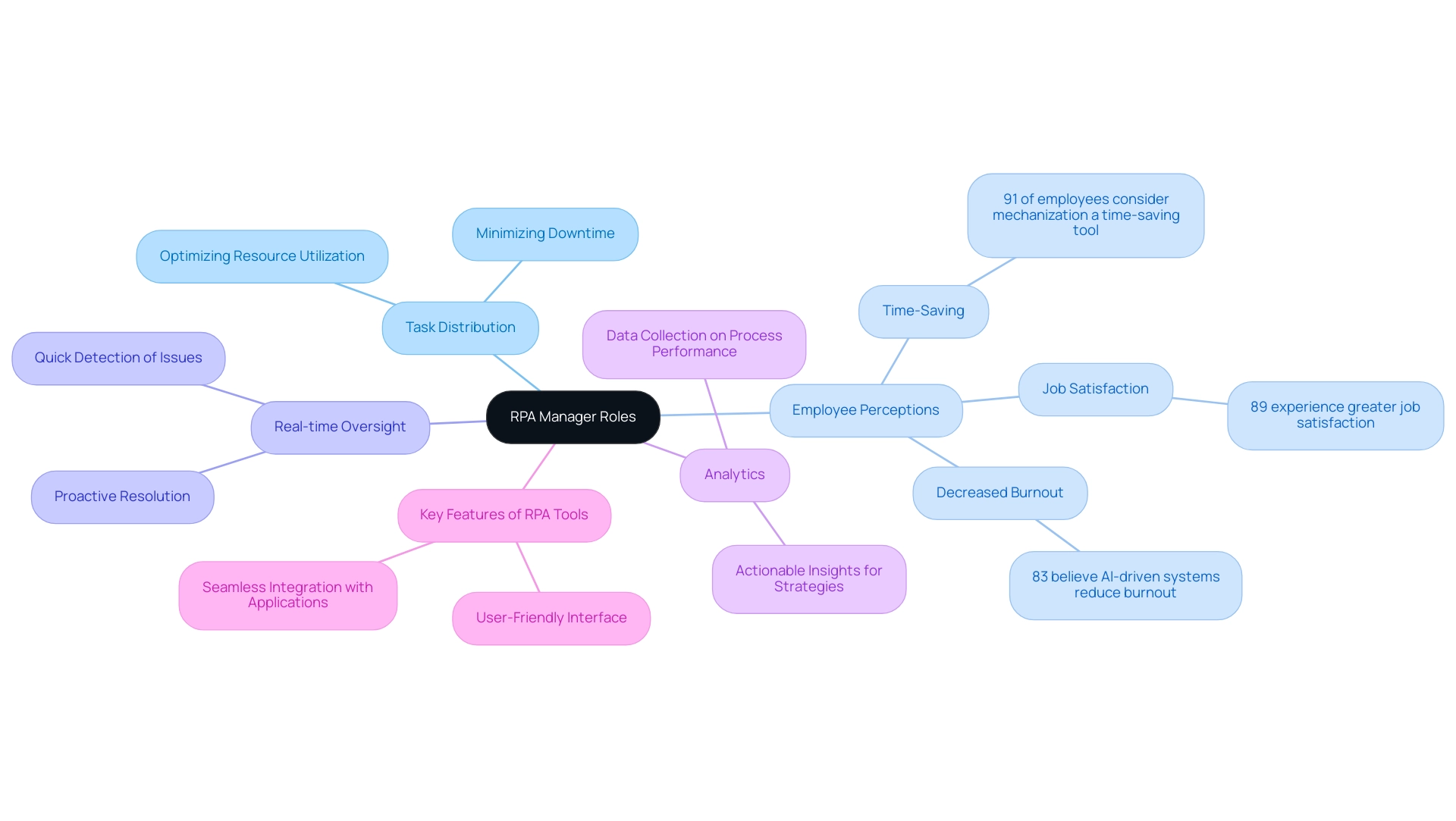
Benefits of Implementing an RPA Supervisor
The implementation of an RPA Manager brings a myriad of advantages that can significantly elevate organizational performance. A key benefit is the substantial reduction in operational errors; with the RPA Manager closely monitoring robotic processes, potential issues can be swiftly identified and resolved, enhancing the accuracy of automated tasks. This oversight is crucial, as Bill Gates aptly stated, ‘Automation applied to an efficient operation will magnify the efficiency; applied to an inefficient operation will magnify the inefficiency.’
By optimizing task allocation, the RPA supervisor ensures that robotic systems operate at their peak capacity, which results in faster processing times and a notable decrease in operational costs. Furthermore, this role liberates human resources from mundane, repetitive tasks, enabling teams to concentrate on higher-value activities that foster innovation and strategic growth. In a rapidly evolving AI landscape, companies such as Coca-Cola have experienced significant improvements in operational efficiency and employee satisfaction following the integration of the RPA supervisor.
With 91% of employees affirming that automation enhances time management and work-life balance, and 83% believing that AI-powered automation can help reduce burnout and enhance job satisfaction, the positive impact of RPA is clear. Moreover, by applying Business Intelligence to transform raw data into actionable insights, entities can make informed decisions that drive growth and innovation. Lean Six Sigma principles can further optimize processes, making the RPA supervisor a vital tool for driving employee satisfaction and reducing burnout.
However, entities must navigate the challenges posed by the rapidly evolving AI landscape to fully realize these benefits.
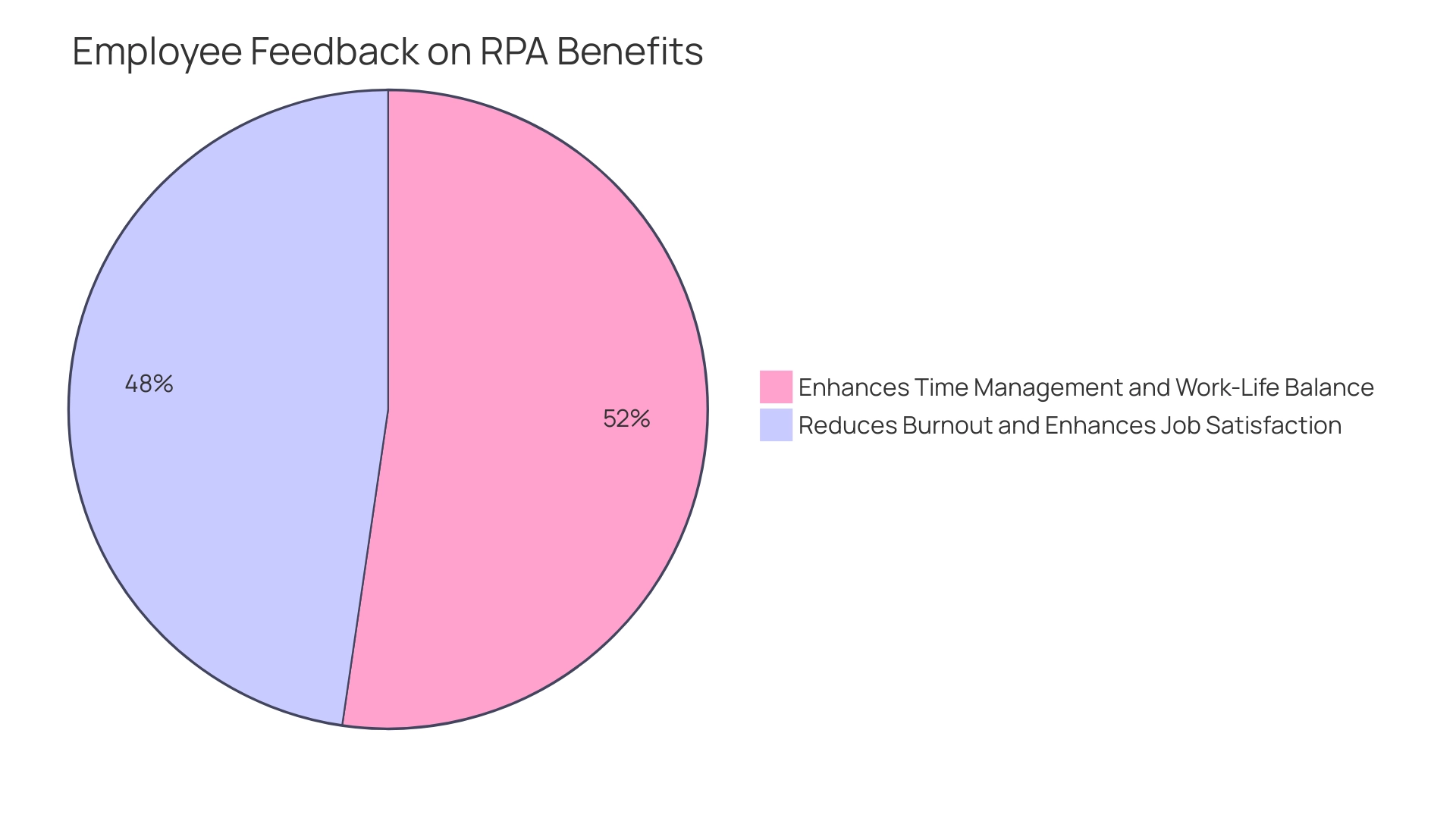
Challenges and Considerations in RPA Supervision
The implementation of an RPA supervisor brings remarkable benefits, such as boosting efficiency and reducing errors, but organizations face several challenges that must be addressed for a successful transition. A primary hurdle is the resistance from employees who may harbor fears about job displacement due to mechanization. With research indicating that by 2030, nearly 47% of jobs in the US face a high risk of being impacted by machinery, addressing these concerns is more urgent than ever.
Furthermore, the Business Process Automation (BPA) market is anticipated to expand from an estimated revenue of $13.7 billion in 2023 to $41.8 billion by 2033, emphasizing a significant transition towards streamlining across various sectors. To mitigate resistance, it is essential to implement robust communication and training strategies that clearly articulate the advantages of RPA, demonstrating how it can enhance employees’ current roles rather than replace them. Tajammul Pangarkar, CMO at Prudour Pvt Ltd, highlights the significance of adjusting to these changes, stating, ‘In the ever-evolving tech landscape, understanding the role of mechanization is crucial for future success.’
Furthermore, equipping the RPA supervisor with advanced tools and technologies is vital for effectively managing complex automation workflows. Investing in comprehensive training programs for RPA supervisors not only maximizes their potential but also ensures that each RPA supervisor can lead their teams through this transition successfully. For instance, case studies reveal that entities facing challenges during RPA Supervisor implementation often struggled with employee buy-in and required tailored training approaches to address specific fears and misconceptions.
Regular assessment of RPA strategies is also essential to align with changing business needs, ensuring that RPA Supervisors continue to be integral to the entity’s operational goals. By proactively addressing employee apprehensions and continuously refining RPA implementation approaches, organizations can pave the way for a smoother transition and enhanced productivity. Additionally, leveraging Business Intelligence in conjunction with RPA can transform raw data into actionable insights, further supporting informed decision-making that drives growth and innovation.
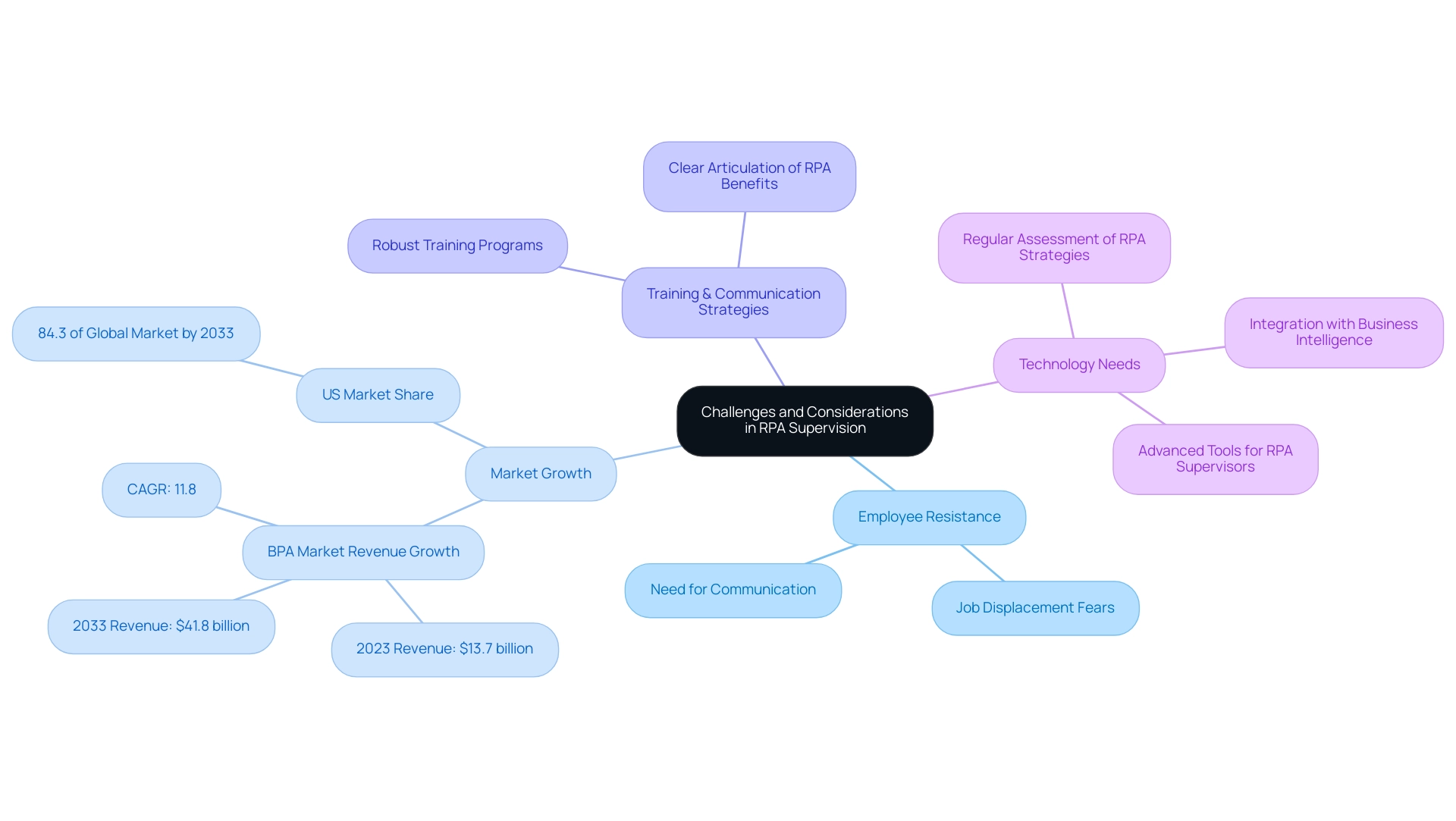
Conclusion
The role of the RPA Supervisor is pivotal in navigating the complexities of robotic process automation, serving as a bridge between technology and operational excellence. By addressing key challenges such as data quality and misconceptions about automation costs, the RPA Supervisor empowers organizations to fully leverage the potential of AI. With the healthcare automation market set to grow significantly, the importance of this role cannot be overstated, as it directly impacts operational efficiency, employee satisfaction, and the success of automation initiatives.
Implementing an RPA Supervisor not only enhances the accuracy and speed of automated processes but also alleviates the burden of repetitive tasks from human resources. This shift allows teams to focus on higher-value activities that foster innovation and drive strategic growth. The positive feedback from employees regarding automation’s impact on work-life balance and job satisfaction underscores the transformative power of this role in the workplace.
However, organizations must remain vigilant about the challenges that accompany automation, particularly employee resistance and the need for effective communication and training. By fostering a culture that embraces change and investing in the continuous development of RPA Supervisors, businesses can ensure a smoother transition to automation. Ultimately, the RPA Supervisor stands as a critical asset in driving not only operational excellence but also a future where innovation and growth become the norm in an increasingly automated world.
Discover how our tailored RPA solutions can optimize your operations—contact us today to learn more!
Introduction
In the ever-evolving healthcare landscape, the prior authorization process stands as a critical yet challenging hurdle for providers and patients alike. This essential mechanism ensures that necessary treatments are approved by insurance companies, safeguarding patient care while managing costs.
However, the complexities and delays associated with prior authorization can hinder timely access to medical services, leaving healthcare professionals grappling with administrative burdens. As the demand for efficiency grows, innovative solutions such as Robotic Process Automation (RPA) and Artificial Intelligence (AI) are emerging as powerful tools to streamline these workflows.
By embracing automation, healthcare organizations can not only reduce wait times and errors but also enhance compliance and improve patient experiences. This article delves into the importance of prior authorization, the challenges it presents, and the transformative potential of automation in reshaping the future of healthcare delivery.
Understanding Prior Authorization: Importance and Challenges
Advance approval plays a crucial role in the medical field, requiring providers to obtain consent from insurance firms before offering certain services or medications. This process is crucial for ensuring that patients receive necessary care while allowing insurers to manage costs effectively. However, the complexities of this system can significantly hinder patient care.
Studies show that the typical wait duration for previous approvals is three days, with 31% of medical professionals facing delays longer than a week. The American Medical Association (AMA) emphasizes that 86% of doctors think that previous approval frequently results in increased use of healthcare resources, contributing to the administrative load on providers. To combat these challenges, implementing GUI automation and Robotic Process Automation (RPA) can help automate prior authorization, reducing wait times and enhancing operational efficiency.
For example, a mid-sized company that implemented GUI automation decreased data entry errors by 70% and sped up testing activities by 50%, achieving ROI within six months. Legislative efforts, such as the ASTRO-supported Improving Seniors’ Timely Access to Care Act of 2024, aim to reform these processes by establishing a real-time decision-making framework for Medicare Advantage plans. As medical leaders advocate for timely responses, the AMA proposes a 48-hour determination for nonurgent care and 24 hours for urgent care.
These specific timeframes underscore the necessity of integrating tailored AI solutions and business intelligence systems to automate prior authorization, alleviate delays, and ultimately enhance the operational efficiency of healthcare delivery.
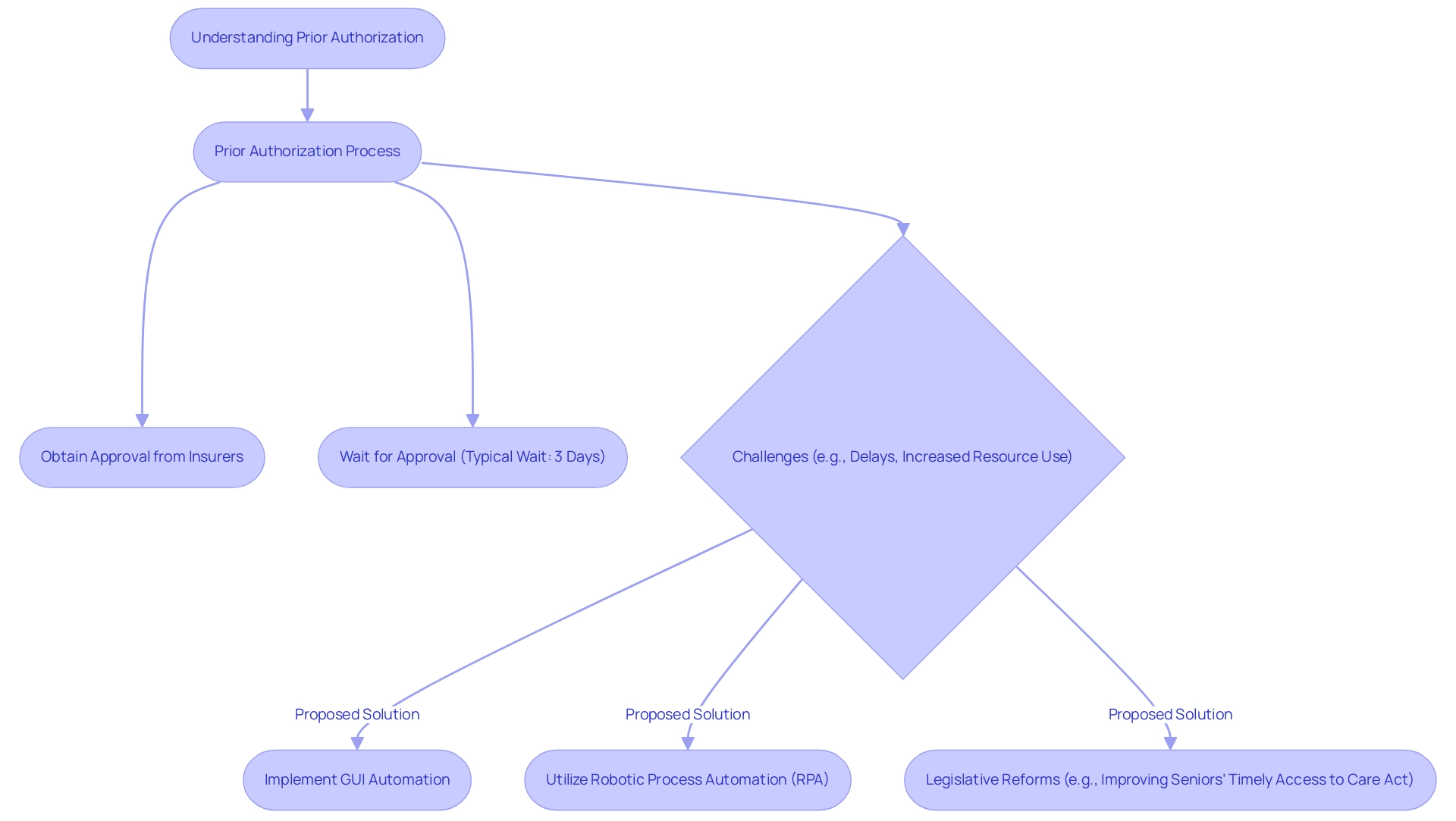
Step-by-Step Guide to Automating Prior Authorization
-
Assess Current Processes: Begin by carefully outlining your existing pre-approval workflows. Identify bottlenecks and common errors, particularly those that require frequent manual intervention. Recognizing these pain points is crucial to understanding where we can automate prior authorization to alleviate the exhaustion caused by repetitive tasks.
-
Define Automation Goals: Set clear, measurable objectives for your automation initiative. Whether your aim is to reduce approval times or minimize the paperwork burden, having defined goals will guide your strategy to automate prior authorization, helping measure success while also addressing the emotional fatigue of your team.
-
Select Automation Tools: Conduct thorough research to identify the right Robotic Process Automation (RPA) tools, such as EMMA RPA and Microsoft Power Automate, that align with your goals. These innovative solutions are designed to enhance efficiency and employee morale by automating repetitive tasks, including the ability to automate prior authorization, and streamlining workflows. Prioritize tools that offer seamless integration with your existing systems, ensuring a smoother transition to automated workflows, which can help modernize outdated systems that hinder operations.
-
Develop Automation Workflows: Design specific automation workflows that detail how tasks will be executed. This includes automating data entry, document submission, and follow-up communications. A well-defined workflow is essential for effective processes that can automate prior authorization and improve efficiency, helping to alleviate the burden of manual tasks on your staff.
-
Test the Automation: Prior to full implementation, engage in pilot testing to validate that your automation solutions function as intended. Use feedback from these tests to make necessary adjustments before scaling up, ensuring that the solutions effectively address the challenges posed by staffing shortages.
-
Train Staff: Equip your team with the necessary training to effectively operate the new automated systems. Ensuring that staff are comfortable with the changes is critical for the success of your automation efforts and can significantly improve employee satisfaction by reducing their workload.
-
Monitor and Optimize: After implementation, it’s essential to continuously oversee the performance of your automated systems. Utilize data-driven insights to automate prior authorization and make ongoing adjustments that enhance efficiency and effectiveness. Recent statistics suggest that 86% of doctors believe that previous approvals result in higher healthcare resource use; therefore, improving your methods can greatly alleviate this challenge, boosting overall workflow efficiency. Moreover, recent administrative measures regarding previous approvals seek to elucidate standards for Medicare Advantage plans and enhance electronic systems, which coincides with your automation objectives. As mentioned by CMS, these changes are aimed at streamlining procedures and reducing provider burdens. Furthermore, grasping the variability in previous approval requests, with Humana having the highest at 2.9 requests per enrollee and Kaiser Permanente the lowest at 0.5, emphasizes the need for customized automation strategies across various medical environments.
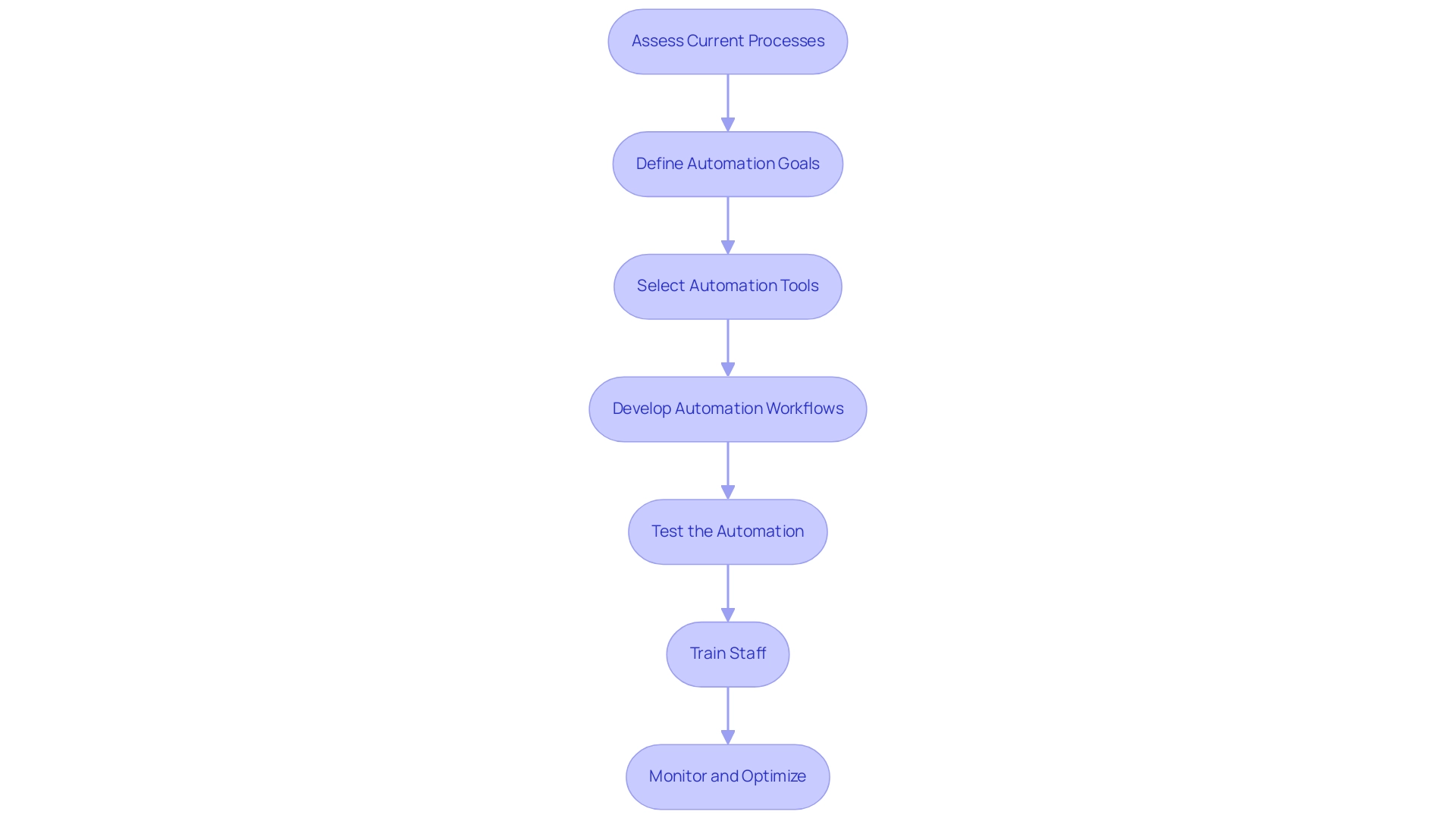
Leveraging Technology: Tools for Automation
A variety of innovative tools is available to streamline and automate the previous approval procedure, significantly enhancing operational efficiency:
-
Robotic Process Automation (RPA): Leading platforms such as UiPath and Automation Anywhere excel at automating repetitive tasks, including data entry and document processing, alleviating the burden on staff. Notably, UiPath raised $1.2 billion and Automation Anywhere secured $840 million in funding, underscoring the growing importance of RPA technologies in the healthcare sector. Our own EMMA RPA provides a user-friendly solution that enhances productivity and employee morale by taking over mundane tasks, allowing your team to focus on higher-value work. EMMA RPA specifically addresses task repetition fatigue and staffing shortages, making it an essential tool for modern operations.
-
Artificial Intelligence (AI): AI-driven solutions revolutionize the handling of incoming requests by analyzing them against predefined eligibility criteria. This capability can reduce processing times by up to 90%, as noted by experts from ClaySys Technologies, who state that RPA can handle up to 90% of data entry tasks in clinical research. Our customized AI solutions, featuring Small Language Models and interactive GenAI Workshops, provide your team with the abilities to utilize AI efficiently in their workflows, enhancing data quality and operational effectiveness.
-
Electronic Health Records (EHR) Systems: Numerous contemporary EHR systems now integrate built-in previous validation features, allowing smooth submission methods directly from patient records, thus minimizing manual entry and mistakes. This integration not only simplifies operations but also improves data precision.
-
Business Intelligence Tools: Using solutions like Tableau or Power BI assists organizations in extracting insights from their previous approval workflows, identifying inefficiencies and uncovering opportunities for enhancement. Our Power BI services guarantee efficient reporting and actionable insights, with a 3-Day Sprint aimed at swiftly producing professionally crafted reports that can inform decision-making.
By adopting these technologies, organizations in the medical field can automate prior authorization, enhance their operational workflows, ensure timely approvals, and improve overall patient care and satisfaction. Additionally, with automation expected to save £17 billion off public sector payments by 2030 compared to 2015, the financial benefits of these innovations are substantial.
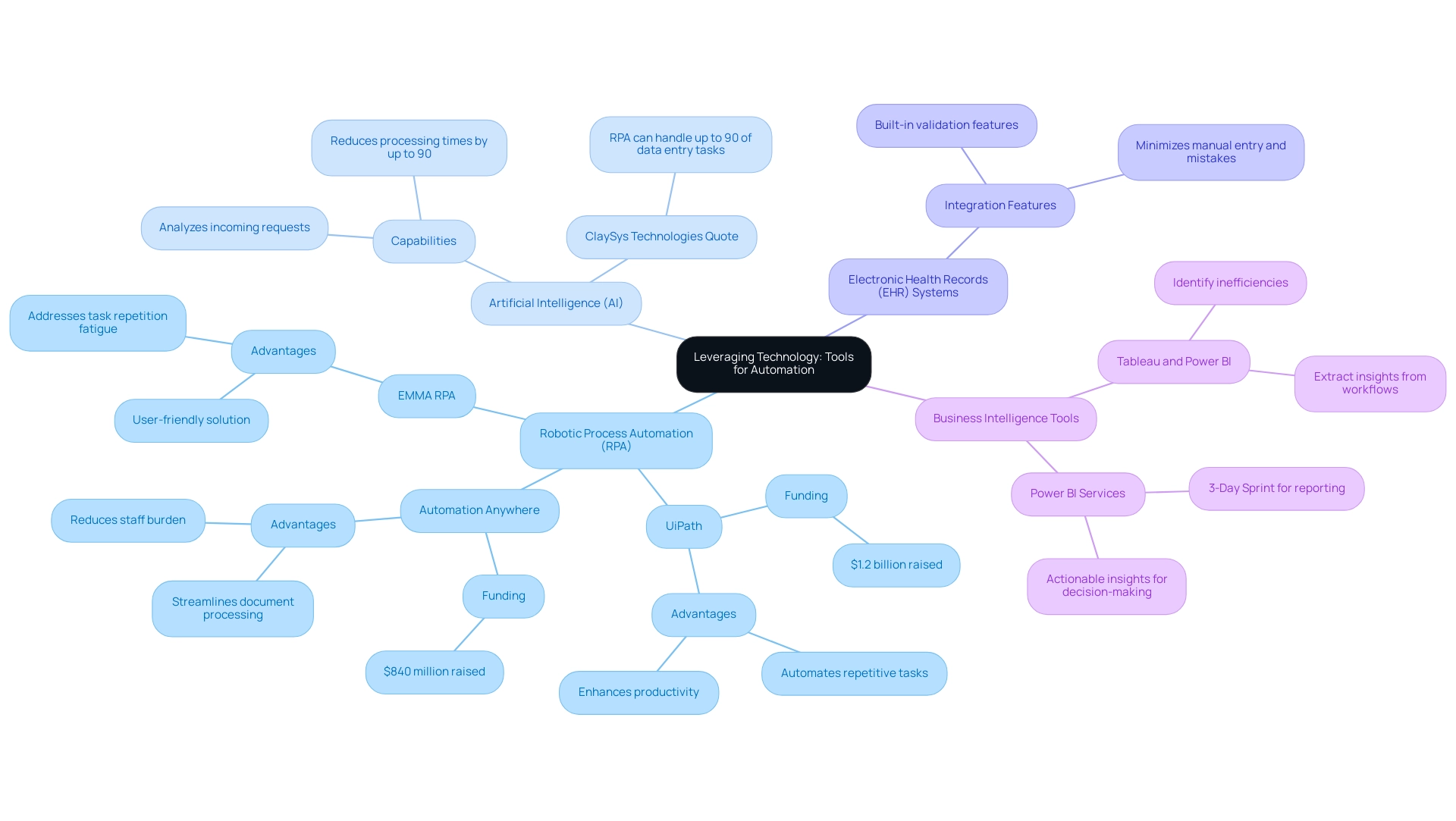
Benefits of Automation: Enhancing Efficiency and Reducing Burdens
Automating the prior authorization procedure offers numerous benefits that can revolutionize medical operations:
- Increased Efficiency: By utilizing Robotic Process Automation (RPA), medical providers can significantly decrease the time dedicated to manual tasks, enabling teams to concentrate on patient care instead of documentation. This shift is essential in today’s fast-paced medical environment, where operational efficiency is paramount.
- Reduced Errors: Automation minimizes human intervention, significantly lowering the risk of errors in data entry and documentation. This leads to more accurate and reliable submissions, ultimately enhancing the quality of care. Alarmingly, 18% of medical professionals report that manual methods have resulted in life-threatening situations or necessitated urgent interventions to prevent lasting damage.
- Enhanced Compliance: Automated systems can be meticulously programmed to meet regulatory standards, ensuring that all necessary documentation complies with current requirements. This proactive approach helps organizations avoid costly fines and maintain their reputations.
- Improved Patient Experience: Streamlined prior authorization processes facilitate faster treatment decisions, greatly enhancing the overall patient experience and satisfaction. When patients obtain prompt approvals, they are more inclined to interact positively with their providers.
- Cost Savings: The decrease of administrative burdens not only lowers operational expenses but also enables organizations to allocate resources more effectively. This strategic reallocation can lead to improved patient outcomes and organizational sustainability.
Moreover, integrating tailored AI solutions alongside RPA can further enhance automation efforts by providing insights that cut through the complexities of the evolving AI landscape. These solutions enable medical organizations to make data-driven decisions, ultimately driving growth and innovation. As emphasized by industry leaders, utilizing automation tools to automate prior authorization and simplify the previous approval workflow is an excellent starting point. With legislative efforts pushing for quicker payer turnaround times, such as those outlined in the case study on ‘Legislative Efforts and Automation Adoption,’ organizations aiming to thrive in the evolving landscape must automate prior authorization as a crucial step. Additionally, instructing participants about the previous approval system and its criteria can greatly enhance comprehension and adherence, further boosting the efficiency of automation in medical services.
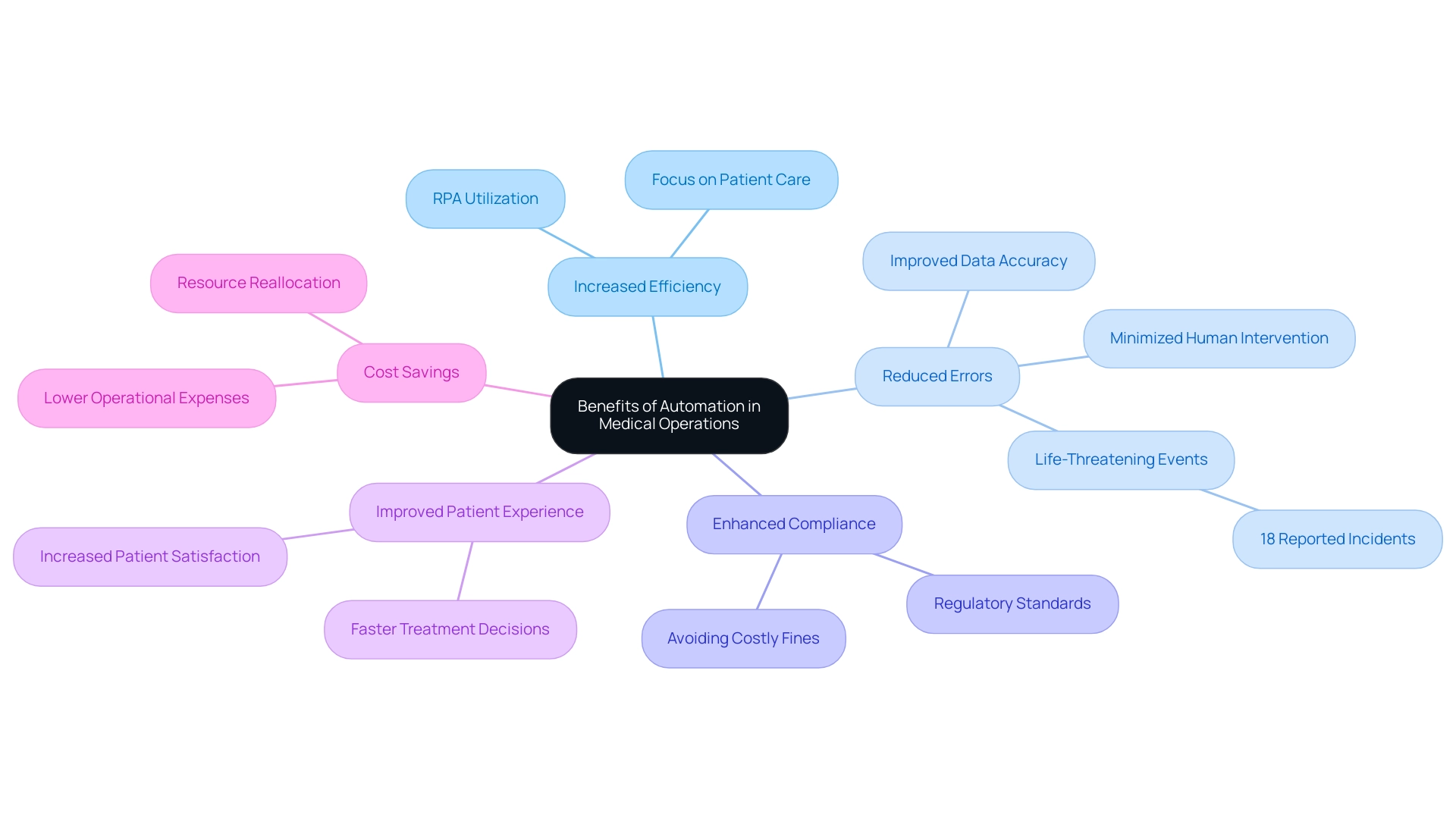
The Future of Prior Authorization: Trends and Predictions
The landscape of prior authorization automation is on the brink of remarkable transformation, driven by several pivotal trends:
-
Increased Integration of AI and RPA: The continuous evolution of AI technologies, alongside Robotic Process Automation (RPA), is set to create a more seamless integration into prior authorization processes. This advancement will not only accelerate decision-making but will also enhance accuracy, ensuring that approvals are timely and precise. The AI in drug discovery market is anticipated to achieve USD 12.8 billion by 2032, with a CAGR of 27.5% from 2023 to 2032, signaling a robust trend towards AI and RPA integration in the medical sector.
-
Data-Driven Decision Making: Organizations are increasingly leveraging analytics and business intelligence to guide their prior authorization strategies. This reliance on data empowers service providers to proactively manage workflows, leading to more efficient operations and better resource allocation, ultimately driving growth and innovation.
-
Enhanced Interoperability: The push for improved interoperability among medical systems is crucial. By enabling smoother data exchanges through RPA, organizations can considerably lessen delays in previous approvals, improving patient care and operational efficiency.
-
Focus on Patient-Centric Solutions: The medical field is progressively shifting towards solutions that prioritize the patient experience. Innovations focused on simplifying previous approval processes are emerging, intended to enhance outcomes and promote a more caring medical delivery model. Notably, 68% of non-users of AI technologies are Gen X or Baby Boomers, highlighting the generational gap in AI adoption that organizations must consider in their patient-centric approaches. Additionally, the case study titled “AI Demographics by Age” illustrates that while 30.8% of individuals aged 61+ use virtual assistants weekly, younger age groups show lower engagement, emphasizing the need for tailored solutions across diverse patient demographics.
Manual, repetitive tasks can significantly slow down operations, leading to wasted time and resources. By leveraging RPA, organizations can automate prior authorization tasks, streamline workflows, and enhance overall efficiency. Specific applications of RPA in previous approvals include automated data entry, real-time status updates, and intelligent document processing, which collectively reduce processing times and enhance accuracy.
By leveraging these trends, particularly the integration of RPA and AI, organizations can effectively position themselves to adapt and flourish in an evolving healthcare environment, harnessing the power of technology to automate prior authorization frameworks.
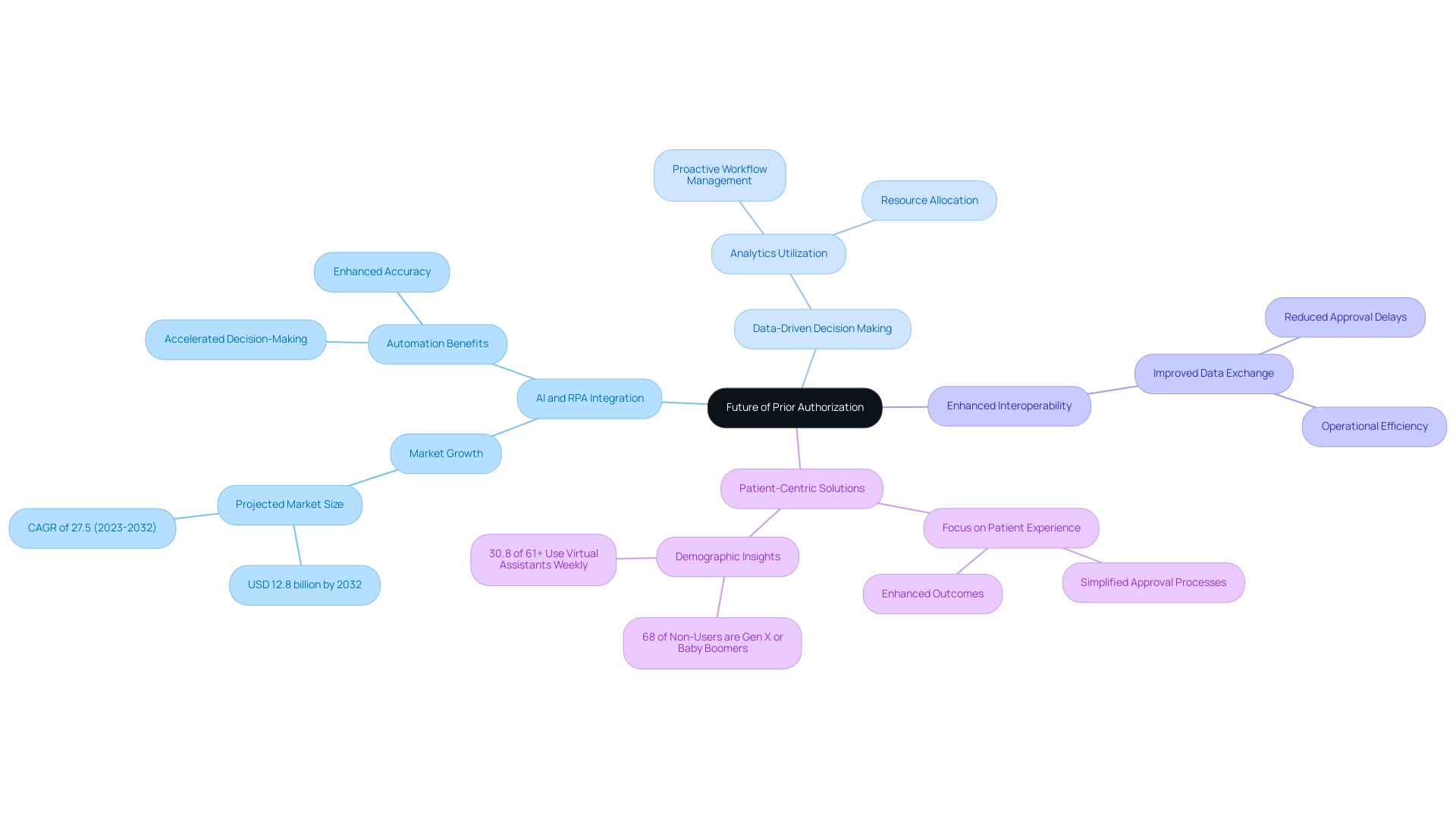
Conclusion
The prior authorization process remains a crucial component of healthcare, ensuring that patients receive necessary treatments while helping insurers manage costs. However, the challenges it presents—such as lengthy wait times and administrative burdens—demand innovative solutions. Embracing automation through Robotic Process Automation (RPA) and Artificial Intelligence (AI) can significantly streamline these processes, enhancing efficiency and reducing errors.
Implementing automation not only alleviates the workload on healthcare providers but also improves patient experiences by expediting treatment decisions. By carefully assessing current workflows, defining clear automation goals, and selecting the right tools, healthcare organizations can create a more efficient prior authorization process. The integration of AI and RPA is essential for driving data-driven decision-making and enhancing operational workflows, ultimately leading to better resource allocation and patient outcomes.
As the healthcare landscape evolves, the push for automation in prior authorization is not just a trend but a necessary step toward a more efficient and patient-centric system. By leveraging technology to reduce delays and improve compliance, healthcare organizations can position themselves for success in a rapidly changing environment. Embracing these solutions will not only enhance operational efficiency but also foster a healthcare delivery model that prioritizes timely care and patient satisfaction. The future of healthcare relies on the ability to adapt and innovate, making automation a vital investment for organizations aiming to thrive in this landscape.
Introduction
In the insurance industry, the landscape of operational efficiency is undergoing a profound transformation, driven by the strategic implementation of Business Process Management (BPM). As organizations grapple with the complexities of modern workflows, BPM emerges as a powerful tool that not only streamlines processes but also enhances compliance and customer satisfaction.
With the rise of low-code solutions and automation technologies like Robotic Process Automation (RPA), insurance companies are equipped to tackle repetitive tasks and inefficiencies head-on. This article delves into the essential components of BPM, the challenges faced during implementation, and the future trends that promise to redefine operational excellence in the sector.
By embracing these advancements, insurers can position themselves to meet the evolving demands of their customers while achieving significant cost reductions and improved service delivery.
Defining Business Process Management (BPM) in Insurance
Business Process Management (BPM) in the financial sector is described as a systematic method focused on improving and overseeing the overall procedures that support insurance bpm. This encompasses critical functions such as:
- Policy issuance
- Claims processing
- Underwriting
- Customer service
Insurance BPM combines various methodologies, tools, and practices that allow companies in the insurance sector to analyze, design, execute, monitor, and enhance their workflows efficiently, including innovative Robotic Process Automation (RPA) solutions such as EMMA RPA and Microsoft Power Automate.
EMMA RPA specifically addresses task repetition fatigue by automating mundane tasks, allowing employees to focus on more strategic and value-adding work, while Power Automate streamlines workflows and ensures a risk-free ROI assessment through professional execution. The importance of insurance bpm is highlighted by its ability to improve efficiency, ensure compliance, and align with strategic objectives. This alignment elevates the customer experience while contributing to substantial cost reductions.
With an anticipated compound annual growth rate (CAGR) of 8.6% for the coverage services outsourcing market from 2024 to 2033, organizations are increasingly acknowledging BPM as a strategic resource for enhancement. Notably, Gartner anticipates that by 2025, low-code technology will drive over 70% of process management applications, a significant leap from less than 25% in 2020. This transition towards low-code solutions indicates an increasing need for user-friendly and integrated BPM systems, essential for improving efficiency within the sector.
Moreover, the banking, financial services, and risk management (BFSI) sector has the highest BPM adoption rate, with a market size of 35.6%, underscoring the significance and integration of insurance BPM methodologies alongside RPA and Business Intelligence in driving data-driven insights and efficiency for business growth.
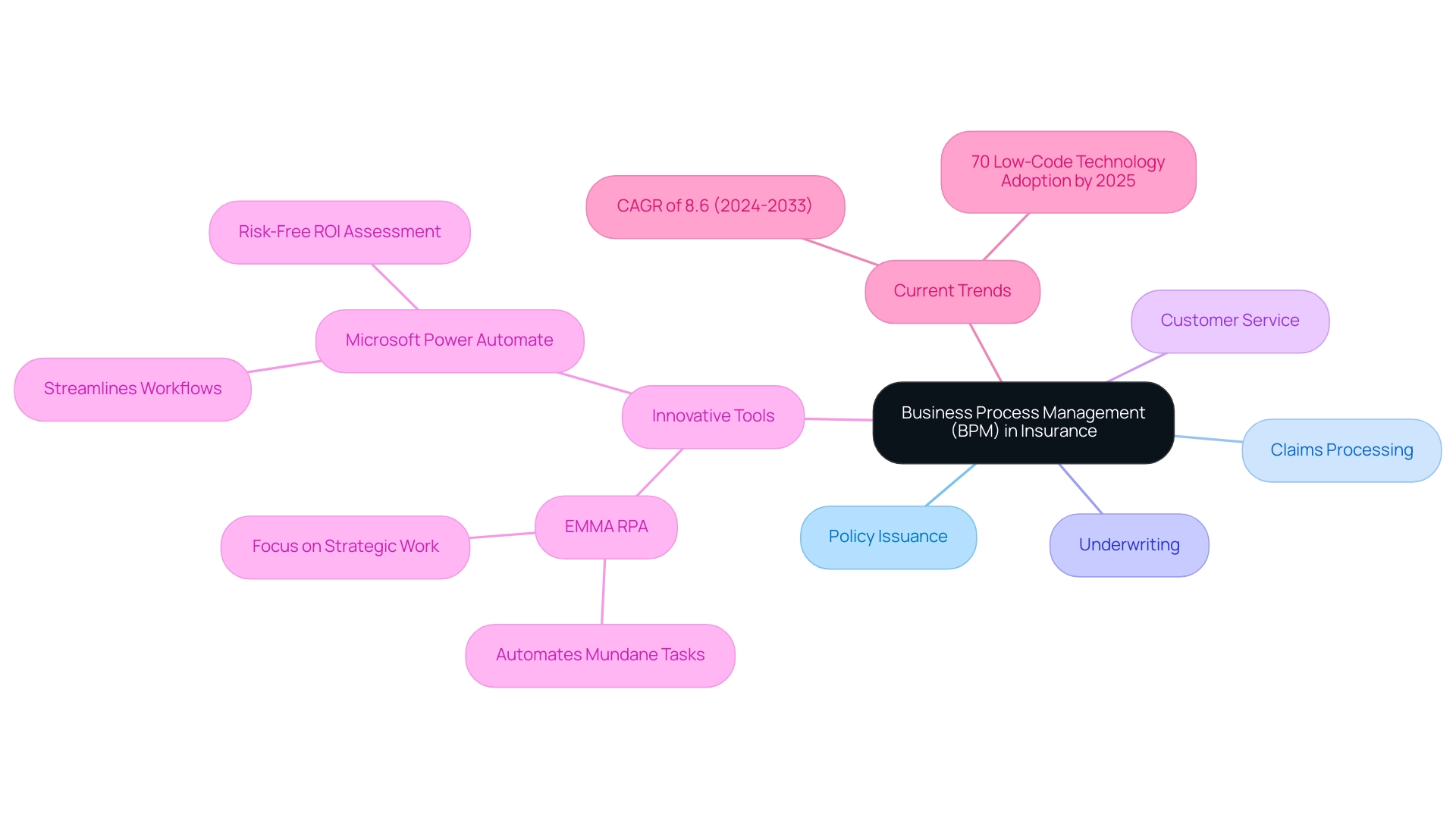
The Importance of BPM for Operational Efficiency and Compliance in Insurance
Business Process Management (BPM) is crucial for enhancing operational efficiency and ensuring compliance in the insurance bpm industry. With the rapid evolution of technology, especially the rise of low-code solutions—which, according to Gartner, will represent over 70% of management applications by 2025—insurance bpm provides companies with unprecedented opportunities to streamline their operations. A compelling example is illustrated by a mid-sized company that implemented GUI automation, overcoming challenges such as manual data entry errors and slow software testing.
This implementation not only resulted in a 70% reduction in data entry errors and a 50% acceleration in testing activities but also achieved a return on investment (ROI) within six months, underscoring the effectiveness of the solution. By standardizing procedures, organizations can effectively reduce redundancies and minimize errors, resulting in faster turnaround times for both policy issuance and claims handling. In the claims management system, insurance bpm can automate workflows by integrating multiple information sources, accelerating claims resolution and providing real-time updates to customers, fostering trust and enhancing satisfaction.
Furthermore, insurance bpm provides a robust framework for documenting processes, which is essential for adhering to stringent regulatory requirements in the sector. Beyond insurance, BPM solutions are also vital in complex fields like banking and electrophysiology, where high expertise and precision are required for optimal management efficiency. Companies leveraging Robotic Process Automation (RPA) and tailored AI solutions can achieve operational excellence, transforming raw data into actionable insights that drive informed decision-making.
By embracing these smart BPM solutions, organizations can build reliable and transparent systems that resonate with customer expectations and regulatory demands.
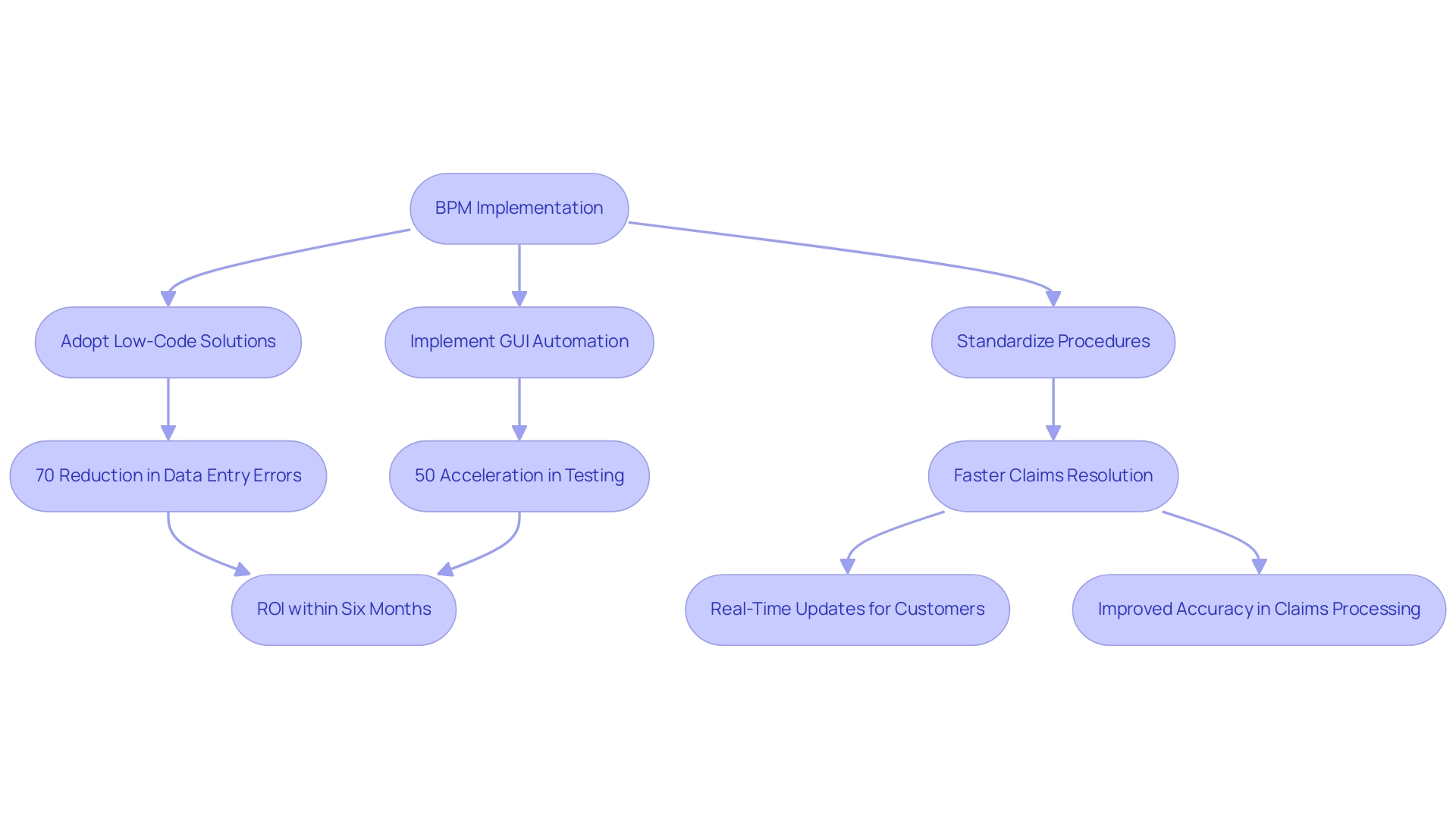
Key Components of BPM in Insurance
The foundational components of Business Activity Management (BPM) in the financial sector include:
- Modeling
- Automation
- Performance monitoring
- Continuous enhancement
Process modeling involves a thorough mapping of existing workflows to identify inefficiencies and opportunities for enhancement. This critical step enables organizations to visualize their operations, ensuring that no potential improvements are overlooked.
Significantly, 72% of business leaders in Europe attribute their business management efforts to improved customer satisfaction rates, highlighting the importance of insurance BPM in enhancing customer experiences. Automation, particularly through Robotic Process Automation (RPA) solutions like EMMA RPA and Microsoft Power Automate, plays a pivotal role in streamlining repetitive tasks while also addressing staffing shortages and outdated systems. By alleviating the burden of monotonous tasks, these solutions not only minimize human error but also significantly improve employee morale, as workers can focus on more meaningful and engaging activities.
In fact, 50% of organizations recognize that automation accelerates task completion, thereby enhancing overall operational efficiency. A practical example of insurance BPM in action can be observed in the case study titled ‘Executing the Underwriting Process,’ where the integration of automation solutions resulted in a unified data system that offers real-time access to information and improved policy pricing. Key features of EMMA RPA include its user-friendly interface that simplifies automation setup, while Microsoft Power Automate provides seamless integration with existing workflows to enhance productivity.
Performance monitoring is vital in this framework; utilizing key performance indicators (KPIs) and metrics enables a clear evaluation of effectiveness. Continuous improvement guarantees that systems are regularly refined based on real-time feedback and data analysis, fostering an agile environment. Furthermore, FBSPL’s coverage business process outsourcing services offer economical solutions that optimize efficiency and improve customer experience.
Collectively, these components establish a resilient insurance BPM framework that empowers firms to adapt swiftly to evolving market conditions and meet growing customer expectations, while also addressing the emotional and operational challenges posed by repetitive tasks.
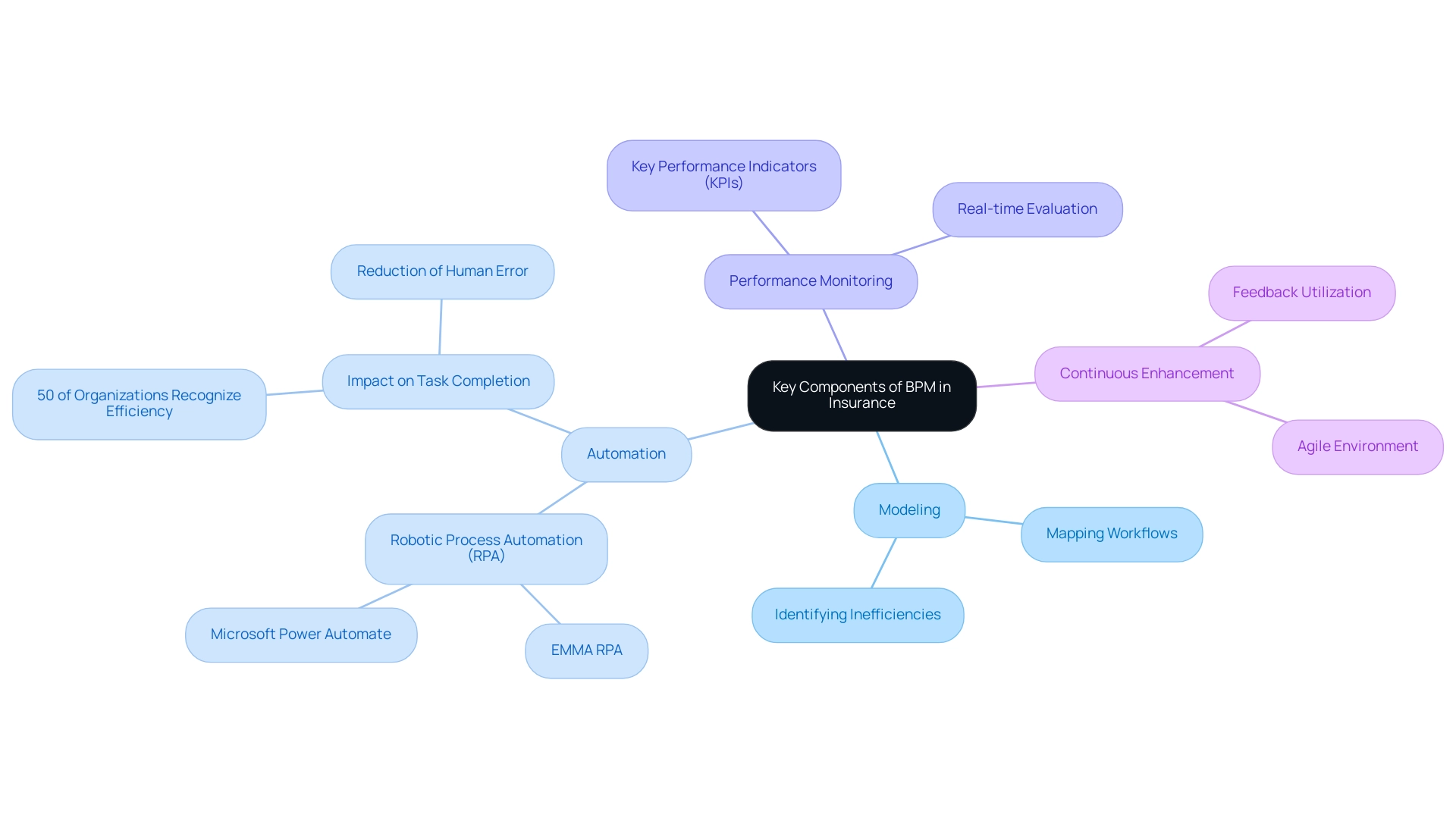
Challenges in Implementing BPM in Insurance
Implementing insurance BPM in the insurance sector presents several significant challenges. According to recent insights, employee resistance to change emerges as a primary obstacle, often fueled by fears of job displacement due to automation or concerns that new processes may lead to increased workloads. Furthermore, the lack of executive buy-in and insufficient training can hinder progress.
A report by Everest Group states that 40% of organizations are actively investing in AI-powered insurance BPM solutions to enhance efficiency, signaling a shift towards embracing these technologies. The rapidly evolving landscape of Robotic Process Automation (RPA) and tailored AI solutions can alleviate these concerns by streamlining manual workflows, reducing errors, and empowering teams to focus on more strategic tasks. Moreover, Business Intelligence plays a crucial role in transforming raw data into actionable insights, enabling informed decision-making that drives growth and innovation.
The BPM market, valued at 3.38 billion in 2020, is projected to grow to 4.78 billion by 2026, particularly in the insurance BPM sector, driven by the BFSI industry, underscoring the relevance of BPM in today’s market. To overcome these hurdles, it is vital to:
- Engage stakeholders early in the BPM initiative.
- Clearly communicate the benefits of BPM and RPA.
- Provide comprehensive training and support.
Approaches like encouraging an open conversation regarding the changes, tackling employee issues directly, and obtaining executive support are essential, as they promote a cultural shift that positions BPM as a strategic priority instead of just a simple adjustment.
By proactively tackling these challenges, providers can foster an atmosphere favorable to successful BPM implementation, ultimately improving their efficiency and customer service. For instance, Aviva Insurance, which serves 33 million customers, achieved remarkable results through insurance BPM implementation, realizing customer service improvements that were nine times faster. This case exemplifies the transformative potential of BPM, RPA, and AI when effectively managed.
Tailored AI solutions can further enhance BPM efforts by addressing specific business challenges, ensuring that organizations are well-equipped to navigate the complexities of the modern landscape.
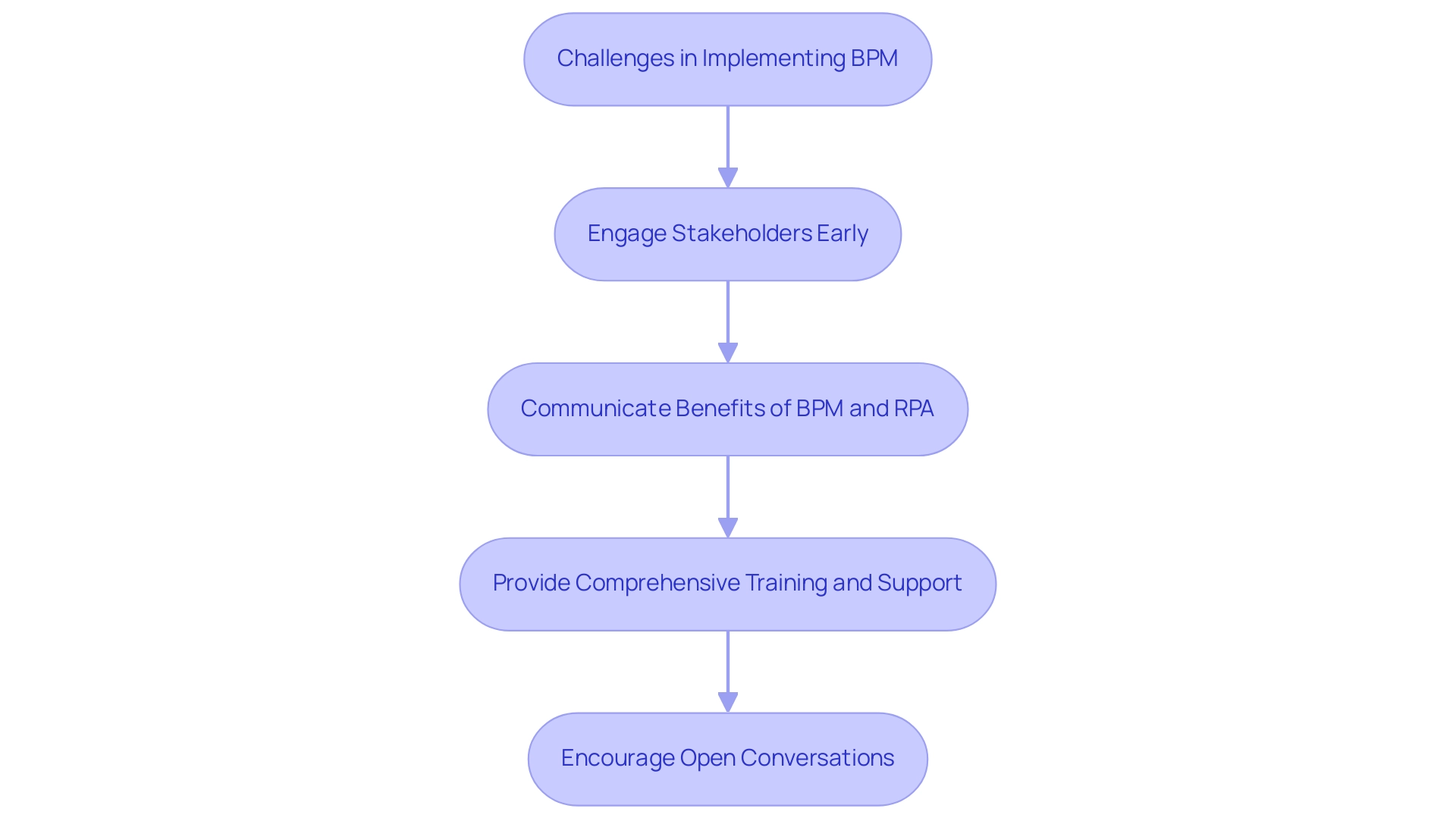
Future Trends in BPM for the Insurance Industry
The evolution of Business Process Management (BPM) within the insurance sector is on the brink of a significant transformation, driven by cutting-edge technological advancements in insurance BPM. Key trends, including artificial intelligence (AI), machine learning, and advanced analytics, are set to revolutionize BPM capabilities. Manual, repetitive tasks can significantly slow down operations, leading to wasted time and resources.
However, utilizing Robotic Process Automation (RPA) can automate these workflows, significantly improving efficiency in a rapidly evolving AI landscape. AI plays a crucial role in enhancing decision-making processes by effectively analyzing extensive datasets to uncover patterns and forecast outcomes. Meanwhile, machine learning continuously refines workflows by learning from functional data, leading to increased efficiency.
Furthermore, the integration of BPM with cloud technologies promises heightened flexibility and scalability, empowering insurance firms to swiftly adapt to shifting market dynamics in insurance BPM. A significant instance of this is the case analysis on Green BPM, which incorporates sustainability into business activities, encouraging eco-friendly practices while preserving efficiency. This approach not only reduces waste and energy consumption but also enhances corporate social responsibility profiles, making it a standard business practice in the industry.
By embracing these innovations, insurers position themselves for competitive advantage and enhance their insurance BPM to better respond to evolving customer expectations in a rapidly digitizing landscape. As Christopher Groenne, a product strategy consultant, aptly noted,
In 2025, workflow discovery will be pivotal in uncovering inefficiencies and continuously optimizing workflows.
This innovative strategy highlights the necessity for leaders in the field to utilize advanced process mining tools, customized AI solutions, and RPA technologies within insurance BPM, promoting data-driven decisions that improve efficiency and customer satisfaction.
Moreover, generative AI encourages innovation by stimulating creativity and generating new ideas, especially when traditional thinking has plateaued, further emphasizing the importance of these technological advancements in shaping the future of BPM in the insurance BPM sector. For more insights, refer to our latest publication on enhancing operational efficiency through RPA and AI solutions.

Conclusion
The integration of Business Process Management (BPM) in the insurance sector is not merely a trend; it represents a strategic shift towards enhanced operational efficiency and compliance. By systematically analyzing and optimizing processes like policy issuance and claims management, insurance companies can significantly reduce redundancies and errors, ultimately leading to improved customer satisfaction. The rise of low-code solutions and RPA technologies empowers organizations to automate repetitive tasks, allowing employees to focus on more strategic initiatives that add value to the business.
Challenges such as employee resistance and the need for executive buy-in can complicate BPM implementation. However, by fostering a culture of openness and providing robust training, organizations can overcome these hurdles. Engaging stakeholders early in the process and clearly communicating the benefits of BPM can facilitate a smoother transition and enhance the overall effectiveness of the initiative.
Looking to the future, the convergence of AI, machine learning, and advanced analytics will further transform BPM capabilities in the insurance industry. This evolution not only promises to streamline operations but also enables insurers to respond swiftly to changing market dynamics and customer expectations. By embracing these technological advancements, organizations can position themselves for sustainable growth and operational excellence, ensuring they remain competitive in an ever-evolving landscape.
